
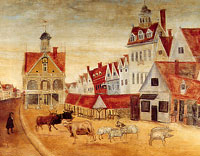
Market Hill c. 1700
Quick links on this page
First Suffolk turnpikes 1711
River Lark canalised 1716
Trial of Arundel Coke 1722
Kirby's Suffolk Traveller 1735
Bury to London same day 1737
Downing's map of Bury 1741
Warren's map of Bury 1748
The modern calendar 1752
New butchers' shambles 1761
Turnpike to Newmarket 1770
Warren's updated map 1776
Godfrey's East Prospect of Abbey 1779
Fornham Park enclosed 1782
The French Revolution 1789
Napoleonic Wars begin 1793
End of Bury wool trade 1800
Richard Yates's Antiquities 1805
Buck & Greene brewers 1806
Suffolk livestock 1810
Foot of Page 1812
|
The Eighteenth Century
and Napoleonic Wars
From 1700 to 1812
Pre-
1700
|
Please click here if you wish to view events leading up to 1700.
|
|
1700 |
By the end of the 18th century the Guildhall Feoffees had built a Dispensary in Angel Lane to provide out-patient care to the poor of Bury.
In Haverhill as the seventeenth century gave place to the eighteenth, weaving began to expand in the town, no doubt as a result of the influence of Flemish Huguenot refugees who had settled in the eastern counties late in the seventeenth century, following the French King Louis XIV's revocation of the Edict of Nantes. In 1685 Louis decided to outlaw Protestantism in France, which had been tolerated in selected cities since the Edict of Nantes in 1598. After he revoked the Edict, Protestants were persecuted in France, and hundreds of thousands went abroad. About 50,000 came to England.
The year began with one of the coldest winters on record. Freezing NNE winds continued to blow through April and May.
|
|
1701
|
The Reverend John Beart became pastor of the Independent Congregation in Bury St Edmunds. He continued to take the Independent cause to Chevington and the villages south of Bury. Sir Thomas Felton replaced Sir Robert Davers as Bury's second MP, but within a year Davers was back to replace John Hervey when Hervey became a peer.
By 1701 Parliament had become desperately worried about the future of the monarchy. William and Mary had produced no heirs. Although Mary's sister, Anne, could succeed to the throne, she had also failed to produce an heir who had survived beyond childhood. In order to settle this issue in advance, Parliament passed the Act of Settlement of 1701. This Act settled the succession to the English and Irish crowns and thrones on the Electress Sophia of Hanover (a granddaughter of James I) and her non-Roman Catholic heirs. The other surviving Stuarts were all Roman Catholics, and they were excluded by this Act.
|
|
1702
|
In 1689, following the "Glorious Revolution", the throne was offered to William and Mary, who became William III and Mary II. Queen Mary had died of smallpox in 1694, leaving William to reign alone until 1702.
In March, 1702, King William III died, and Queen Anne came to the throne on 8th March. Queen Anne, like her predecessor Queen Mary II, was a daughter of James II, who had fled the country in 1688. The new Queen was in ill health, having suffered over a dozen miscarriages and stillbirths, and being afflicted by a gout like symptoms. Anne was crowned on St George's Day, 23 April 1702, but had to be carried there in a sedan chair.
One of Bury's two MP's, John Hervey, was created a Baron on the succession of Queen Anne. Once elevated to the House of Lords, he ceased to be Bury's MP. By now, Suffolk was dominated by the Tory party who controlled both County parliamentary seats. Notable local Tories were Sir Robert Davers of Rushbrooke and Sir Thomas Hanmer of Mildenhall. John Hervey MP was replaced by Sir Robert Davers.
John Hervey had been a regular visitor to Newmarket from 1690, and into the 1700s to attend the races and for all forms of gambling. Like other well to do men, he liked to enter the court circuit whenever royalty was in town.
The house now called Angel Corner was built on the Angel Hill in Bury.
There had been a ditch in front of the abbey gate for drainage purposes for many years. Some writers had even called it Canute's Ditch. There is evidence that the ditch was still there in 1702, and that the lower part of the Angel Hill was lower than it is now.
In Edmund Gillingwater's "Historical and Descriptive Account of St Edmundsbury" of 1804, he claimed that "The ditch was open at the beginning of the last century". By 1804 he wrote that "The whole of the Angel-hill appears to have been raised and levelled by filling up the ditch near the Abbey-gate, where the ground was so low, that people ascended the houses on the opposite side, by several steps. The ground near the gate is now much raised, it is said three feet."
|
|
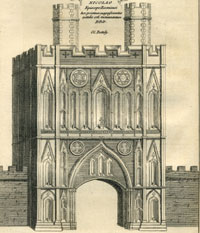 Abbey Gate early 18th century
Abbey Gate early 18th century
|
|
1703
|
One of the two Bury MP's, Sir Robert Davers, bought the manor of Rushbrooke.The estate included Little Welnetham. He owned sugar plantations in Barbados, planted by the first Robert Davers from 1635 onwards. Despite his wealth, he seems to have been unable to read and write, having been brought up to run the slaves on the plantation. He continued as an MP and died in 1722.
The other Bury MP, John Hervey, had just been created a Baron on the succession of Queen Anne. In March 1703 he received his letters patent and the motto "je n'oublieray jamais". Once elevated to the House of Lords, he ceased to be Bury's MP, and was replaced by Sir Robert Davers.
Baron Hervey would not be made 1st Earl of Bristol for another eleven years, and at this time the family lived in the old Ickworth Manor House, which was located just south of the Ickworth Church. To complement the house he built the Summer House and Walled Garden which still stands overlooking the Canal, which he also had constructed, by digging out the valley of the tiny River Linnet, and damming it up.
The old Manor House dated back to the 15th or 16th centuries, and at this time he probably intended to have it rebuilt on or near this site.
On the night of 26th and 27th of November, 1703, came the worst storm to hit Britain in recorded history. It was worse than the storms of October 1987, and more destructive than the East Coast floods of 1953.
The turrets over the stairs at the Abbey Gate seem to have fallen, and been removed, in the early 18th century. Some of the damage may have arisen during this storm, although this is a speculation at present.
There were estimated to be 8,000 deaths across the country as church steeples fell, and cottage roofs blew away. Windmills caught fire as the sails spun causing such friction as to generate great heat. Winds of over 90 mph were experienced in East Anglia.
Kings College Chapel was badly damaged, as were many other churches. Defoe claimed that lead had been torn from the roofs of 100 churches.
Things were worse at sea. Hundreds drowned off the coast of Norfolk and Suffolk. Some 8,000 sailors in the British fleet were drowned, as hundreds of vessels sank, including four Men-of War.
In 1703 the Drury family lived at Wrigglesworth Hall, near Thetford. Here a chimney fell in and killed Lady Drury, also known as Dame Eleanor Drury.
|
|
1704
|
In medieval times the practice of giving one tenth of the production of agricultural produce to the church had already been well established. Monasteries erected tithe barns to hold the grain, and much of this had supported the clergy as well as some being redistributed to the poor. By 1547 King Henry VIII had confiscated the payment of tithes to the catholic church, and often had sold the rights to new lay landowners or "lay impropriators". What was left was payable to the Church of England. Various means arose over the years to avoid church tithes, and the result of all this was that by 1704 most country parsons were left with only a very small income, while the right to tithes were seen to profit already wealthy landowners.
Gilbert Burnett, the Bishop of Salisbury, persuaded Queen Anne that help was needed, and this resulted in 'Queen Anne's Bounty for the Augmentation of the Maintenance of the Poor Clergy.' All the royal revenues from First Fruits and Tenths would be paid to the clergy.
This act would reignite the enforcement, and the resistance to, tithe payments right up to the late 20th century.
|
|
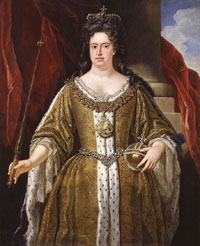 Queen Anne 1702-1714
Queen Anne 1702-1714
|
|
1705
|
About this time the first Congregationalist Chapel was dedicated in Whiting Street, Bury St Edmunds. Before this time, members mostly met in private houses, and it is likely that the chapel was an adapted house. A proper purpose built church had to wait another ten years.
There was a General Election and Suffolk again produced a majority of Tory MP's. In 1705, eleven of the Suffolk MP's out of sixteen were Tory. This seems to be a turn around from the days of 1640 to 1660 when Suffolk was radically puritan and anti-establishment. In 1679 Suffolk returned mostly Whig MP's but by 1705 former parliamentarians were now high Tories such as Thomas Bright of Pakenham. Other former parliamentarians were now Tory MP's in Suffolk like Sir Edmund Bacon MP, Sir Charles Blois MP and John Bence MP.
In 1705, Queen Anne made her first visit to stay at the palace in Newmarket since becoming Queen. Her stay was for 11 days over the Easter period, from April 10th to the 20th. Her visits to church, and to view the races, had to be carried out by way of her sedan chair, because her mobility was restricted by illness.
She also ordered a small extension to be built on to the Newmarket Palace for her own apartments, with a bedroom and dressing room decorated to her own taste.
She became very popular with the people, as well as with the clergy. During her stay at Newmarket she received a petition from the Newmarket clergy thanking her for her benificence in providing Queen Anne's Bounty, a payment to poor clergy begun in 1704. She also gave a sum of £1,000 to provide for paving the streets of Newmarket during the same visit.
|
|
1706
|
In 1706 the manor of Great Barton was sold to Thomas Folkes, a lawyer from Bury St Edmunds. The previous owners were the Audley family, who had held great Barton since 1553. Folkes's daughter, Elizabeth, would inherit the estate. In 1724 she would marry Sir Thomas Hanmer, and he would eventually leave it to his nephew, the Reverend Sir William Bunbury.
In 1706 Queen Anne passed another 11 days at Newmarket, from October 2nd to the 12th. During this visit she was attended by the court, as usual, together with George, the son of Sophia of Hanover. George was appointed the Duke of Cambridge at this time, to emphasise the fact that he was now second in line to the throne of England and Ireland, after his mother, Sophia.
Queen Anne would only make one further visit to Newmarket in 1707.
|
|
1707
|
The Act of Union joined England and Scotland, ensuring that Scotland could not install a rival Stuart as King upon Queen Anne's demise. This meant that after Queen Anne's death, Scotland would also be subject to the 1701 Act of Settlement.
In Bury there were a series of about five separate fires in the centre of town between 1702 and 1707, around the Churchgate area. Luckily the Presbyterian Meeting House in Churchgate Street was unscathed, although it would be rebuilt in 1711.
In 1707, the "Fundamental and Standing Rules and Orders for the Charity Schools in St EdmundsBury in Suffolk", were published. These began "Whereas several schools have been lately set up and established by the voluntary subscriptions of charitable and well disposed persons in the several parishes of this town, for instructing poor children, whose parents are not able to afford them education, and for qualifying them to get their living; and for as much as good government conduces to those ends, the following Rules and Orders are by the said subscribers directed and appointed to be observed."
The boys wore green caps and neckcloths, the girls wore Dolphins with green worsted or taffety. Only Thursday afternoons could be for play, but this was "by no means to be grant(ed) too frequently". They would break up three times a year at the usual festivals, "and so by no means at Bury Fair, beginning on the Festival of St Matthew."
Queen Ann had cancelled her planned Easter visit to Newmarket in 1707, but from 30th September to 17th October, she managed an 18 day stay. This was to be her last visit to Newmarket before her death in 1714.
|
|
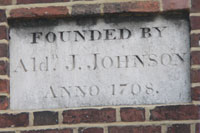 Northgate Street
Northgate Street
|
|
1708
|
By this time Suffolk had become a Tory electoral stronghold. One exception was the election of 1708, when a Whig majority won in Suffolk. There had been an abortive Jacobite rising in Scotland, and the resulting wave of anti-Jacobite feeling caused the Whig majority.
This was an aberration as the other four elections under Queen Anne were Tory wins in Suffolk.
|
|
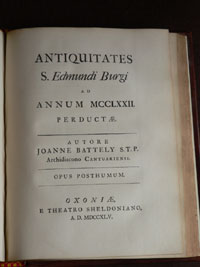
Title page to Battely's 'Antiquities'
|
|
blank |
Dr John Battely had lived from 1646 to 1708, and was born and educated at Bury , eventually becoming Archdeacon of Canterbury. He was the son of an apothecary in Bury St Edmunds, and had two brothers, Nicholas and Thomas. All the boys attended the King Edward VI Grammar School at Bury and then Trinity College, Cambridge. John became Chaplain to the Archbishop of Canterbury, and then Archdeacon of Suffolk. In 1688 he became Archdeacon of Canterbury. He owned a house and an estate at Chevington which was left to him by his Godfather.
During his lifetime he wrote the first history of Bury St Edmunds, but it had never been published. His Opera Posthuma or Posthumous Works of John Battely would not be published until 1745.
When he died he left the estate to his brother Charles, but the income from the farm was to go to "the benefit of the poor of St Edmundsbury as are of good life and honest frame conformable to the Church of England as now by law established."
The house survives today in Depden lane, Chevington, and is known as "Batley's," but before the 1930's was known as Hole Farm.
At Rushbrook Hall, the Jermyn male line came to an end with the death of Henry, third Lord Jermyn. Henry had succeeded his brother Thomas as 3rd Baron Jermyn in 1703, and died in 1708. As he left no children by his wife, Judith, daughter of Sir Edmund Poley, of Badley, Suffolk, his titles became extinct at his death.
The eldest daughter of Thomas Jermyn had married Sir Robert Davers of Rougham. The Davers family had made a fortune in Barbados, and Sir Robert decided to buy up the remaining Rushbrooke interests of his wife's four sisters. His second son was named Jermyn Davers, and when he became the fourth baronet, he would be responsible for greatly enhancing the Rushbrook property.
|
|
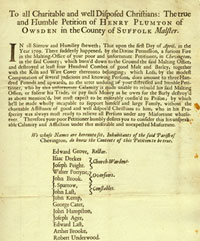 Henry Plumton's petition
Henry Plumton's petition
|
|
1709
|
Malting barley has been a local industry for centuries. It depends upon sprouting barley to generate natural sugars, but it must then be heated to prevent the growth process from consuming all the sugar. This heating has often resulted in fires breaking out within the maltings buildings. One such incident is shown here.
The illustration is of a printed petition of Henry Plumton of Ousden, Suffolk, although here it is spelled Owsden. He is requesting charitable assistance after a fire destroyed his maltings at Chevington and 'at least four hundred combes of good malt and barley'.
Plumton had lost not only his own business, but had also not paid for the barley which was destroyed. He estimated his loss at £300, and would be imprisoned if he could not raise the money. A list of locally prominent people attested to his loss in the petition.
Arundell Coke owned the manors of Murrells at Little Livermere, and Broom Hall at Great Livermere. In 1709, Coke sold the combined estates of 2,000 acres to Thomas Lee of Kensington, for £7,500. The sale encompassed the manors of Murrells, Broom Hall, 15 messuages, 2 dove houses, 6 gardens, 6 orchards, 600 acres of (arable?) land, 100 acres of meadow, 250 acres of pasture, 1,200 acres of heath, and the advowson, or living, of Little Livermere church. Lee's family had also owned Lawshall since well before 1605, when Sir Robert Lee, former Lord Mayor of London, left it in his will.
|
|
1710
|
The Manor House at Ickworth, standing to the south west of Ickworth Church was demolished. Before the Hervey Family moved out they had fitted out one of the best of the estate farmhouses to be a temporary home. This farmhouse became called Ickworth Lodge and is still in existence today. It was also useful that it was out of sight of the demolition work and intended rebuild on the Manor House.
John, the Baron Hervey, probably intended to build his new house near the old site, as his walled garden, summerhouse and canal were already there, but this never happened. The family would remain at Ickworth Lodge until the great Ickworth House was finally completed in 1829, after several more generations.
The reason for this is unknown but it is suggested that money became short because of the profligacy of his many sons. In any event after he married his second wife, he would build her the new Manor House in Schoolhall Street in Bury, and less time was spent at Ickworth.
Holy Trinity Church at Long Melford is one of the great Suffolk wool churches and was built almost entirely in the 15th century at a time of growing prosperity among the local cloth merchants. Around 1710 the tower was struck by lightning and had to be demolished. It would be replaced by a brick built tower of a classical style in 1725.
Although Queen Anne had not been at Newmarket since 1707, in 1710 she endowed the sum of £50 a year to provide two schools in that town. These were to be for 20 boys and 20 girls to learn to read and write, cast accounts, and for the knowledge and practice of the Christian Religion. The school seems to have been set up in St Mary's church, which still apparently receives annual donations from the Queen today.
|
|
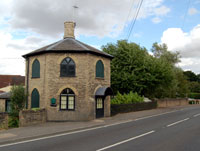 Sicklesmere Toll Bar built c1762
Sicklesmere Toll Bar built c1762
|
|
1711
|
In 1555 each parish was given the responsibility for the upkeep of roads within its area. This system was bound to fail as traffic exceeded their ability to meet the ever rising costs of maintenance. In 1663 a Turnpike Authority was set up on part of the Great North Road, and after 1706 other trusts were set up.
The first Turnpike Trust in Suffolk took over the Ipswich to Scole road in 1711 and 1712, and at least part of the Ipswich to Bury road, as far as Stowmarket. It is not always possible to tell exactly when a road was "turnpiked", and this uncertainty applies to the Stowmarket to Bury Stretch of this road. Other roads to and from Bury were not turnpiked for another 50 years, the next being Bury to Sudbury in 1762.
The Trust would undertake to improve the designated road and to properly maintain it. In return the Trust could recover its costs by levying a toll on the road users. The toll was collected at tollbars located at strategic points along the route.
Meanwhile, Henry Ashley was dredging the River Lark, and building locks and staunches, in order to turn it into a commercial navigable waterway. Old established wooden bridges had to be raised in order to allow the passage of barges beneath them. By 1711 Ashley was working at Temple Bridge at Icklingham. However, he was often at the mercy of local landowners. Temple Bridge had existed in various forms for several hundred years, and the maintenance of it was shared between the adjoining estates by long precedent.
Ashley not only paid for the newly raised bridge himself, but had to agree to bear half of the costs of future maintenance before they would allow him to touch the bridge.
|
|
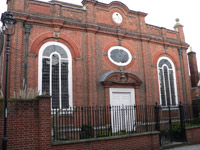
Presbyterian Chapel
|
|
blank |
The Unitarian Meeting House was built in Churchgate Street for local Bury presbyterians, and remains one of Bury's more remarkable buildings. It replaced an earlier Meeting House built for the Presbyterians. Unitarianism was not embraced until 1801.
In August 1711 the town of Lavenham suffered an outbreak of smallpox, which continued into 1712.
|
|
1712
|
From August 1711 to November 1712 the town of Lavenham recorded 259 burials, or about six times the normal average according to Betterton and Dymond. The cause was smallpox, and it needed an appeal throughout West Suffolk to raise a subscription for the relief of the town.
Newspapers are taken for granted today, but ever since printing was invented the crown or government had tried to restrict the publication of news and comment to avoid criticism. In 1712 attempts to license publications were replaced by placing a tax on every copy of a newspaper that was sold. The Stamp Act of 1712 would last for 140 years, with the rate of tax, or stamp duty, varying with the times. At first the rate was a halfpenny per copy, and a red stamp had to be attached to every copy to show that the tax had been paid. This forced the price of the paper to be increased to cover the tax levied. Nationally about 70 papers closed down, but some were replaced by pamphlets, or part works which included news. In 1757 the Stamp Tax was doubled to a penny a copy, and it increased to a penny halfpenny in 1776, and tuppence ha'penny by 1797 and fourpence in 1815. In 1855 when the Stamp Act was finally repealed, many new papers sprung up, often calling themselves a Free Press.
|
|
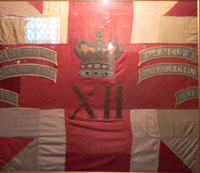
Flag of the 12th of Foot
|
|
1713
|
From 1712 to 1720 Colonel Livesay's regiment was forming part of the garrison on Minorca. In the second year of this tour of duty it received the designation, 'Twelfth Foot'. This name would stick to the regiment for the rest of its existence, even when it became the 12th (East Suffolk) in 1782, and the Suffolk Regiment in 1888.
Sir John Hervey of Ickworth had been a supporter of the 1688 revolution and in 1713 also supported the Hanoverian accession.
|
|
1714
|
The Act of Settlement of 1701 had named the Electress of Hanover, Sophia, as heir to the throne, together with her Protestant heirs.
Sophia died on 8 June 1714, before the death of Queen Anne on 1 August 1714, at which time Sophia's son duly became King George I and started the Hanoverian dynasty. He was 54 years old.
Due to bad weather, he did not arrive in Britain until 18th September.
Sir John Hervey of Ickworth had been a supporter of the 1688 revolution and in 1713 also supported the Hanoverian accession. He was at Greenwich in September to welcome the new King George I into the Country. George was crowned at Westminster Abbey on 20th October.
Lord John Hervey had been a Baron since 1703, and was now made the First Earl of Bristol for his support of the Hanoverian claim to the throne.
By this time the Bury Fair was less important as a market for merchandise, and more important as a "market for ladies".
John Eastland, a dancing master, bought the large house at the end of Angel Hill, and converted it into an Assembly House. Today this building is called the Athenaeum, but it has performed a similar public function ever since. It had been one of the largest private houses in Bury, for it had 17 hearths recorded in the Hearth Tax returns of 1674. It was on three floors at this time and Eastland had his ballroom on the second floor. The gentry would pay a subscription to use the place, and assemblies were regularly arranged. In 1715, John Hervey the first Earl of Bristol, recorded that he had paid his subscription to Mr Eastland's New Rooms in Bury. The building would stay in this form until 1789, when the ballroom was removed to the Ground Floor, as it is today.
|
|
1715
|
Since 1688, most electorates had grown in size. Suffolk County had 4,500 voters in 1673, which had grown to 6,500 by 1715. The qualification to vote for the two County MP's was to own a Freehold worth 40 shillings or more. These were called the 40 shilling freeholders.
In addition certain boroughs could also send MP's to Westminster. In most of the Boroughs in Suffolk, like Ipswich, Eye and Sudbury, voters had to be Freemen of the Borough. Ipswich had 600 freemen, Eye had 200 and Sudbury had 800, all voters.
In Bury the position was different. Only the members of the Corporation could vote for the two Borough MP's, so the parliamentary electorate in 1715 was 37, the same as in 1690, and the same as in 1614.
However, there were at least 282 40 shilling freeholders in Bury who voted in the county elections for parliament in 1710, irrespective of their rights in the borough election. These included small tradesmen as well as the more wealthy.
There were ten general elections between 1694 and 1715. The seven Suffolk Boroughs returned 14 Mp's and the County had another 2, making 16 Suffolk MP's in all.
Thomas Lee, the owner of Murrells manor and Broom Hall manor, covering some 2,000 acres at Little and Great Livermere, respectively, bought even more land at Great Livermere in 1715.
Suffolk's first newspaper began in about 1715. It was the "Suffolk Mercury or St Edmundsbury Post", published by Thomas Bailey. Its earliest known copy is dated 1st May, 1717, and was numbered issue 46. The printing press was located somewhere close to the Market Cross in Bury St Edmunds, but soon moved to Long Brackland, and later shifted homes again. Pat Murrell has suggested that the reason the first local press was in Bury St Edmunds, rather than in Ipswich, was that Bury was a fashionable town, which was home to many of the gentry, with the means and inclination to afford a regular supply of mainly London news. The Jacobite Rebellion of 1715 led to a thirst for news of the progress in suppressing the uprising. Circulation might have been 200 to 250 copies only. The Suffolk Mercury would last until about 1740.
|
|
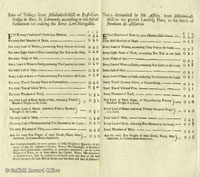 Ashley's tolls for using River Lark
Ashley's tolls for using River Lark
|
|
1716
|
The Lark navigation was now open for business from Mildenhall to Bury St Edmunds under an Act of Parliament passed in 1699/1700. By 1700 the River Lark was no longer navigable any further than Mildenhall from the sea, and so Henry Ashley obtained the Act to allow navigation as far as Eastgate Street. The Corporation of Bury were afraid of him setting up a wharfage monopoly, and opposed the plan. All Ashley could do was build his canal as far as Fornham, outside the Borough boundary.
Ashley's list of charges for moving loads along the new navigation are shown here. As usual, click on the thumbnail to enlarge it. He shows two lists on the page. One is for delivering the goods from Mildenhall Mill to Eastgate Bridge, "according to the Act of Parliament", and is on the left hand side of the page. The list on the right is for deliveries to "the present landing place in the parish of Fornham St Martin." Coal, timber, wool, salt and grain are at the head of the lists, possibly reflecting the expected traffic somewhat.
It is also interesting to note that quantities are defined by what it was practicable to count during loading. We would weigh coal by the ton and hundredweight, but here it is measured in "chaldrons", as defined at Kings Lynn; the "Lynn measure".
|
|
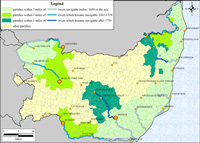
Suffolk navigable rivers
|
|
blank |
This map by Cambridge University shows the impact of improved navigable rivers on adjacent parishes. It shows how many parishes would be within three miles of the navigation once the river Lark (and others) was improved. Lark navigation account books tell us of the many stop-off points that were available along the river to unload cargo. The poorer rural areas were unlikely to unload coal, as it was too expensive, and peat turves were a cheaper alternative. Often public houses would set up and establish small piers to offload deliveries.
The canal seems to have been profitable immediately, largely for bringing in coal to Bury St Edmunds. Between 1716 and 1855 the River Lark was a busy waterway linking Bury St Edmunds with Ely, Cambridge and Kings Lynn. Boys in the 1960's still called the River Lark behind the Mildenhall Road, "the Coal Rivers".
A new purpose built church was completed for the Congregationalists in Whiting Street.
The Hervey family had owned Ickworth manor since 1467. The family had grown in power, influence and wealth by this time and John Hervey, since 1714 the First Earl of Bristol, bought the manors of Hargrave and Chevington from Sir William Gage of Hengrave for £10,942.8s.5d. He also began to plant up the woods and trees which surround Ickworth Park today.
|
|
1718
|
Between 1715 and 1718, Dr John Evans collected details of every Dissenting congregation in England and Wales. Since 1689 Dissenters could worship in public, resulting in a large increase in their numbers. Bury now had 900 Protestant Dissenters by 1718 compared to 167 in 1676. Haverhill had 250 compared to 30 in the Compton census. Clare had 400 compared to a very high 300 in 1676. Sudbury had 400 now and 100 in 1676.
Walsham le Willows had grown from only 3 to 400, and Wattisfield from 49 to 350.
Numbers attending Anglican services had declined, but under the Toleration Act of 1689, people could now avoid church attendance altogether if they wished.
Samuel Tymms recorded an outbreak of smallpox in Bury in 1718.
|
|
1719
|
The West Mill was built on Horringer Road at Bury St Edmunds by the Woodruffe family. It was built overlooking the Linnet valley to catch as much wind as possible. A John Woodruffe was recorded as running the mill in 1791. This mill stood until 1801 when it burnt down. It would be rebuilt the following year, and lasted until 1918 when it was demolished. This mill was only one of about 60 mills recorded in Bury St Edmunds over the centuries, but West Mill was one of the most successful and long running businesses.
|
|
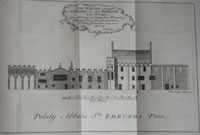
The Abbot's Palace
|
|
1720
|
In 1720, Major Richardson Pack bought the Abbey precincts, including the Vinefields, but excluding the Great Cemetery. The price in 1720 was recorded as £2,800. The Abbot's Palace had been refurbished, which explains the high price. However, Major Richardson Pack was obviously unimpressed, as he was the man who demolished the Abbot's Palace.
Richardson Pack (1682–1728) was an English professional soldier and writer. He was born at Stoke Ash in Suffolk of good family. His father was High Sheriff of Suffolk in 1697. Although he trained as a lawyer, he threw it in to join the army. Following campaigns abroad he came back to England, and after a time he moved to Bury St Edmunds. At Bury, in the spring of 1724, he was dangerously ill, but recovered under the care of Dr. Richard Mead. Early in 1725 he moved to Exeter, but he followed Colonel Montagu's regiment, in which he was then a major, when it was ordered to Aberdeen. He died at Aberdeen in September 1728.
The mansion in the abbey grounds,lived in by Sir John Eyer in the late 16th century, and now known as the Abbot's Palace, was demolished on Pack's orders. The picture shown here is of the Abbots Palace drawn in 1720 by J Burrough, the year in which the palace was demolished. Sir James Burrough was a well known antiquarian and amateur architect in the area. He lived from 1691 until 1764, and was the Master of Gonville and Caius College at Cambridge from 1754 until his death. He himself had amassed a collection of notes and drawings on the antiquities of Bury, which he would leave to the library of St James's Church. This picture was published in Dr Batteley's 'Opera Posthuma' of 1745.
Thomas Lee owned well over 2,000 acres around Great and Little Livermere by this time, including the manors of Murrells and Broom Hall. In 1720 he died, and left all his property to his son, Baptist Lee. Little Livermere probably included the an early version of Livermere Hall at this time, as Roberts considered that its central core was characteristic of the late 17th century. Nevertheless, Baptist Lee would own the property until his death in 1768, and in his later years he would make substantail alterations to the Hall and the landscape around it.
The Ipswich Journal began life in about 1720, and was a new rival for the existing Suffolk Mercury, published by Thomas Bailey at Bury St Edmunds. The Ipswich Journal was published by John Bagnall, a London printer who had moved out to Ipswich. It came out on a Saturday, and would survive under various owners until the 20th century. It became the Ipswich Gazette in 1734.
|
|
1721
|
A major financial crisis occurred with the bursting of the so-called South Seas Bubble in September. Many investors who had overstretched themselves now faced ruin. One such man was Arundel Coke of Honey Hill, Bury St Edmunds, of whom, more will be heard later.
In Bury there was an enquiry into a supposed Right of Way from Lower Baxter Street to the Angel Hill. Obviously by this time any such access must have been no longer self evident, but it is entirely possible that the original street pattern had included a street, or alleyway off the corner of Angel Hill, between the Borough Offices and number 8 Angel Hill, also called the Angel Corner. The building of the house at Angel Corner in 1702 may have obstructed this access.
There are records which tell us about the Coaching services running out of the Greyhound Yard on the Buttermarket in 1721. The Greyhound was on the site of the Suffolk Hotel, which replaced it during a rebuild in 1833. In 1721 the coach ran to and from the Vine Inn in Bishopsgate Street in London, once a week. It stopped overnight at the White Hart in Braintree, showing that it took two days to travel from Bury to London at this time. Goods travelled by the more cumbersome waggons of the day, and took a day or two longer. A one day coach would not arrive in Bury until 1737, when the Angel started a new service.
|
|
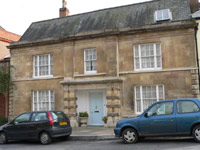
Arundel Coke's House
|
|
1722
|
A highly publicised trial took place of Arundel Coke, who lived in Honey Hill, Bury St Edmunds. Coke was a barrister, but lived a flamboyant lifestyle, and was always short of money. His home was right next door to the Manor House, and is a stone clad house which today is called St Denys. He was also one of the Guildhall Feoffees, and a pillar of local society. He had been facing ruin following the financial crisis known as the South Sea Bubble. He believed that if his wife's brother were to die, his wife would inherit his fortune. The brother in law was Edward Crisp, who lived in a very fine house at number 6, Angel Hill, which is today the Tourist Information Office.
Coke hatched a plot to hire a ruffian called Woodburn, who was also a local handyman, to murder Crisp. Following a New Year Dinner party at his house, Coke took Crisp through the Great Churchyard on the pretext of visiting Mrs. Monk's Coffee House. Woodburn then attacked them with a knife. Coke ran off, leaving Crisp to his fate, but Woodburn bungled the attempt and only managed to slash open Crisp's nose.
They were tried at the Assizes, in the Court of Common Pleas, at Bury. On 13th March 1721, they were found guilty, and sentence was passed the following day.
Both Coke and Woodburn were hanged after Coke confessed to the plot.
This case illustrates the problem that modern people can have with the dating systems in use in the past. Until 1751, the year began on Lady Day, the 25th March. From 1st January 1752, the year began on 1st January, a practice already in use on the continent. Therefore the date known at the time as 13th March 1721, to modern eyes would seem to be properly called 13th March 1722.
Dates have been "adjusted" like this over the years by later writers, and sometimes have got adjusted more than once, so that this trial has been written up as happening in 1721 or 1722, or even 1723. Does this matter? Yes it does matter if we are looking to follow the sequence of events, or the cause and effect. To modern minds the events of January, February and March 1721 are assumed to have taken place before the events of April to December, 1721. But to the person in 1721 they naturally took them to occur after April to December.
|
|
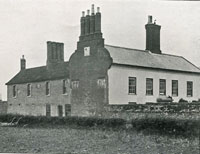
The Priory by 1907
|
|
blank |
Henry Ashley, the builder of the Lark Navigation, had now apparently accepted that he had to make his permanent terminus at Fornham, just outside the boundary of the Borough of Bury St Edmunds. He bought the Priory Estate from Bridget Short, consisting of 8 acres including Babwell Fen meadows and Bell Meadow.
This purchase included the site of the Franciscan Friary which was dissolved around 1538. Henry Ashley is thought to have built the mansion now known as the Priory, probably incorporating some features of the remaining remnants of the friary buildings.
|
|
1724
|
Daniel Defoe wrote his "Tour through the Eastern Counties" covering the years 1724 to 1726 and described Bury at the time as a major social capital. Its old cloth industries had long gone. The weaving of darnex coverlets was declining and only spinning remained as a major manufacture. "The beauty of this town consists in the number of gentry who dwell in and near it, ..... the affluence and plenty they live in". Bury fair attracted people for "the company", not for the trade. It was also called, "The Montpelier of Suffolk, and perhaps of England". Repeating earlier writers, he described the "pleasant situation and the wholesome air." Bury was "crowded with Nobility and Gentry."
Although Ipswich was far larger than Bury at this time, Defoe commented that "there were not so many gentry here as at Bury."
Suffolk had been an important textile manufacturing region since the Middle Ages, but by this time very little cloth was made in the County. Sudbury and Long Melford still made says and perpetuanas, and this would carry on for the next sixty years. Calimancoes were made in Lavenham, tammies in Stowmarket, and bays and says in Nayland.
Defoe described Sudbury as "remarkable for nothing except for being very populous and very poor."
Mostly, however, weaving was replaced by wool combing and yarn spinning for the worsted makers in Colchester and Norwich, and Bury was a growing centre for these trades.
By 1724 the Little Livermere estate was owned by Baptist Lee. Accounts differ as to whether he inherited it from his father, Thomas Lee, in 1720, or whether it was purchased in either 1722 or 1724, possibly from the Duke of Grafton. W M Roberts wrote that he could find no evidence that the Duke of Grafton ever owned this property.
|
|
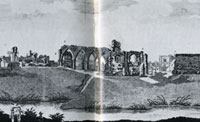
Abbot's palace in 1725
|
|
1725
|
This picture of the ruins of the Abbot's palace in the grounds of the Abbey of St Edmund was taken from a watercolour painted in 1725. It was engraved for printing by R Godfrey in 1779. If you click on the thumbnail to see the full picture, it shows the dovecote on the extreme left which can still be seen today. It also shows one arm of the River Linnet flowing immediately in front of the dovecote. At this time the Lark and the Linnet ran parallel to each other until they joined at the Abbot's Bridge.
|
|
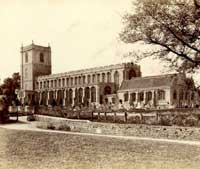
Melford church tower 1725-1903
|
|
blank |
Holy Trinity Church at Long Melford had suffered a lightning strike to its medieval tower around 1710, and was subsequently demolished. This tower was rebuilt by 1725 in the new classical style in brick. The main part of the church had been completed in 1484, the Lady Chapel in 1496, and the Clopton Chapel was from about the same date. Parts of the west end were even older than this, and the style of the new tower was a bold contrast to the Gothic whole. The tower of 1725 would itself disappear from view in 1903, when it would be enclosed within a neo-Gothic exterior. The 1725 tower can be seen in this Fred Watson photograph taken some time before the 1903 rebuild.
|
|
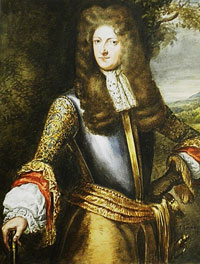
Sir William Gage 2nd baronet c1688
|
|
blank |
Dr Francis Young has discussed the origins of the greengage in England and concluded that around 1725 the second baronet of Hengrave, Sir William Gage, (c1650-1727) did indeed introduce this plum to England from France. The earliest source that he found was the reminiscences of the horticulturalist Peter Collinson (d. 1760), published in 1843. Collinson recorded that,
"I was on a visit to Sir William Gage at Hengrave, near Bury; he was then near 70; he told me that he first brought over, from France, the Grosse Reine Claude, and introduced it into England, and in compliment to him the plum was called the Green Gage; this was about the year 1725."
Mr Young also recorded a later account, which he regarded as "retrospectively invented aetiology":
"In 1812 Sir Joseph Banks (1743-1820) wrote the following in Transactions of the Royal Horticultural Society, vol. 1, Appendix, p. 8:
'The Gage family, in the last century, procured from the monks of the Chartreuse, at Paris, a collection of fruit-trees: these arrived in England with the tickets safely affixed to them, except only the Reine Claude, the ticket of which had been rubbed off in the passage. The gardener being, from this circumstance, ignorant of the name, called it, when it bore fruit, the Green Gage.'"
|
|
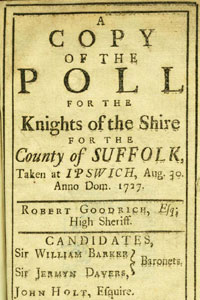
County Poll 1727
|
|
1727
|
This illustration is of a book printed by John Bagnall which records several Suffolk County polls or elections, starting with that held on 30th August, 1727. It lists, in alphabetical order the villages and towns, and the voters' names and an initial indicating the vote cast. The candidates were as follows: Sir William Barker, Sir Jermyn Davers, both baronets, and John Holt Esq. At this time every voter's name was public knowledge, together with how they had voted.
On 11th June, King George I died. Within a week John Hervey, First Earl of Bristol, had visited the new king to ask for preferment for his son John, styled Lord Hervey of Ickworth. After King George II took the throne, Lord Hervey was made the King's Vice Chamberlain.
John, Lord Hervey, was the first son of Lord Bristol and his second wife, Elizabeth Felton. They had married in 1695, and John was born in 1696. He became a very well known politician and pamphleteer, of the Walpole faction. Eventually he became Lord Privy Seal. He was close to Queen Caroline and George II. His nature led Lady Mary Wortley Montague to conclude that there were three types of human species, "men, women and Herveys." He married Molly Lepel, a court beauty, and had eight children. As he died eight years before his father at the age of only 47 in 1743, he never inherited the Earldom. His sons, however became 2nd, 3rd and 4th Earls after 1751.
The Great Court of St Edmunds' Abbey was acquired by the Davers family.
In 1727 the tenancy of the Queens Head, "a good accustomed ale house in the Churchgate Street, Bury St Edmunds", was advertised. It had once been known as the Norfolk Coffee House, but must have been an ale house latterly. It was one of three licensed premises owned by the Guildhall Feoffees, who rented them out to suitable tenants.
|
|
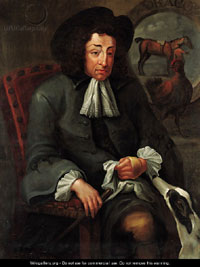
Tregonwell Frampton 1641-1727
|
|
blank |
Tregonwell Frampton died at Newmarket in 1727. He was born in 1641 in Dorset, and spent his early life pursuing the sport of hawking or falconry. Once horse racing became popular, he came to Newmarket in, or just before, 1675, to place large bets on the outcome of races. He quickly became a well known high stakes gambler, a skill which relied upon a detailed knowledge of breeding and form, in which he was expert. By 1695 his knowledge led him to being described on his tombstone as ‘keeper of the running horses to their sacred majesties William III, Queen Anne, George I and George II.’
Frampton kept this post to his dieing day, which was 12 March 1727. He was buried in the church of All Saints, Newmarket, where on the south side of the altar was a mural monument of black and white marble inscribed to his memory. In prints made of a portrait of him by John Wootton, dated 1791, he was described as ‘the father of the turf.’ His drab clothing and unprepossessing appearance was a feature of him all his life.
|
|
1729
|
Possibly one of the ceremonial maces owned by Bury St Edmunds Borough Corporation was damaged around this time as one of them has a shaft which was cast new in 1729. The corporation paid £25 17s 6d for the repairs.
|
|
1730
|
The firm of Orbell Ray in Bury St Edmunds must have been of considerable size, even at this early date, as Ray insured his goods and stock in trade at £500. This was a sizeable sum for a provincial town, and we must remember that it was normal to be considerably under insured at the time. The stocks would have been wool and yarn.
Around 1730 Sir John Cullum, the fifth baronet of the family which had owned Hardwick and Hawstead since 1656, finally seems to have moved completely from Hawstead Place into Hardwick House. Sir John was married to Susanna Gery, daughter of Sir Thomas Gery, and thus did Gery become a Cullum family name, surviving in usage into the twentieth century.
Henry Ashley junior was born in 1654, the son of Henry Ashley, (1630-1700), a tanner from Huntingdon who had leased the navigation of the River Great Ouse. Henry junior had taken over from his father, and made improvements to the Ouse, and in 1699 had been the promoter of the Act to provide the Lark Navigation. By 1730 the River Lark was a thriving canal enterprise for Ashley.
In 1730 Henry Ashley junior died, and in his will he divided his estate between his two daughters.
Part passed to his daughter Joanna, who was married to a Joshua Palmer, and part to another daughter married to a Mr Burch. Unfortunately they could not agree who got which assets, and from 1730 until 1742 there was a protracted legal dispute over the rights to the River Lark as well as other property. Not until 1842 was judgement concluded which gave the Lark to the Palmers. The Lark navigation would continue within the Palmer family for the rest of the century.
|
|
1731
|
In 1731 Samuel Kent, a London distiller, bought Fornham St Genevieve as a country estate. The Fornham estate had been owned by the Kytson family of Hengrave Hall since 1541. It passed into the hands of the Gage family, and then to the Gipps family before being bought by Kent. Samuel Kent was a wealthy London malt distiller. He would start to build Fornham Hall, and lay out Fornham Park.
This work must have continued fitfully over the next 50 years, and it is unclear which member of the family was most responsible for it. The story becomes very obscure because upon Kent's death the estate passed to his son in law, Sir Charles Egleton. Egleton had already bought land at Fornham St Martin. He was a London Goldsmith who would die in 1769 and leave Fornham St Genevieve to his son Charles. Charles Egleton changed his name to Charles Kent, and was knighted, becoming Sir Charles Kent in 1782. It is usually said that this Sir Charles Kent was really responsible for the building of Fornham St Genevieve Hall.
It is reported that during 1731 the tomb of Mary Tudor, located within St Mary's church in Bury St Edmunds, was opened to reveal a leaden coffin. A plate upon it read, "Mary Quene 1533 of ffrance Edmund S"
Until 1731 Hugh Owen was the only Catholic priest in Bury St Edmunds. Dr Francis Young has established that "in that year a Benedictine monk, Alexius Jones, arrived to serve as chaplain to the Bond family, who lived in Eastgate Street in a house that was sadly knocked down during road-widening in the 1920s....
Jones posed as a tutor to the Bonds’ son Jemmy but officiated at the Mass in a secret chapel in the Bond household."
The Catholic Bond family had moved to Bury St Edmunds in 1675, following the marriage of Mary Bond to Sir William Gage of Hengrave. Her brother William had married Mary Gage at the same time.
Around this time Woolpit was noted for making the best white bricks. Bricks would continue to made at Woolpit until the Second World War.
|
|
1732
|
The Earl of Oxford recorded that avenues of trees were newly planted in the Great Churchyard at Bury. There is some evidence that at first they planted Poplars, rather than the Limes of today. The Earl also provided a snapshot of the Brecklands.
The following account by the 2nd Earl of Oxford, gives a graphic description of the Breckland landscape in the eighteenth century:
|
|
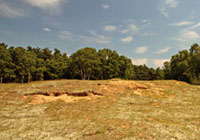
Breckland sand dunes
|
|
blank |
"The next day Thursday, September the 21st, 1732, we set out from Brandon, seven long, very long miles to Barton Mills over the sands, terrible tedious travelling both to man and horse. I could not but reflect what terrible travelling it must be where the heat of the sun is intense upon the wide sandy deserts, where the poor travellers are often smothered with the sand or scorched with the sun’s heat reflected from the burning sands. We leave the sands at Barton Mills which we were very glad of. The river that runs by Barton Mills is navigable as I said to Bury. We left Mildenhall, the seat of Sir Thomas Hanmer, on the right hand, a most miserable situation. On one side he is subject to be choked with sand, on the other he lives close to a dark vile black fen which lies to the north east of him; so that he enjoys that wicked wind with the addition of the air from that fen."
This picture of Wangford Warren shows today's trees which would have been absent in 1732. Otherwise the view is the same.
Sir Thomas Hanmer, 4th Baronet (24 September 1677 – 7 May 1746) was Speaker of the House of Commons from 1714 to 1715, discharging the duties of the office with some acclaim. He was also one of the early editors of the works of William Shakespeare, but this was not published until 1744. The estate at Mildenhall had come to Sir Thomas from his step mother, who was the sister of the second Sir Henry North.
|
|
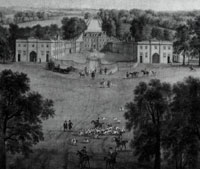
Livermere Hall c1730
|
|
1733
|
There was an English State Lottery which ran from 1694 until 1826. These early English lotteries ran for over 250 years, until the government, under constant pressure from the opposition in parliament, declared a final lottery in 1826. In 1733, it is reported that Baptist Lee, who already owned well over 2,000 acres around Great and Little Liveremere, had won £30,000 on the state lottery. This sum may be equated to over £2.5 million in today's terms. Baptist Lee now had the resources to radically improve his estates in the area.
This picture shows Lee's Livermere Hall in about 1730. The central part of the house is 17th century and the wings date from the early 18th century. The village of Little Livermere is not visible in this picture, and must have been clustered around St Peter's church off to the left of the picture. The view here is from the stream which would later be converted into two ornamental canals.
The underground Catholic Mission to Bury St Edmunds was ministered to by the secular priest, Hugh Owen, (sponsored by the Short family), and, to a lesser extent, by Alexius Jones, the Benedictine Chaplain to the Bond family. Dr Francis Young has established that another Benedictine appeared on the scene in 1733, called Francis Howard. "Howard was chaplain to the Gages at Hengrave Hall but was frequently in Bury, because the Gages owned a townhouse in Northgate Street (now the Farmers Club)."
Also, " That year a devastating smallpox epidemic swept through the town and anyone who could afford to do so fled Bury; Sir Thomas Gage and Mr Bond fled to Thetford, ostensibly on a fishing trip, and took Jones and Howard with them."
The ageing Hugh Owen was left to minister to dead and dying Catholics.
|
|
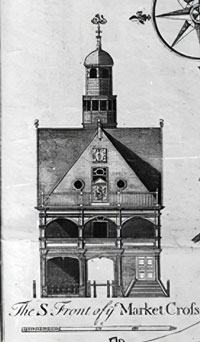
Market Cross by 1748
|
|
1734
|
Bury got its first theatre in 1734, purpose built on the first floor in the Market Cross. Converting the upper floor of the Market Cross was estimated to cost £150.
In August 1734 this playhouse was leased to George Steggould for a seven year term at £42 a year. He could put on plays during Bury Fair, from 20th September to 10th October, and also over Christmas from 26th December to 12th January. He was also allowed to run shows for a fortnight during each quarterly Assize sitting.
Performances of plays and other entertainments had previously taken place in the Guldhall and even the Shire Hall. Inn yards provided the less well off in society with the same function, but Bury Society now demanded some better facilities. The room above the Market Cross had hitherto been used as a Woolhall, or Wool Exchange, as well as for other public events, before this new work. The Woolhall was now moved down the road.
The Market Cross would be converted into the much grander structure by Robert Adam from 1774, opening in 1780, and surviving to this day.
|
|
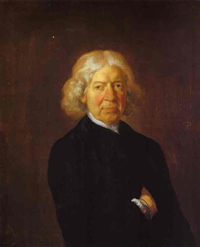
John Kirby by Thomas Gainsborough, 1753
|
|
1735
|
In August 1735 John Kirby published his book called "The Suffolk Traveller". He would follow this up in 1736 by publishing a one inch to the mile map of the county, followed by a half inch scale in 1737. Not much is known about John Kirby's origins, but he was known to have run Glevering watermill, near Wickham market, in Suffolk after 1714. By 1725 he had taken up land surveying, and he made measured plans for the estates of local gentlemen. This portrait of him was made by Thomas Gainsborough shortly before Kirby died in 1753, in Ipswich. Kirby had continued to improve the Suffolk Traveller after its first edition, and sold copies from a shop in Wickham Market, as well as through other booksellers. One of his sons, Joshua Kirby, was a friend of Thomas Gainsborough and that is how Gainsborough came to paint this portrait of Joshua's father.
Kirby had painstakingly raised himself from miller to surveyor, but his book and maps took years to produce. They were based upon surveys of the county by Kirby and Nathaniel Bacon made between 1732 and 1733. Some time in 1733 Bacon was replaced by Francis Emerton, a surveyor from Gillingham near Beccles, and Kirby and Emerton worked together on the survey through into 1734.
Emerton had previously been working on a similar Suffolk project for James Corbridge, who had announced his intention to survey Norfolk and Suffolk in 1727. Emerton now took the lists of subscribers for the Corbridge map, and gave them to Kirby, ensuring that the Kirby map would be the one to succeed.
Previously published maps had all been based upon Christopher Saxton's survey of 1575, and as over 150 years had passed, Kirby represented a significant updating and improvement on these earlier efforts.
In common with publishing practice at the time, subscriptions for the map were invited prior to publication, to be collected at booksellers throughout the county. In Bury these were taken by Hannibal Hall and Thomas Bailey during 1732. In 1733 Mrs Mary Watson, bookseller, was taking the Bury subscriptions. People subscribing for the maps at ten shillings per sheet received the book gratis.
The map was engraved on to four copper plates for printing by Mr Richard Collins at Bury St Edmunds. Each plate would produce one imperial sized sheet of paper.
At this time John Kirby was a little known, local surveyor living in Wickham Market. After he died in 1753 a second edition of his Suffolk Traveller was published in 1764 by John Shave, an Ipswich publisher. However, Kirby himself had always planned further editions.
The Suffolk Traveller consisted of a description of the county, followed by a series of journies between towns, in which each town or village is described, together with the route to take to the next village. After the introduction to Suffolk he starts with Ipswich and a village by village perambulation to Yarmouth. Having examined all roads out of Ipswich , he then describes the roads out of Bury, and so on.
Some of his observations on Suffolk included the following:
"This county is naturally divided into the Sandlands, the Woodlands, and the Fielding......"
Kirby's sand lands were the sandy soils of the eastern coastal strip of Suffolk, which he subdivided into marsh, arable and heath.
The woodland part included the southern part of Suffolk from the hundred of Blything as far as Haverhill, including those heavy clay parts of Thedwastry, Blackbourne and Thingoe.
"This part is generally very Dirty and Fruitful. In this part is made the Suffolk Butter, so managed by the neat dairy wife, that it is justly esteemed the pleasantest and best in England. The cheeses, if right made, none much better, and if not so, none can be worse.
The Fielding part contains all the hundred of Lackford, and the remaining parts of the hundreds of Blackbourne, Thedwastry, and Thingoe; and is most of it Sheep-Walks, yet affords good corn in divers parts."
"The ecclesiastical government is under the Bishop of Norwich, it being part of that see....it is divided into two archdeaconries, viz Suffolk containing the Eastern parts of this county, and Sudbury including the Western parts. These two archdeaconries are subdivided into 22 Deaneries.......The Deaconries in the Archdeaconry of Sudbury are, Sudbury, Stow, Thingoe, Clare, Fordham, Hartsmere, Blackbourne and Thedwastry...."
"The civil government of this county is in the High Sheriff, for the time being. The division of this county ...was formerly divided into the Geldable and the Liberties of St Edmund, St Etheldred, and St Audrey; but the present division is into the Geldable and the Franchise or Liberty of St Edmund, each of them furnishes a distinct Grand Jury at the Assizes..."
"Towards the military defence of the kingdom, this county furnishes, as its quota to the Militia, 4 Regiments of Foot, the White, the Red, the Yellow, and the Blew, each consisting of 6 companies. The White is raised in the south part, the Red in the North about Hoxne hundred, the Blew in the east about Beccles, and the Yellow in the west about Clare. There is one Regiment of Horse of 4 Troops, each severally carrying the colours of the Foot regiments, and belonging to them, and raised in the same parts of the country. The Militia is under the command of the Lord Lieutenant of the County, the Most Noble Charles, Duke of Grafton, being the present Lord Lieutenant."
The 1735 edition of the Suffolk Traveller was printed by John Bagnall at Ipswich. It contains many observations on the towns and villages of Suffolk, some of which were a bit sketchy.
Kirby gave the following description of Haverhill:
"Haverhill, or as in old records Haverhull or Haverel, is a long thorough-fare mean built town about a mile in length. The south end of the street is part in this County, and part in Essex. The north end is wholly in Suffolk. It has a mean market weekly on Wednesdays, and two fairs yearly, the one on May the 1st, and the other on August the 15th. Here is nothing in this town worthy of remark, at present: but it seems to have been larger than it is now, by the ruins of a church or chapel, still remaining."
Of Bury, Kirby wrote:
"Bury St Edmunds is situate on the west side of the River Lark, which is at present navigable from Lynn to Fornham, a mile north of the town. It has a most fruitful enclosed country on the south and south west, and on the north and north west the most delicious champaign fields, extending themselves to Lynn, and that part of the Norfolk Coast. The country on the east is partly open and partly enclosed. It is so regularly built, that almost all the streets cut one another at right angles; and it stands upon such an easy ascent that an ancient writer has recorded this encomium of it : "That the sun shines not upon a town more agreeable in its situation.
This was the Villa Faustini of the Romans, and afterwards had the name of Bedericesworth, or Beodricesworth, differently spelt by different authors, as Saxon names frequently are, and taken, if we might credit the records of the old monks, from one Beodricus, who being Lord and Proprietary of this town made St Edmund his heir.
The abbey.....".
Kirby went on to describe St Edmund's life. He spoke disapprovingly of how the Benedictines ousted secular clerics in 1020 and described how King Canute levied a tax of 4 pence on ploughland in Suffolk and Norfolk to pay for "a more magnificent church to the honour of this martyr." There is a description of the abbey and churches of Bury, together with the tombs of Mary Tudor and Roger Drury.
On a contemporary note he described St James church and wrote:
"There is in this church a convenient library, but no monument of note.
The rest of the publick buildings are the Abby Gate, which still speaks of the grandeur of the former abby; the Guildhall; the Grammar School, endowed by Edward VI; the Market Cross; the Wool-Hall; and the Shire House.
The civil government of the town is is now lodged in the hands of an Alderman, a Recorder, 12 Capital Burgesses, and 24 Common Burgesses. These have the sole right of choosing their own Burgesses in Parliament.
There are two weekly markets, on Wednesdays and Saturdays; the chief market is on Wednesday, and a very considerable one it is, well served with all manner of provisions. And three annual fairs; the first on Easter Tuesday, the second for three days before the feast of St Matthew and three days after, but this is generally protracted to an uncertain length, for the diversion of the nobility and gentry that usually resort to it; and the third on St Edmunds Day, November the 20th.
The Benefactors to this town are very numerous, and the commemoration of them is annually celebrated on the Thursday in Plough Monday Week.
The agreeableness of its situation has always induced many of the gentry to reside in this town and in its neighbourhood; and as it formerlly gave birth and education to several persons who were emminent in church and state, so it has also lately; and I hope may take its present flourishing condition as an earnest of its future prosperity and success.
Thus much for Bury St Edmunds. We will now take a journey from thence to Yarmouth.........."
A Freemasonry Lodge was established at the White Horse Inn on the Buttermarket. This inn was superceded by Bullens haberdashers in 1870, and in later years served as Purdey's Coffe Shop, Palmers Restaurant, and is now a travel agency and Burger King restaurant.
|
|
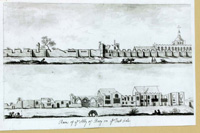
Ruins from the east - Edmund Prideaux
|
|
blank |
These sketches have been photographed by the RIBA, and the photographs are included in the archives of Historic England. They are labelled as "Bury St Edmunds Suffolk, Ruins of abbey. Drawn c1735 by Edmund Prideaux and now at Prideaux Place, Cornwall. (Date received 6.7.62)".
These sketches have sometimes been referred to as the source from which other later engravings have been made. However, they are different in several details from other engravings, and therefore do not seem to be the source attributed to Godfrey's print of 1779 by Mrs Statham on page 40 of "The Book of Bury St Edmunds".
|
|
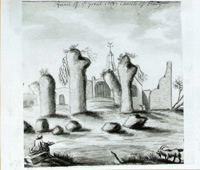
Ruins of the great abbey church - Edmund Prideaux
|
|
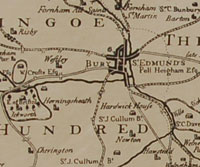
Kirby's Suffolk map |
|
1736
|
Kirby finally delivered his one inch to the mile map of Suffolk to his subscribers. They had received the accompanying book, the Suffolk Traveller, in 1735. The version shown here is a later reproduction in monochrome. This map clearly shows the Chevington Way, which no longer exists. It followed Hospital Road and Abbot Road, out of Bury, following the valley of the River Linnet, skirting around the Ickworth Estate to the west, and thence out to Chevington. When the Ickworth estate was enlarged later in the century, this route, now through the estate, would become an inconvenience to future Earls of Bristol. So from 1814 to 1823 several attempts were finally succesful in closing off this ancient routeway.
Bury St Edmunds received some fame through its MP, Lord Hervy. He was asked by the Whig Prime Minister, Sir Robert Walpole, to pilot the Quakers Bill through Parliament. This bill aimed to relieve the Quakers from some of their legal burdens, for which many had suffered heavy fines and long prison sentences over the years.
Unfortunately the established church were strongly opposed to it, led by the Bishop of Salisbury, who wrote a pamphlet called "The Country Parson's Plea against the Quakers Bill for Tythes." Lord Hervey wrote a reply, called "The Quakers reply to the Country Parson's Plea". He stoutly defended Quakerism, although it was not his own calling, and praised their piety, their thrift and industry, and their support of their own poor.
Lord Hervey had done his job well, and got the Bill through the House of Commons only to be defeated in the House of Lords. Bury Quakers as well as those in the rest of the country, got no relief from tithes until the late 19th century.
Hervey also started work on building a new house in Bury. It would be called the Manor House, and replaced the old Ickworth Manor House by the canal in Ickworth Park, which was demolished in 1710. The family currently resided in Ickworth Lodge.
|
|
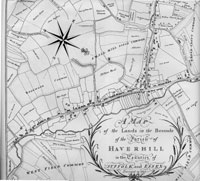
Haverhill in 1737 |
|
1737
|
A survey of Haverhill was apparently taken in 1737. A copy resides in the Essex County Archives at Chelmsford. A redrawn copy was published in 1957 as part of the West Suffolk County Council Town Plan for Haverhill. It may not contain all the details of the original. The town was surrounded by huge open fields, and the ancient strip system is still shown as being in operation. By 1820 the Enclosure Acts would have swept this system away.
Kirby's new map of Suffolk was reissued at a scale of half inch to the mile. It was intended to be a cheaper version of the 1736 one inch map. This version of the map was engraved by Isaac Basire.
Transport from Bury to London was revolutionised when the Angel become the first of Bury's inns to run a same day coaching service to and from London. Earler services did exist, but always needed an overnight stop on the journey. The new service could reach the Spreadeagle in Gracechurch Street, London, by the late evening.
From 1737 for about a century, this one day stage coach operated from Bury to London. It ran from the Angel three times a week, and was called The Old Bury, and the Angel needed to be able to stable up to 70 horses to run her and its other coach services. The Angel was not to be the only coaching inn, as they were called, as there were several others.
The Greyhound in the Buttermarket ran a coach to London via Braintree, taking two days. The Three Tuns in Crown Street was the inn for the Norwich Mercury.
The coming of the railway would cause their final demise, but the "Old Bury" ran from the Angel Yard right into the 1840's.
As well as the glamourous stage coaches, which travelled across the country, there was a need for local travel. An inn like the Angel could also be a post house, which meant that it kept a fleet of post-chaises available to provide a local taxi service. These were driven by a post boy with two horses, available at a moments notice for hire.
|
|
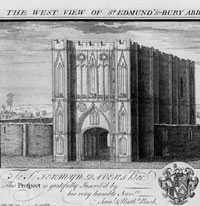
The Abbey Gate
|
|
1738
|
This picture is one of a series of engravings that Samuel and Nathaniel Buck made of British towns, castles and abbeys. Each engraving has a dedication and brief description of the place in question. The Buck brothers were important topographical artists in the 18th century. This engraving of Bury Abbey shows the Abbey Gate, and is dated 1738. The Buck brothers returned to Bury again in 1741, for another of their 'prospects'.
|
|
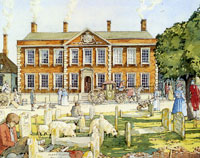
The Manor House
|
|
blank |
John Hervey, first Earl of Bristol since 1714, completed the two year building of the Manor House on Honey Hill for his second wife, Lady Elizabeth Hervey. She wanted to live and entertain in town during the Bury Season. The artist's impression shown here illustrates the Hervey coat of arms emblazoned on the portico. There was a dining room with Greek columns, and upstairs was a ballroom for guests to use after dining. Other rooms were also used for entertaining, but there was just one bedroom, so guests were not expected to stay overnight.
Lord Bristol had married Elizabeth Felton in 1695, and they had 16 children together, although four died in infancy and another died aged 9 years. Hervey had already had three children with his first wife, Isabella Carr. On 25th September 1738, Lord and Lady Bristol spent their first night in the new Manor House, staying until 7th October. It was designed by James Burrough, later to become Sir James Burrough. The Earl had originally intended to rebuild the Manor House in Ickworth, but now the family could divide their time between Ickworth Lodge, and the Manor House in Bury. Unfortunately Lady Bristol only enjoyed the house for three years as she died in 1741. Lord Bristol himself preferred the country home which he called "my centre of rest - sweet Ickworth."
Whether Lord Bristol ever now hoped to build a new home at Ickworth to replace the Ickworth Lodge, which he had intended only to be a temporary home, we do not know. It has been suggested that he could no longer afford yet another costly project, as his many sons were by now too great a drain on his purse. Several of his sons either were, or would become, friends of Dr Johnson. Boswell reported that Dr Johnson said of Henry Hervey, who he had met when Hervey was an officer stationed at Lichfield, "He was a vicious man, but very kind to me. If you will call a dog Hervey, I shall love him." Henry had at this time (about 1726), a house in London, where Johnson was frequently entertained, and had an opportunity of meeting genteel company. Thomas Hervey, one of the younger sons, was to give Johnson £50 in 1766, in lieu of leaving it to him in his will. These encounters were described later in Boswell's 'Life of Samuel Johnson LLD.'
Samuel Cumberland, a wealthy yarn maker of Bury St Edmunds, had insured his property with his partner, for £1,500, showing that Bury's yarn manufacturers were doing very well.
|
|
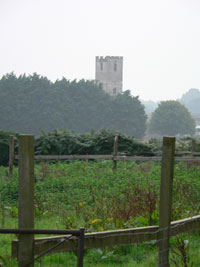
St Peter's Church at Little Livermere
|
|
1740
|
Baptist Lee owned the great house and estate at Livermere, his property covering both Great and Little Livermere. By 1740 Lee began to think about moving the village of Little Livermere to make way for the 1,000 acre Livermere Park. Baptist Lee had been the owner at Livermere since he inherited in 1720, and next door the Calthorpes of Ampton cooperated in this radical new landscape. The church remained and later its tower was raised by an extra storey to provide a fine view from Livermere Hall. The residents were provided with new estate homes elsewhere on the estate. Apart from a farmhouse, this left the church of St Peter standing isolated in the Park.
The exact date when the village was finally demolished is not clear, but baptismal records give some clues. From 1700 up to 1740 there were 24 baptisms per decade in Little Livermere church, but only three per decade in the 1750s and 1760s. From 1700 to 1750 91% of burials in the church were of persons living in the parish. In the 1750s and 1760s this had fallen to only 50%. The other 50% were presumably people born in the parish, but now located outside it.
|
|
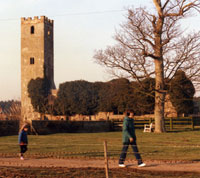
St Peter's Church at Little Livermere
|
|
blank |
The roof of the church was removed in 1948, and it now stands as a ruin. This closer view was taken during a farm visit open day to see the lambing in progress. Livermere Hall was greatly improved by Baptist Lee, but it was eventually demolished in 1923.
Alexander Downing began his survey of Bury St Edmunds. His idea was to invite subscriptions for a town plan in advance of publication, and he hoped to sell enough to make a profit. He would publish the resulting plan in 1741.
By the middle of the 1700's a traveller to Haverhill had noted that 'every cottage brought forth a clatter as the workers applied themselves to their looms'. The cloth produced was of the heavy linsey-wolsey variety used principally by the agricultural worker. It was towards the end of the century that the effect of the Industrial Revolution began to be felt. Master weavers began to appear, who bought up the finished cloth and marketed it, chiefly in London; woollen cloth giving way about this time to checks and fustians.
Lord Hervey of Ickworth became appointed to the high rank of Keeper of the King's Privy Seal. His own ten year old son would become the Bishop of Derry, and build the great Rotunda at Ickworth.
|
|
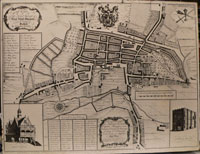
Downing's Map of Bury
|
|
| |
1741
|
In 1741 Alexander Downing published his map of Bury, which looks very curious to modern eyes, with west at the top of the plan. A lot of the detail is heavily stylised, with gardens shown neatly laid out, the buildings shown as regular blocks in front of the gardens. The town gates are depicted but almost certainly in an idealised form, not as they really looked. The rivers Linnet and Lark were shown as still flowing in parallel through the Abbey precincts, to join just before the Abbot's Bridge.
Downing sold his map for three shillings through Wolton's of Bury.
During 1741 the Surveyors William and Thomas Warren were producing plans of the landholding of the Guildhall Feoffees. One such plan showing Moyse's Hall has the area in front of it named as Hog Hill. Today we call it the Buttermarket.
No doubt they saw Downing's map, and thought they could do a better job.
|
|
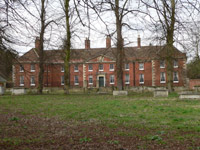
Dr Clopton's Asylum
|
|
blank |
Clopton's Asylum was shown built in the Great Churchyard in Bury, although it cannot have been finished at this time. Today it is the Provosts' house. The land was acquired by Trustees in 1735, and the fine new building seems to have been ready for its first residents in 1744. Dr Poley Clopton left money for its erection and upkeep for six poor men and six poor women who had "paid Scot and Lot without having received Parochial Relief".
Bury corporation threatened to prosecute anybody found selling Lincolnshire wool in the the two Bury wool halls without paying their market tolls. This decision was to be advertised in Stamford, Lincs, as well as in Bury on the Market Cross. This long staple wool was the basis of the high quality yarn produced around Bury at this time.
|
|
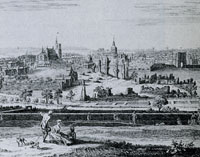
East Prospect in 1741
|
|
blank |
In 1741 Samuel and Nathaniel Buck published this engraving of the East Prospect of the town and Abbey ruins of Bury St Edmunds. Part of the King’s Topographical Collection,The East Prospect of St Edmunds Bury was released at the beginning of 1741 as part of Samuel and Nathaniel Bucks’ 'Cities, Sea-ports and Capital Towns: an important series of views showing eighty three of England and Wales’s foremost towns and cities (1728-53)'. The Buck brothers were already well known for their views of ruined castles and abbeys throughout the land.
Samuel Buck was born in Richmond, Yorkshire, in 1696, Nathaniel being a younger brother. Samuel began publishing his drawings at the age of only 15, and continued until Nathaniel died in 1754. The two brothers based themselves in London, travelling all over the countryside to draw antiquities, which they engraved during the winter months for sale as annual collections or as individual views.
The Dictionary of National Biography quotes Samuel Buck as an "engraver and topographical draughtsman, (who) drew and engraved 428 views of the ruins of all the noted abbeys, castles, &c., together with four views of seats and eighty-three large general views of the chief cities and towns of England and Wales."
In 1774 a comprehensive collection of the Bucks' work was published in 3 volumes, entitled "Buck's Antiquities or Venerable Remains of Above 400 Castles, &c., in England and Wales, with near 100 Views of Cities". The work of the Buck brothers is generally considered to be a fair and accurate copy of what they saw. Samuel died in 1779.
If you click on the thumbnail you will see the full view as published. It shows the fish ponds in the abbey grounds still visible in 1741, together with both the River Lark and the River Linnet running in parallel through the abbey grounds. The Norman Tower is shown with a pitched roof and a spire. Two windmills are visible in the distance, as is Cupola House and the Market Cross.
Mrs Statham interpreted this view as suggesting that a great deal of remains had been lost during the 1720s and 1730s. For her it cast doubt upon the accuracy of Godfrey's engraving published in 1779, which appeared to show more remains of the Abbot's Palace. In Buck's view the Palace is obscured by trees.
There was a case of arson in Crown Street, with at least two fires being laid, one of which damaged the Three Tuns inn. The Three Tuns stood where Lansbury House, once the Labour Party HQ in Bury, is now a private dwelling. The inn was not badly damaged and went on to develop as a coaching inn.
In 1741 Arthur Young, the second son of the Reverend Arthur Young, Rector of Bradfield Combust, was born at the family's London home. The child was soon taken to the Young's country home at Bradfield Hall to be raised in Suffolk. He would become famous for his writings on the improvement of agriculture, and his travels in Ireland and the Continent.
The Catholic priest, Hugh Owen, died in 1741. He had ministered to Bury's Catholics in various back room locations, like the Greyhound and the Angel, since 1691, supported by the Short family. The Gage family of Hengrave, and of Northgate Street in town, had their own Catholic chaplain, Francis Howard, who had to take over these duties, " presumably because there was no-one else available" (Francis Young). Howard himself would die in 1755.
|
|
1742
|
Henry Ashley had turned the River Lark into a fully navigable waterway between 1699 and 1716.
From Henry Ashley's death in 1730 until 1742, there was a protracted legal dispute over the inherited rights to the River Lark and his other property. Not until 1842 was judgement concluded which gave the Lark to his daughter Joanna, who was married to Joshua Palmer. The Lark navigation would continue within the Palmer family for the rest of the century.
In 1782 the third edition of "The Ancient and Present State of the Town and Abbey" revised by George Ashby contained Ashby's assertion that forty years earlier, (ie 1742), scarcely one of the shops in Bury was protected against the weather. At this time shopkeepers opened their shops by lowering shutters which exposed their wares to passers-by, in much the same manner as had occurred for hundreds of years. By 1782 only one shop would remain without the addition of sash windows to protect its stock.
|
|
1743
|
On 27th June 1743 the 12th Regiment of Foot fought against the French in the Battle of Dettingen, the last battle in which an English King (George II) led troops into the fray. Their motto "Stabilis" or "Steady" was also adopted at this time from the personal arms of the Colonel of the Regiment at Dettingen.
In 1743 there was an outbreak of smallpox in Bury St Edmunds, and in order to avoid panic, the following announcement was published:
"Bury St. Edmunds, September 23rd 1743.
Whereas it has been industriously insinuated by some ill-designing People that the SMALLPOX is very rife and fatal in the Town, to the very great prejudice of Trade, and of the Industrious Poor; we whose names are hereunder subscribed, do certify to the best of our knowledge, and from the most strict and exact enquiry we are capable of making by our proper Officers, that the Small Pox is not in more than Six Families at present, and that the number which have already had it, doth not appear to be more than Thirty Persons, two only of which have already died; and that the Public may be thoroughly satisfied either as to its increase or Diminution, proper care will be taken weekly to advertise the same."
This was signed by a number of ministers, churchwardens, physicians, apothecaries and overseers
|
|
1744
|
The threat of smallpox continued to trouble Bury St Edmunds into 1744, so much so, that some traders who were able to do so moved out of town. This advertisement was placed in the Ipswich Journal of March 17th 1744 by the Linen Weavers of the area:
"Whereas several of the Linen Weavers who constantly kept the Weavers-Hall in BURY ST. EDMUNDS with Hempen Cloths, are now hinder’d their usual attendance there by Reason of the Small Pox being so much in Town; We do hereby beg Leave in this manner to acquaint ... the Dealers in Hempen Cloths, that we whose Names are hereunto subscribed have agreed to give our constant attendance weekly every WEDNESDAY, at Ten o’clock in the Forenoon, at the RED HOUSE of HORNINGSHEATH, (about a mile from BURY) where our constant Chapmen, as well as others who will please to deal with us, shall be well and kindly served, by their most humble Servants,
JOHN MALLOWS
JOSEPH HART."
More happily, by the Autumn, the town claimed to be free of the disease:
"BURY ST. EDMUND’S, October 20th 1744.
THIS TOWN being now entirely free from the Small-Pox or any other contagious Distemper, Mr. Wood hopes his Friends will give him Encouragement as usual, by sending their Daughters or Relations to Board and School with him; where all due Pains and Care, with the greatest Candour, shall be taken in their Education in all its Branches, by their humble Servants.
ISAAC and HANNAH WOOD"
At Westley, the church of St Thomas of Canterbury, (Thomas a' Beckett) suffered severe damage from a storm. The church lost its steeple, and apparently this was not replaced. Further storm damage in 1789 would be attributed to its long decline until by 1834 it would be closed as beyond repair.
|
|
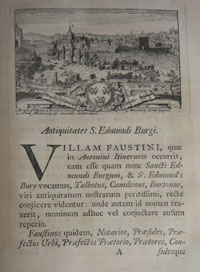
John Battely's 'Antiquities'
|
|
1745
|
The Jacobite Rebellion occurred in Scotland under Bonnie Price Charlie.
John Battely had lived from 1646 to 1708, and was educated at Bury School, eventually becoming Archdeacon of Canterbury. During his lifetime he wrote the first history of Bury St Edmunds, but it had never been published.
In 1745 the Opera Posthuma or Posthumous Works of John Battely were finally published, with assistance from Oliver Battely and Sir James Burrough. This work was entirely in Latin and consisted of Antiquitates Rutupinae (Reculver) and, more importantly for our Chronicle, Antiquitates S. Edmundi Burgi ad Annum MCCLXXII Perductae. It outlined the history of Bury from Roman times to 1272. It included the much reproduced engraving of the Abbot's Palace drawn by Sir James Burrough in 1720, and the copy of Canute's Charter included in the Sacrist's Register, folio 20. King Edward's charter and a list of Abbots was also included.
Sir James Burrough was a well known antiquarian and amateur architect in the area. He lived from 1691 until 1764, and was the Master of Gonville and Caius College at Cambridge from 1754 until his death. He himself had amassed a collection of notes and drawings on the antiquities of Bury, which he left to the library of St James's Church. In 1736 he had advised the wife of the Earl of Bristol on the form and design of the Manor House in today's Honey Hill.
|
|
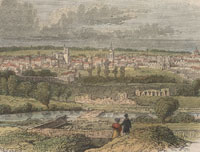
Bury View 1745 |
|
blank |
Once a view had been published, it was often copied by other publishers, with a few changes or "improvements" favoured by the engraver. This view derives from a reworking of Buck's engraving among others. Its source is thought to be the London Illustrated News, but many topographical books were published in the late 18th and 19th centuries which contained re-workings of older engravings, presented as new work.
|
|
1746
|
The rebellion in Scotland was finally put down.
In 1706 the Great Barton estate had been bought by Thomas Folkes from the Audley family. In 1724 Folke's daughter Elizabeth married Sir Thomas Hanmer, taking the estate with her into the Hanmer family. Sir Thomas Hanmer had been Speaker of the House of Commons, and when he died in 1746, he left all his estates to his nephew, the Reverend Sir William Bunbury. The inheritance included not only Great Barton and its hall, but also the estate of Mildenhall, which Hanmer had himself inherited from his mother. It would remain owned by the Bunbury family until its destruction by fire in 1914.
Thomas Hammer himself is commemorated by a plaque upon his home at Eastgate House, in Eastgate Street, Bury St Edmunds. Today, Eastgate House is a home for the elderly.
Downing's 1741 map of Bury perhaps did not show all the details required, and so, during 1746, the father and son team of William and Thomas Warren made their own survey. They must have thought that it was still possible to make money from a new town map if it was of sufficiently high quality, and appealed to the gentry. They advertised for subscribers at six shillings per map, twice the price of Downing's plan. The Warrens were established surveyors in Bury, often working for the Guildhall Feoffees. In 1741 they had produced plans of the Feoffees' landholdings.
In 1898 the Autobiography of Arthur Young was published, long after his death in 1820. He was born in 1741. It is unclear when he was sent away to school, but he recorded that "When I was of a proper age to be placed at school a choice had to be made between those of Bury St Edmunds and Lavenham; no possible motive could induce anyone to to think of the latter, except the circumstances of my father having been there himself. The master of the former school, Mr Kinsman, was one of the finest scholars of his age, and is mentioned with much respect by Cumberland in his memoirs." Mr Kinsman was headmaster of Bury School from 1715 to the late 1740's.
Unfortunately for Arthur, his mother so liked the master at Lavenham, the Reverend M Coulter, that she persuaded his father to send him there. He was indulged at school, and later even went partridge shooting with his headmaster.
Young was displeased by his education in later life as he felt that his Latin and Greek was so bad that he had to teach himself these languages after he left Lavenham school in 1758.
|
|
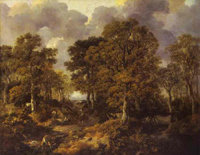
Cornard Wood by Gainsborough
|
|
1747
|
This picture, sometimes known as Gainsborough's Forest, was a view of Great Cornard Wood from the grounds of Abbas Hall at Cornard. This wood no longer exists, but shows a Suffolk landscape where ancient woods were still widespread. Thomas Gainsborough was born in Sudbury in 1727, and started this picture while still at school, completing it around 1747, at age 21. His father was a Sudbury clothier, but after 1752 he moved to Ipswich, Bath and to London, in order to find a living as a painter. He would become one of the country's best known painters in future years.
Publishing in 1747 was just as tricky an operation as it is today, and through 1747 the new Warren map of Bury was advertised as nearly ready, or expected shortly, (in July). Members of the gentry with a coat of arms were invited to apply to have their arms emblazoned around the edge of the new map, at an additional charge of five shillings. The map would be sold at Watson's of Bury, but also in several other towns, as well as in London. By the end of 1747 subscribers still had not received their map.
|
|
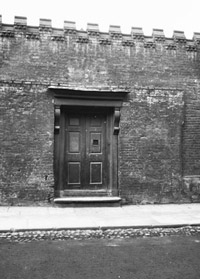
The dreaded workhouse door |
|
blank |
In 1747 Parliament reorganised Poor Relief, by encouraging parishes to form Unions for this purpose.
James Vernon left a farmhouse at Great Wratting for use as a workhouse for four parishes. The benefits of scale were being appreciated, and after this date other combined centralised workhouses were set up in Bury and Sudbury. At this time the St James's Poorhouse was in Eastgate Street, and St Mary's was near the Shire Hall. After 1747, the two Bury parishes of St James and St Mary's were incorporated for poor law purposes under a Court of Guardians of the Poor.
The parishes of St James and St Mary's were incorporated under a local Act of Parliament (21 Geo. 2, An Act for erecting Workhouses, for the better employing and maintaining the Poor within the Burgh of Bury Saint Edmunds; and for the better repairing and paving the Streets and Highways there.). The Incorporation was managed by "twelve persons chosen out of the honestest and discreetest inhabitants occupying tenements of £8 yearly rent" together with twelve ex officio members from the Borough's aldermen, recorder, coroner, assistant justices and capital burgesses. They immediately set about looking for a site for a new combined workhouse.
Until 1747 Bury's two MPs were usually nominated by the Earl of Bristol and the corporation were happy to agree with him. After this date the Duke of Grafton also shared this patronage. Sudbury's two MPs' seats were available more or less to the highest bidder.
The manor and manor house of Mildenhall had been held by the Hanmer family since the 1670s, but nobody with the name of Hanmer was able to inherit the estate, or the baronetcy, when Sir Thomas Hanmer died in May, 1746. Thus Sir William Bunbury, Hanmer’s nephew, inherited the property in 1747 and Mildenhall would remain in the hands of the Bunbury family until the final break up of the estate in 1933. Sir William Bunbury already owned a large estate at Great Barton, as well as others in Cheshire, and he preferred to live at the much larger and more spacious Barton Hall.
|
|
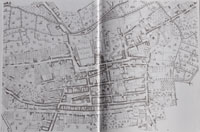
Bury town centre in 1748
|
|
1748
|
Finally, in February 1748, Thomas Warren's long awaited map of Bury St Edmunds was printed and ready for distribution to its subscribers. By now William Warren, the father of Thomas, seems to have dropped out of the picture. The new map turned Downing's plan upside down as Warren had placed east at the top of his plan. This followed a tradition which went back to medieval times, when east was seen to have a religious significance. Like Kirby's map of Suffolk in 1736, Warren's town plan was engraved by Richard Collins of Bury St Edmunds.
Thomas Warren's new Town Plan dated 1748 has the following market places marked upon it:
- Horse market - located in today's St Mary's Square
- Butter and Fish market - located in today's Buttermarket from Marks and Spencer's down to Abbeygate Street
- Beast Market - located in today's market area between Woolworth's and Marks and Spencer's.
- Great Market - located in today's Cornhill and Traverse area.
Abbeygate Street itself is named Cook Row at this time.
The present day Honey Hill is so named on Warren's map, but its medieval name had been Schoolhall Street as the monastic song school and grammar school had been located east of St Mary's Church and on the site of the Shire Hall.
|
|
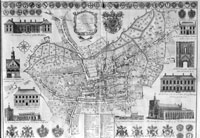
Warren's Bury map 1748
|
|
blank |
This edition of the Warren map is not widely available. Most published versions are of the revision made in 1776 by Thomas Warren's son, also confusingly called Thomas. The 1748 plan showed the location of the old wooden butchers shambles, south of the Market Cross. It had gone by the time of the 1776 edition. The 1748 cameo picture of the Market Cross showed its original wooden structure with an open ground floor. By the 1776 edition it was shown in its new grander Adam style in stone. Perhaps the easiest way to tell which version you are looking at is to examine the view of the Manor House shown on both maps. The 1776 version describes the Earl as "late the Rt Hon'ble John....", as he was no longer alive in 1776.
Building number 18 on the 1748 map is the Quaker Meeting House located much further north than the present site. In 1748 it was further down Long Brackland, in the road still called that name today. Although today's Quaker Meeting House is in St John's Street, it was called Long Brackland until the 19th century, and the 1776 map shows it in its current spot. Perhaps erroneously the 1776 map shows the old location as number 18 as well. In 1748 the Quaker burial ground was at the lower end of Well Street.
Warren's map also shows that lime kilns were in operation at this early date. Three locations were shown. They were all to the west of the town, beyond St Andrews Street (South). The first was located off Field lane, in an area whch became Boby's Iron Works, and later redeveloped for Waitrose, Halfords, etc.. Second was a very long lived site north of Hospital Road, called Chevington Road in 1748. This area survived as a large pit until the late 20th century. The third site was located between the Chevington Road and Clare Road, which we know as Out Westgate. The underlying chalk was dug out and burned in kilns to produce a form of lime which could be used for quicklime or processed into lime suitable for making building mortar.
In October the Bury St Edmunds corporation paid Warren five guineas to acknowledge the value of his new plan. However, it was clearly intended to be a commercial venture, and was not commissioned by the Borough.
Thomas Warren senior was a surveyor, but described himself in his will as a schoolmaster of Bury. However, he is also known to have been the first Clerk to the Trustees of Dr Clopton's Charity. He died in 1761, but he had a son, also called Thomas, who was also a schoolteacher, as well as the second Clerk to those same Trustees. Thomas II undertook his own town survey and re-issued his father's map in 1776, with some details updated. Dr Clopton's Charity still exists.
In 1748, the newly Incorporated Poor Law Guardians of St James and St Mary's parishes in Bury paid Thomas Woodroffe the sum of £420 for a house on College Street, formerly part of Jesus College, and converted it into a workhouse. The house had been in use as a girls' school and now became the Union Workhouse for 200 people. The site sold to the Guardians of the Poor stretched from College Lane northwards to the rear of properties in Churchgate Street, located between College Street and Whiting Street. This College Street workhouse would remain in use right through to 1884.
Bury St Edmunds' new workhouse in College Street employed its inmates in yarn spinning on contract to the local yarn makers. This continued for many years. In 1783 the Workhouse complex was enlarged by the building of the Rookery, the House of Industry for the Workhouse inmates.
|
|
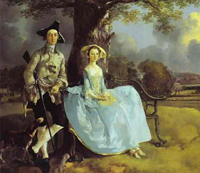
Robert Andrews and His Wife Frances
|
|
1749
|
In 1748 and 1749, Thomas Gainsborough painted this picture, known as "Robert Andrews and His Wife Frances". This picture was probably commissioned to mark the marriage of Robert Andrews (?1726-1806), local landowner, to Frances Carter (1723-80) which took place in November 1748, at Sudbury. The background is likely to show "Ausberies", the Andrews' estate outside Sudbury. Andrews is shown with his dog and gun, a sporting country gentleman of his day. Gainsborough had moved back to Sudbury at this time, but there were not enough other local commissions to keep him going. Luckily his wife Margaret (nee Burr), had £200 a year, or his painting career may never have been able to develop.
The once mighty west front of the old abbey church had been converted into living accomodation, and other secular uses. In 1749 Samsons Tower was used as stabling by the Six Bells public house, which stood on Chequers Square, and is today the Masonic Lodge. Previously, it had been stabling for the Assembly Rooms.
|
|
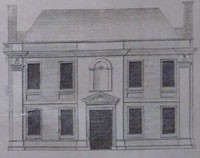
Grand Jury House
|
|
1750
|
Around this time the Shire Hall, the old monastic school building, was rebuilt. It stood more or less opposite The Hervey's Manor House, and was very important as the site of the Assizes, which brought in tourists to view trials, as well as the legal personnel.
In the 1750's the town's medical centre was in Angel Lane at the Dispensary. Smallpox had been a problem for a hundred years and there was a particularly bad outbreak in this decade. Inoculation would become more accepted in the next half century, particularly after half the population of Bury seem to have suffered symptoms during this outbreak.
Henry Bunbury, the caricaturist and cartoonist was born at Great Barton. His father was the Reverend Sir William Bunbury, the 5th baronet, who owned the estates of Great Barton and Mildenhall. Henry was sent to school at Westminster and to university at St Catherine's College, Cambridge. His work stretched from his student days until his death in 1811.
|
|
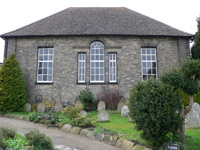
New Quaker Meeting House
|
|
blank |
A Quaker, John Drewett purchased several old decaying tenements in Long Brackland some distance closer to the town than the existing Friends Meeting Place. The intention was to build a new Quaker Meeting House and bring the Burial ground and meeting place together. Warren's map of 1746-47 showed the old Quaker Meeting house as much further down Long Brackland than today's site, and its burial site was in Well Street. The new Meeting House was completed in 1751, and the whole area was conveyed in Trust to the Quakers in 1752.
In Moyse's Hall there is a 1 ton block of coal used by Ridley's coal merchants as a trade sign. On it is the legend "Ridley's Coal and Iron Coy. Limited. Established 1750. Best Hard Steam."
In Edmund Gillingwater's "Historical and Descriptive Account of St Edmundsbury" of 1804, he remarked:
"Between the years 1740 and 1750, there was scarcely a shop in the Cook Row that was not partly or entirely open to all the inclemencies of the weather, whereas at this time (1804), and for several years past, there is not one but what is elegantly sashed."
Professor Alun Howkins of the Diss Heritage Triangle project believes that by 1750, "Diss was probably the most important centre of linen marketing and production in England." With its beginnings around 1550, the linen trade caused an economic boom, resulting in the buildings seen today in the centre of Diss predominantly dating from 1550 up until 1700. After about 1750 the rise of machine made cottons in the North-West would lead to the gradual collapse of linen production throughout East Anglia.
|
|
1751
|
Until the end of 1751 the year began in Britain on Lady Day, the 25th March. If March was therefore counted as the first month, this explains why September was the seventh, October, the eighth, November the ninth and December the tenth month, as in their names.
The First Earl of Bristol died at the age of 85. For some years he had lived quietly in retirement at Ickworth Lodge. Ickworth was still a village existing between today's lake and the Rotunda. The Lodge still stands in the park today, but there was no thought of the great Rotunda which dominates the Park today. His first son Carr, had died in 1723, and his eldest son John by his second wife had died in 1743. Therefore his grandson George William now became the Second Earl of Bristol.
|
|
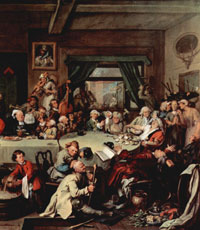
Hogarth's satire on elections
|
|
1752
|
England and Wales adopted the Gregorian Calendar and an 11 day correction was needed to bring Britain into line with Europe. The day after September 2nd became September 14th 1752. The new year now began on January 1st. This new system had been in use in the Catholic world since 1582 when Pope Gregory had fixed the months of unequal length, and refined the calculation of the leap year to keep local time in step with the movement of the planets.
A story has grown up that angry mobs took to the streets to demand the return of their missing eleven days. This story seems to have arisen because it was raised as one of many election issues in the hard fought election of 1754. William Hogarth then satirised the conduct of the election in one of a number of paintings. In the scene shown here it is just possible to read "Give us back our eleven days", in a placard on the floor. However, it is clear from the picture that many other slogans were also being satirised, and the use of flying bricks and lavish entertainment of voters is more of an issue to Hogarth then the change in the calendar.
At Bury the Quakers officially took over their newly built Meeting House in St Johns Street, where it remains today. It had been in progress since John Drewett bought the land in 1750 for this purpose. This fine building remains today, although it was then in the street called Long Brackland, becoming called St Johns Street in the 19th century. It could hold 500 people and has had a Suffolk white brick facade added on the east side in the mid 19th century.
Meanwhile Roman Catholicism, whilst illegal, was quietly practiced in Bury. Sometime in the 1750's a large extension on stilts was added to a substantial red brick house in Southgate Street, butting on to St Botolph's Lane. It seems that this was used by John Gage, a jesuit priest, as a chantry chapel to say the Mass.
|
|
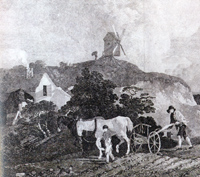
The Suffolk Plough by Gainsborough
|
|
1753
|
This etching was an attempt by Thomas Gainsborough to copy one of his own paintings for the printers. Both the picture and the etching are entitled The Suffolk Plough. Although Gainsborough was impatient, and thought that he had spoiled the plate in the acid bath, the picture shows two remarkable features. The first is the Suffolk wheeled plough, and the second is the open trestle windmill on the hill in the background.
Thomas Gainsborough was born in Sepulchre Street, in Sudbury, in 1727. In 1740 he moved to London, but returned home to Sudbury in 1748. After 1752 he tried Ipswich and Bath as places where he could find commissions. He went back to London in 1774, and had considerable success there. He died in 1788, and was buried at Kew.
In 1753 Orbell Ray the younger inherited a prosperous wool and yarn business from his father. The business was in Guildhall Street, Bury St Edmunds. Although Bury has not been regarded as an industrial town, by this time there were many large yarn making concerns in the town. One of the biggest was that of the Ray family. Four years later the firm would be joined by James Oakes, and the yarn business in Bury would grow and prosper until the 1780's.
In Bury most of the textile merchants were non - conformists, but both Ray and Oakes were unusual in this business by being Anglican.
In 1898 the Autobiography of Arthur Young was published. He had lived from 1741 to 1820, mostly on the family estate at Bradfield Combust.
Young recorded in his autobiography, that, "about the year 1753 I was inoculated". He was aged 12 or 13 at this time. The practice was quite risky at the time, and his father had opposed the idea. However, his mother called in Dr Kerrich, a physician at Bury St Edmunds, while his father was away in Cambridge. Young recorded that "at this period inoculation was so little understood that it is utterly astonishing how anyone could escape; instead of the cool regimen afterwards prescribed by Sutton, the practice was to keep the patient's chamber as close and hot as possible, the shutters were kept up, and the door never opened without being shut speedily. I suffered much, and Dr Kerrich, the physician at Bury, for some time attended every day."
Inoculation was known in Britain since 1721, when Lady Mary Montague brought the idea back from Constantinople, where her husband was ambassador. She had her own children inoculated, and her influence caused trials to be undertaken on condemned prisoners, who received freedom in exchange for the experimentation. After they recovered, the Prince of Wales was so impressed that his own daughters were treated in 1722. At this time inoculation consisted of taking matter from a known smallpox victim who had suffered only a mild case of the illness, and rubbing it into a small wound on the patient's skin.
Not until 1796 would the vaccine derived from the far less dangerous cowpox be generally deployed against smallpox.
|
|
1755
|
Bury had a small but active Catholic population at this time, but no permanent place of worship and had to rely upon the Chaplains of gentry families for a ministry. Both Francis Howard (Gage chaplain) and Alexius Jones, (Bond chaplain) died in 1755, leaving no Catholic Mission in Bury St Edmunds.
At this point the Jesuits returned to influence in Bury when John Gage saw this opening. John Gage was the brother of Thomas Rookwood Gage of Coldham Hall. John Gage had established a chapel in his mother Elizabeth Rookwood’s house in
Southgate Street in 1753, and now wanted to take over the Bury Catholic Mission. The Short family, always against the Jesuits, tried to set up a rival Dominican Mission, but Gage had greater financial resources.
|
|
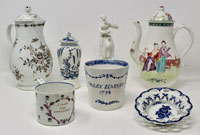
Lowestoft porcelain
|
|
1757
|
Lowestoft Porcelain was first established in 1757 by Robert Browne and Philip Walker at a factory in Crown Street in Lowestoft. They produced a range of household pieces such as teapots, tea bowls and personalised birth tablets. There were also specially commissioned pieces inscribed with names and dates. The factory was built on the site of an existing pottery or brick kiln and was in production for longer than any English soft-paste porcelain producer other than Royal Worcester and Royal Crown Derby. It finally closed down by 1802.
It is thought that local white clay was found in nearby Gunton. Flint to provide silica came from the beach and cattle bone came from the town's butchery trade which supplied local needs but also provisioned the trading ships in the harbour.
Many of the deaths recorded in Bury in 1757 were attributed to Smallpox. It had become a disease which haunted the imagination.
The River Lark navigation was inherited by Ashley Palmer, the son of Joshua and Joanna Palmer, nee Joanna Ashley. The river was still the best way to bring in heavy goods like coal to Bury St Edmunds, and would remain so until at least 1846, when the railway arrived. Bury did not have any turnpike roads connected to it until 1762, but road transport would remain difficult and expensive for heavy loads over long distances for decades to come.
|
|
1758
|
Wilkin's Guide of 1867 reported that in 1758 Dr Symonds paid for the repair of the tomb of Mary Tudor, located within St Mary's church in Bury St Edmunds. Mary was the third daughter of Henry VII, and a favourite sister to Henry VIII. She had, for a short time, been Queen of France. Symonds supplied her resting place with a marble plaque, "suitably inscribed." Her body had originally lain within the Abbey of St Edmund, but during the Dissolution, her remains had to be removed to St Mary's.
|
|
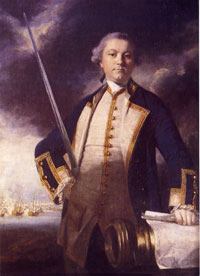
Admiral Hervey in 1775
|
|
1759
|
Elections at this time were very expensive for the parliamentary candidates, as they were routinely expected to treat the electors and their families. Although only the 32 men of the council could vote, Admiral Hervey spent £400 on entertaining 360 people at the Angel Hotel on New Year's Day.
Admiral Augustus John Hervey seems to have been a very popular MP, not just because of his generosity. He had just returned from active service in the Mediterranean, during what we now call the Seven Years War. Just a day or two earlier he recorded in his journal that he had been greeted by "the bells of Horringer, Chevington and Bury ringing all the way as I passed, and three or four thousand people met me about one mile out of Bury with flags, morris dancers, music and loud acclamations of joy. They in a manner carried my chaise into town..."
Gerry Nixon has pointed out in his book "Old Inns and Beerhouses of Bury St Edmunds" that many streets wth a number of taverns or inns in former times, now have none at all. In Southgate Street in 1759, St Mary's parish land tax book included five inns. These were the King of Prussia at the town end on Prussia Lane, the Three Crowns, a few doors down from the "King", the White Hart, now Abbey House, the Sword in Hand, now number 64, and opposite it, the Plough at number 83. At this time the Plough had a large yard and was used as a Drovers inn for holding stock on market days. In 1805 the Shepherd and Dog would be built and would be a more convenient inn for drovers to use at that time.
One of the most famous of the 12th Regiments' engagements was on 1st August 1759 at the Battle of Minden. Six British regiments, including the 12th Foot on the right of the leading line marched through withering cannon fire and repulsed six elite French cavalry charges. Sheer determination and steadiness won the day, and the soldiers plucked roses to decorate their hats. Today Minden Day is still commemorated by a parade and the wearing of a red rose and a yellow rose.
|
|
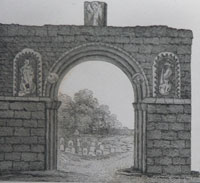
St Margaret's Gate
|
|
1760
|
George III came to the throne.
In 1760 the St Margaret's Gate to the old monastery cemetery , was taken down. It was located at the foot of Honey Hill, somewhere opposite the Manor House Museum. This view was taken from sketches found in the collection of Thomas Martin of Palgrave, and published in Yates Antiquities second edition of 1843.
|
|
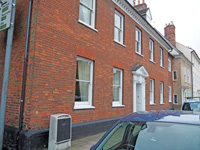
John Gage's house
|
|
blank |
Despite all the new dissenting religions, the Roman Catholics still numbered about 158 in Bury at this time. They were always thought of as recusants, rather than dissenters. Although the Mass was still technically illegal, Father John Gage, a Jesuit, built himself a house and chapel in Westgate Street in 1760/1761. He was brother of the owner of Hengrave Hall, and enjoyed status and some wealth.
Gage had worshipped at a chapel in his mother's house in Southgate Street since he set up the chapel there in 1753. In 1755 he wanted to take over the Catholic Mission to Bury, and because he benefitted from superior funding, he was able to complete his permanent purpose-built chapel in Westgate Street which still stands to this day. The chapel was built as an extension to the rear of house.
|
|
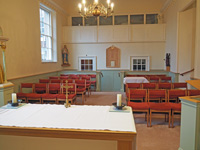
John Gage's chapel
|
|
blank |
Dr Francis Young has described this building as follows: "John Gage’s chapel is truly remarkable: it is one of the first semi-public and purpose-built Catholic chapels in England. Although the penal laws had ceased to be enforced by 1761, Catholics remained on the alert. As recently as 1745, all horses and firearms had been confiscated from Catholics as a result of the Jacobite rising, and as the Gordon Riots of 1780 would prove, anti-Catholic mob violence was far from over. Yet John Gage felt safe and confident enough in Bury to build a chapel behind his house which, although invisible from the street, was quite obvious from the rear.
John Gage’s chapel was a pattern for other chapels built after the Second Catholic Relief Act of 1791, which allowed the licensing of privately owned chapels. But how was it that, thirty years before his chapel was legal, John Gage felt safe enough to build it? All the evidence suggests that Bury was an unusually tolerant town towards Catholics; indeed, it was such a good place for Catholics to live that they chose to move there."
The picture here is a priest's eye view looking back towards the house, which was the access way at the time.
|
|
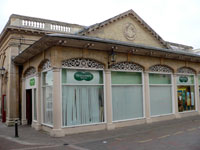
Shambles - new in 1761
|
|
1761
|
The sale of livestock took place in Bury roughly where the Corn Exchange stands today. Butchers had long had a Shambles there for the preparation of carcases, and by now the area was probably in need of improvement. A new Butchers Shambles was erected at this time, in a splendid style with colonnades, and arches. Remnants of this building was incorporated into the Corn Exchange finally built here in 1862, on its north face, and the area between the Traverse and Cornhill retains the name The Shambles today.
Thomas Warren senior died in 1761. He had produced the best map of Bury so far in 1748. However, he left two sons who were also surveyors, and the son known as Thomas would produce his own version of the town plan in 1776. Details like the new shambles mentioned above, needed to be included.
|
|
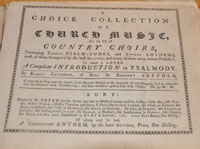
Printed Bury by W Green 1761
|
|
blank |
This collection of church music was printed in Bury St Edmunds in 1761 by W Green. It is one of the volumes which have remained in the library of St James Church, and survived the many moves of that library. The book contains a long list of subscribers, including one Misael Remon Malfalgueyrat, MD. This gentleman was a male midwife, which was apparently almost unknown at this time. Other subscribers included Signor Passerini, Master of Music, also Mr Newton, another Music Master, Mr Apsey of Bury, Sir William Bunbury, Bart, Mr Samuel Frost, Organist of Bury, Sir William Gage, Bart, Bury, Mr Alderman Jackson, Bury, and the Right Honourable the Lord Maynard.
Between 1761 and 1765 the town gates of Bury were demolished in order to improve the flow of traffic.
The origin of Methodism in Haverhill seems to date from this year when a barn in that town belonging to John Adams was licensed for itinerant preachers.
|
|
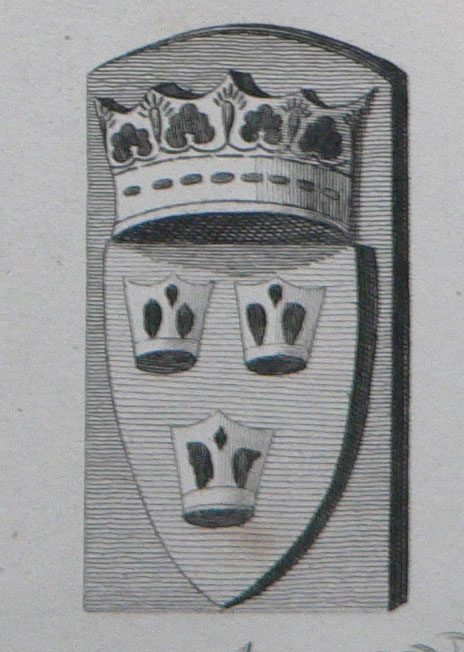
Abbey Arms
|
|
1762
|
The South Gate stood at the bottom of Southgate Street and was pulled down in 1762. According to Yates (1843 edition), this stone bearing the arms of the town, was preserved at the time of this demolition and placed by Dr Symonds in a wall belonging to his late residence on St Edmunds Hill. Today this residence is called Moreton Hall.
Just outside the South Gate used to stand St Petronilla's Hospital for female lepers.
After leaving the South Gate, one could turn left up the valley side to head to Ipswich, or turn right to proceed through Nowton to Hawstead. One might also carry straight on for Sicklesmere and on to Long Melford and Sudbury.
|
|
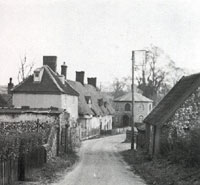
Approaching Sicklesmere
|
|
blank |
At this time the road from Bury to Sudbury and Clare became a turnpike, following an Act of Parliament in 1762. A toll bar was located at Sicklesmere, adjacent to the Rushbrooke Arms. The distinctive octagonal Toll House survives today as a private dwelling. If you ignore the overhead cables, this early 20th century photograph gives an impression of the turnpike road at Sicklesmere, approaching the toll bar from the Bury direction. The houses on the left have been swept away since the photograph was taken to widen the road, as motor transport came to demand such improvements to allow two way traffic.
|
|
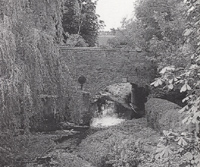
Melford Bridge
|
|
blank |
As part of the turnpiking of the road, the ford at Long Melford was finally bridged. The "ford at the mill" was a ford no longer. This bridge crossed the Chad Brook, a tributary of the River Stour. This view is from the footpath near the mill.
The Grammar School in Northgate Street was enlarged to give accomodation to 30 boarders. An extension was tacked on to its southern end, unbalancing the symmetry of the original facade.
John Wesley, the great Methodist preacher, recorded in his diary that he preached in a barn in Haverhill. He also visited Bury 17 times over several years from about 1755 onwards. At Bury he would preach in private houses, one of which was the home of Hannah and Elizabeth Jervers in the Horsemarket, which today is called St Mary's Square.
|
|
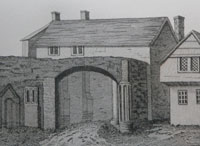
The East Gate
|
|
1763
|
The East Gate at Bury St Edmunds was pulled down in 1763. It was close to the Abbots Bridge in Eastgate Street. The East Gate was different to the other gates into Bury, as it also stood on a river crossing. The East Gate was attached to the Abbey wall where the small cell or room is located on the street side of the Abbot's Bridge. It straddled Eastgate Street to join to the The Fox public house. The East Gate was also kept under the control of the Abbey until its dissolution. The other town gates had been allowed to be controlled by the townspeople eventually. The view of the gate itself was published in Yates Antiquities, in the second edition of 1843. It may well have been taken from an earlier view, possibly the one shown below. Yates wrote that " a good idea of the scene may be obtained by a general view in Volume III, p 329 of The Antiquarian Itinerary, second edition of 1808.
|
|
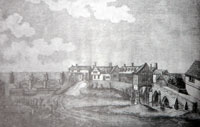
The Eastgate Bridge
|
|
blank |
The Fox was possibly an inn which could house travellers who arrived after the gates were closed at night. Outside the Gate there was an open space which is now called the Broadway. This was needed as part of the river crossing. Over the years there was a succession of small bridges for use by travellers on foot, while the heavy carts had to ford the river there.
When the river was in flood, heavy goods had to be got across the bridge as best they could. The structure next to the bridge on stilts is said to be a Chapel to Our Lady.
Mustow Street was originally the road inside the gate leading to the Angel Hill or Le Mustowe, as it was once known. Our modern bridge did not arrive until 1840.
Suburban development outside the gate along Eastgate Street had been taking place since Mediaeval times. Nevertheless there was still farming carried out on the backlands. Barn Lane gave access to the water meadows and farm buildings on the north side of this street. St Nicholas' Hospital had been one of the Abbey foundations, and stood at the end of Eastgate Street where the road divided into Hollow Road, Barton Road, Mount Road and Shakers Lane.
|
|
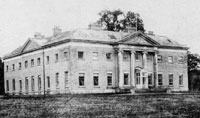
Redgrave Hall |
|
blank |
Redgrave Hall was owned by the Holt family at this time, and in 1763 they employed Capability Brown to rebuild the hall. This was done using the white Woolpit bricks. This house is no longer to be seen as it was demolished in 1946, but fine views of the landscaped park and its lake are visible from the Bury to Diss road today.
|
|
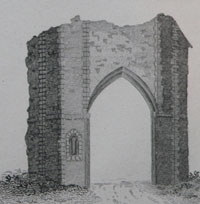
The North Gate
|
|
1764
|
The old North Gate was pulled down in 1764. Today the site is either under or next to the Northgate Roundabout. This picture shows the gate as it must have been towards the end of its life, as published in Yates's Antiquities in the 1843 edition. It was attributed to Mr Thomas Martin, who drew it in about the year 1749.
John Kirby the surveyor had died in 1753. A second edition of his book, "The Suffolk Traveller" was published by John Shave of Ipswich in 1764. The revisions for the book were put together by the Reverend Richard Canning.
In the second edition of the book "The Suffolk Traveller", published in 1764, the editor repeated Kirby's 1735 description of the land north-west of Bury as "delicious champaign fields". Champaign means "open country". The area we call Breckland was then known as the fielding and retained its medieval character of open-fields, heaths, sheepwalks and rabbit warrens. After the sheep, a corn crop would be taken, but the soil remained poor.
In mid-Suffolk by contrast, farming was more intensive and productive. Turnips had been grown for winter cattle feed for a century; carrots, clover and other crops were rotated. This area was called the Woodlands or High Suffolk and dairy cattle were also important and famous nationally for their milk production. Defoe had written earlier that Suffolk made "the best butter and perhaps the worst cheese in England".
|
|
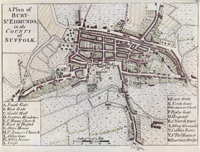
Dury's Map of 1764 |
|
blank |
In 1764, Andrew Dury published his "Collection of Plans of the Principal Cities of Great Britain and Ireland, with Maps of the Coast of the said Kingdoms." Plan 10, of the 18 plans in the book, was of Bury St Edmunds. It seems to have been based upon Alexander Downing's map of 1741, having the same layout, but he included some different details. Dury gave his publication address as Dukes Court in London.
John Wesley travelled through the area to Norwich on many occasions, often staying at Lakenheath, a village with a revivalist tradition. In 1757 he filled the newly built "preaching house" there.
|
|
1765
|
The West Gate which stood at the junction of St Andrews Street and Westgate Street was pulled down in July 1765, and the materials sold for ten guineas. The Risby Gate which went across the road by the Cock, now the Grapes Inn, at the top of Risbygate Street was also pulled down.
The White Horse was an inn on the Buttermarket, which closed in 1870, and is now the site of Burger King restaurant, by Moyse's Hall. In 1765 it was thriving and was home to a Freemasonry Lodge. This year a Coaching Service was set up here to run to London three times a week, ending at the Kings Arms in Leadenhall. At this time the White Horse was a leading coaching inn, only overtaken by the Angel, the Greyhound, (Suffolk), the Half Moon and the Bell in the next century.
In 1765, Joseph Maulkin, a maltster, acquired a large malthouse and granary on the Horsemarket, now called St Mary's Square. It stood on the corner where Westgate Street and Sparhawk Street met. A house went with the property,facing into the Horsemarket.
Next door, across Crown Street, stood Wright's Brewery. There had been a Brewery in Westgate Street, Bury St Edmunds, throughout the 18th Century, owned by three generations of the Wright family.
By 1765 Baptist Lee's estate at Livermere had been fully emparked. The village of Little Livermere was effectively removed, leaving only the church remaining as a decorative feature. The stream which had supported Little Livermere had been converted into two large stretches of water, called Broad Water and Long Water, covering 37 acres. This gave an attractive outlook for Livermere Hall. Long Water also reached beyond Lee's estate into the adjoining Ampton Park estate of James Calthorpe. Baptist Lee had owned the estate since the early 1720s and he would die in 1768, having made major changes to Livermere Hall and the environment in which it sat.
|
|
1766
|
Shortly after the Suffolk Traveller's second edition of 1764, a revised one inch scale map to accompany the book was produced by two of John Kirby's sons, Joshua and William Kirby. This was an updated and corrected version of John Kirby's 1736 map, engraved by John Ryland. Together with the engraved arms of local families, the whole map measured five feet by four feet when all the sheets were stuck together.
According to Horace Barker, in his "West Suffolk Illustrated" of 1907, the Thingoe Hill at Bury St Edmunds was the place of execution up to 1766, when one Betty Burroughs was said to be the last person to be hanged on this site. Barker stated that Thingoe Hill had been called Betty Burroughs Hill for some years afterwards.
Elizabeth Burroughs was tried at the Bury St Edmunds Assizes in March, 1766 for the murder of Mary Booty, who was a servant in the home of Henry Steward, a Bury St Edmunds upholsterer. Elizabeth Burroughs seems to have climbed in through the window of Stewards house for the purposes of burglary, but was interrupted by Mary Booty. It was alleged that Booty received fatal injuries from Burroughs in making her escape. When arrested, Burroughs maintained that she was innocent and accused Henry Steward of the murder. They were both put on trial and Steward was acquitted, while Mary Burroughs was sentenced to death. On the gallows she again declined to confess, claiming to be "as innocent as the child unborn."
This case became even more impressed upon the public imagination when, in 1767, a Bury St Edmunds woolcomber, called Samuel Otley, confessed to the murder of Mary Booty, but his claim was dismissed, and he was found to be insane.
The main Colchester, Haverhill and Cambridge road was turnpiked in 1766. News now travelled faster and trade and communications all became easier and cheaper. Today's Withersfield Road in Haverhill was called Red Cross Road at the time.
In 1766 the import of all manufactured silks and velvets was prohibited. This gave a tremendous boost to the silk industry, which spread into Cheshire and South Lancashire. It had started in Spitalfields, London and in Norwich, but expanded into Macclesfield, Manchester, Stockport and Derby. The Spitalfields silk manufacturers began to want to reduce their costs in order to meet this new compettition. The nearest source of labour skilled in weaving was to be seen in East Anglia, and the closest point to London with available labour was in Essex and the south of Suffolk. As the wool trade declined it looked as if silk manufacture could take up the slack. To an extent this would turn out to be the case, but the demand for silk products would never provide the amount of employment that the declining woollen New Draperies had done in their heyday.
|
|
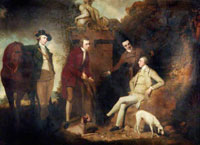
Shooting Party at Cavenham Park
|
|
1767
|
In 1767 Cavenham Park was sold by Joseph Watkin to Thomas Le Blanc. The estate at Cavenham was a renowned shooting estate in the 19th century, and probably was so at this period as well. This picture by John Hamilton Mortimer is entitled "A Shooting Party at Cavenham Park, Bury St Edmunds, Sir Simon le Blanc and Nephews." The artist died in 1779, so this picture probably dates from 1767 up to that date. If accurately portrayed, it shows by the garden sculpture that Cavenham Hall was a grand mansion in its day. It would be demolished and replaced by a new building in the late 1890s, which would itself be demolished in 1949.
Arthur Young undertook a six week tour of Norfolk. He lived at Bradfield Combust, and although he ran a farm there with little success, it gave him the knowledge to assess the value of farming practices which he found elsewhere. Nevertheless he conducted a variety of agricultural experiments and continued his early interest in writing by publishing his first major agricultural work, the "Farmer's Letters to the People of England", in 1767. When he published his "Six Weeks Tour of Norfolk", it was well received nationally. He himself claimed only that he had publicised those agricultural improvements which he found on individual farms around the country.
After 1767 Arthur Young tried farming in Essex, but his real strength was in the written word, resulting in publication of "A Course of Experimental Agriculture" in 1770.
The 3rd Duke of Grafton, Augustus Henry Fitzroy, become Prime Minister from 1767 to 1770, the only Suffolk resident to hold that office. He was on good terms with Dr Jack Young, the older brother of Arthur Young, of Bradfield Hall. Jack Young had been educated for the church, and had "a steady rectitude of principle." On one of his visits to Euston in this prime ministerial period, Jack Young found to his dismay that the Duchess was away, and "he perceived sitting at the head of the table the notorious Nancy Parsons instead of the Duchess." He then walked out on the Prime Minister's dinner party, and rode the 15 miles back to Bradfield the same night. Arthur Young recorded that the Doctor (Jack) was looking up to the Duke for preferment, and by this action he lost a bishopric. Jack Young was killed in a hunting accident in 1786.
Audits of the local Catholic populations were carried out in 1680, 1705, 1744, 1767 and 1780. The period of Roman Catholic persecution is often referred to as the 'Penal Times' and lasted from 1534 to 1778. Although the measures were often harsh, many anti-Catholic laws were not always strictly enforced, and this was often the case in Bury St Edmunds. By 1767 local Catholic recusants were 2.5 percent of Bury's population, compared to 0.97 percent nationally. Catholics found it easy to live here, and were never seen as a threat. Local Catholic gentry families like the Gages of Hengrave and the Rookwoods of Coldham Hall were all respected by this time.
|
|
1768
|
The Great Plague of Haverhill killed 79 people in an already depleted population.
In Bury, Orbell Ray died, and left his valuable share of the Ray yarn-making business to his nephew, James Oakes, later to be known to us from the diaries he wrote from 1778 to 1827. James Oakes was born in November, 1741, the son of James Oakes senior and Susan Ray. He was educated at the King Edward VI Grammar School in Bury, and had left at 16, to be apprenticed for four years with his uncle, Orbell Ray. He had been with Ray eleven years by 1768.
Oakes's father had come to Bury from Lancashire some time before 1726, and set up as a wholesaler in Manchester cotton goods at the top of Cook Row, today called Abbeygate Street. In 1729 he married a local woman who died in 1737, leaving him some property. In 1741 he married Susan Ray, giving him entry to the leading social, commercial and political families in Bury. The Rays were substantial clothiers and yarn makers, and together with about 20 other yarn makers made up a major industry in Bury. James Oakes senior had died in 1759 as an eminent tradesman of Bury.
By the 1760's all the wool used in the Suffolk yarn industry came from long fleeced wool brought from Lincolnshire and some other counties. This wool was traded in two wool halls in Bury, having been brought in from Stourbridge Fair and from London markets. Stourbridge was the source of most of the wool sold into Norfolk and Suffolk. Defoe had called it the biggest fair in the nation.
The short fleece wool from Suffolk and Norfolk sheep was sold in these woolhalls and then had to be sent to Yorkshire to be carded and spun for woollen cloths. Our local sheep were bred more for eating, and had not produced long staple wool since the seventeenth century.
Lincolnshire wool arrived in Bury via the waggon service to Stamford, and from the Midlands by way of the Lark navigation to Kings Lynn and beyond. Ships also landed wool at Ipswich, and at Yarmouth, which could be waggoned to Bury.
The best of the Romney Marsh wool, from Kent, also went to Norwich and to Bury.
By this time Ray, Oakes and company were now scouring and washing the raw wool as part of their manufacturing process of turning raw wool into high quality yarn. This was done in town, mainly in St Andrews Street South, in large buildings with open areas for drying it afterwards. Previously the farmers may have washed the wool, or there were specialist woolstaplers who did it.
Apprenticeship registers for 1750 to 1765 also showed that there were more woolcombers in and around Bury St Edmunds than anywhere else in Suffolk. Hadleigh came next in numbers followed by Kersey, Boxford, Lavenham, Glemsford, Nayland and Sudbury. Oakes reckoned that one comber produced enough wool to keep 30 spinners in work. Again, if they worked for Oakes, it would have been behind his Guildhall Street home, in St Andrews Street, in a series of comb shops in one large narrow building. These were built between 1745 and 1758. This was a considerable concentration of labour and capital for this mainly pre-industrial time.
The combs used in the combing of wool needed to be heated, and Oakes seems to have been bringing in coal for this purpose via the Lark Navigation, by this time. This also probably led him to sell coal on to other local users, as by 1788, he was included in a list of Bury coal merchants.
The spinning side of the business was, however, anything but industrialised, and it is likely that Oakes employed at least 1,500 spinners working in their own homes, throughout the countryside. These networks of spinners extended over large areas, as Oakes had workers from Burwell to Woodbridge, a spread of 60 miles. Packmen took loads of combed wool to local shopkeepers or publicans who acted as Putters - Out to their own local teams of spinners.
Arthur Young commented on the trade of wool combing in Lavenham in 1769. Young wrote that many Lavenham woolcombers earned from 12s to 14s a week, and were thus much better off than local weavers of says and calamencoes who only earned 5s 6d to 6s a week. Naturally this would be a powerful incentive resulting in the reduction in weaving and the shift to combing and spinning.
Norman Scarfe has suggested that Bury's first town guide was produced in 1768, called, "A Description of the Ancient and Present State of the Town and Abbey". It went to at least three editions, the third being published in 1782.
|
|
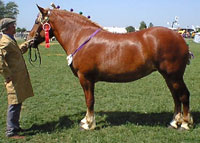
Eyke Ruby
|
|
blank |
The Suffolk horse, or Suffolk Punch, is the oldest breed of heavy horse in Great Britain to exist in its present state. The breed dates at least into the sixteenth century but all animals alive today trace their male lines back to one stallion, a horse called Crisp's Horse of Ufford, who was foaled in 1768. The Suffolk horse has a docile temperament and it is the only clean-legged British draught horse. This meant that it could work on heavy clay soil without becoming encumbered by mud. The breed is endangered today, but is kept alive by enthusiasts such as the Suffolk Horse Society, as shown by this picture of Eyke Ruby at the East of England Show in 2000.
At Livermere Hall, Baptist Lee died after making great changes to the Hall and to the grounds in which it stood. There was now a park of about 1,000 acres, containing two ornamental lakes and a grand mansion. In 1768 the estate passed to Lee's nephew, Nathaniel Lee Acton, of Bramford. He would own the estate until his demise in 1836, and make further changes to the Hall in the last decade of the 18th century.
|
|
1769
|
The Corporation of Bury St Edmunds built a market house for the fish and herb market. A turnpike was established from Bury to Ixworth and Norwich with a tollbar operating at Great Barton, following the Act of 1769.
Thomas Warren, the son of the 1748 maker of the Bury map, was also a surveyor and in 1769 was making a plan of the Fornham Estate for its owner.
Between 1751 and 1783 Capability Brown worked on most of the great estates in the land. In 1769 he was brought to Ickworth by the 2nd Earl of Bristol. Many of the clumps of trees were planted here by Brown from 1769 to 1776, when he received his final payment.
In 1731 Samuel Kent had bought the estate at Fornham St Genevieve. upon Kent's death the estate passed to his son in law, Sir Charles Egleton. Egleton had already bought land at Fornham St Martin. He was a London Goldsmith who now died in 1769 and left Fornham St Genevieve to his son Charles. Charles Egleton changed his name to Charles Kent, and was knighted, becoming Sir Charles Kent in 1782. It is usually said that this Sir Charles Kent was responsible for the building of Fornham St Genevieve Hall, although it seems likely that some sort of manor house must have already existed there.
|
|
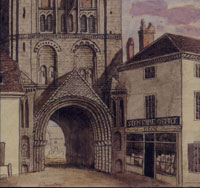
Deck's Post Office c1780
|
|
blank |
In 1769 Philip Deck announced (Ipswich Journal 7th October, 1769) that lately he had been operating as a bookseller and stationer in the coffee house, but had now bought a shop adjacent to the Church Gate (now called the Norman Tower), and would carry on his business from there. In 1771 Deck married Elizabeth Hill, daughter of Bryan Hill, the Postmaster. When Hill died in 1774, Philip Deck would become Bury St Edmunds Postmaster, a post taken over by his son John Deck in 1802.
This picture shows Deck's Post Office in about 1780, a small detail from George Quinton's watercolour entitled 'The Saxon Tower'.
Deck's Post Office would remain a Bury landmark until its demolition in 1845 as part of the Norman Tower repairs and refurbishment. Part of the site would be replaced by the Savings Bank in 1846.
There is a surviving document of St Mary's Parish Land Taxes from this time. It lists several old inns, like the Masons Arms in Whiting Street, which still survive today. This inn had traded in even earlier times as the Bricklayers Arms.
|
|
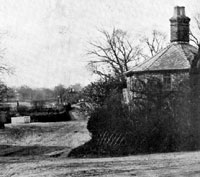
Higham Turnpike
|
|
1770
|
The Bury to Newmarket turnpike was set up following an act in 1770, with tolls collected at Risby. Later maps show a Toll Bar or turnpike at Higham. This view taken in the early 1900's shows the way down to the Higham Railway station off the Bury to Newmarket road. The toll house is the distinctive octagonal lodge type of building. There is another surviving at Sicklesmere. To get a view of the Seven Mile Tavern on the left, please click on the picture. This was the refreshment room for the railway, as well as a half way house between Bury and Newmarket.
This improvement in the road system had several effects. It tended to fix the route between places in a way which had not been the case in the past. Older routes would become neglected for the better surface of the new road, and old short cuts would die out. The newer surfaces also allowed lighter coaches to be built that could travel faster than before. Fewer stops would be necessary as speeds rose.
|
|
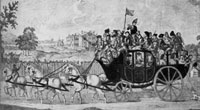
The Bury Fly
|
|
blank |
This engraving was published in 1770. It shows the Bury Fly going to Bury Fair. It is intended as a comic comment on the overcrowding that could take place on these vehicles, but it gives some indication of the type of coach then in use. If you click on the picture for a bigger view, you can just make out the name of the coach emblazoned on its side.
In the background is the building known today as Moreton Hall School. If these dates are correct this building would have been in the process of being built at this time.
By 1770 Arthur Young had spent the last three years away from Bradfield Combust, farming in Essex. However, he neglected his own property as he embarked upon a series of journeys through England and Wales. He reported his observations of real farming methods in books which appeared from 1768 to 1770. The major works were "A Six Weeks' Tour through the Southern Counties of England and Wales", "A Six Months' Tour through the North of England" and the "Farmer's Tour through the East of England". These were all well received by the public, and he made £1,167 income in 1770. However, he spent much more on his travels, his family at home, and his own agricultural experiments.
Arthur Young recorded that in 1770 he was in debt to "the" Bury banker to such an extent that he had to visit him at his country seat at Troston to pacify him. He owed the banker around £1,000, and paid him off with difficulty.
Young does not name his banker, but the earliest bank in Bury St Edmunds was run by John Scotchmer, a draper. His bank closed when he retired in 1775.
|
|
1771
|
During 1771 work continued on bringing the route from Newmarket to Bury up to turnpike standards. The route from Kentford to Bury may have been an old Roman Road and John Fairclough has pointed out that the Romans, although renowned for making straight roads, would invariably build in a detour where it was necessary to bypass an ancient burial site or sacred grove. Hence, at Barrow Bottom, the old road had avoided a Bronze Age burial mound, or barrow. The turnpike engineers had no such scruples. The Gentleman's Magazine number 54 of 1784 reported as follows:
"In the year 1771, when the turnpike road from Bury to Newmarket was made, in order to continue in a straight line for two or three miles together, it was necessary to cut away part of the base of the barrow which stands between the 5th and 6th milestones."
In the 20th century the whole barrow would be removed by road improvements and widening to create a two lane route from the port of Ipswich to the Midlands.
Arthur Young continued to publish his agricultural writings, re-issueing many in new editions. In 1771 he published the Farmer's Calendar, which went through many editions. His interests were wide, and one paper was entitled "Proposals for numbering the People", in which he proposed a national census to ascertain the true population. At the time it was thought to number 7 million. He had to wait until 1801 for the first census to take place.
On 2nd November, 1771, the following account of a riot at Sudbury was printed in the local press. Apparently the Sudbury Corporation, later to be satirised by Charles Dickens as a notorious rotten borough, was refusing to admit three local men to the Freedom of the Borough. Although this is purely an honorary appointment today, in the 18th century only freemen could pursue certain trades within the borough boundaries. The report stated,
"We are informed that a very great riot happened on Tuesday last at Sudbury in Suffolk when the corporation were assembled in the town hall and that after the corporate body had dissolved their assembly about noon they were forcibly detained in the town hall till after nine at night, totally denied of the access of their friends and deprived of sustenance, and when night came their lights were put out by the populace and that their lives were not only repeatedly threatened for a long time together but by stones and other mischievous implements they were put into danger till the end, the corporation were forced into compliance with such terms as the populace thought proper to impose on them in order to preserve their lives and recover their liberty."
By Sunday a party of dragoons arrived to keep order. In the following April, 17 of the rioters were sent to Bury gaol. Further charges were brought in August 1773 against "several" persons, and six were convicted and finally sentenced in February 1774 to 6 months in prison and a whipping. Another person was fined £100.
|
|
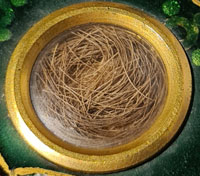
Beaufort's hair
|
|
1772
|
The following information comes from the Universal Directory of 1791:
"On 20th February 1772, workmen breaking up part of the old abbey church in Bury St Edmunds, discovered a lead coffin with the embalmed body of Thomas Beaufort, son of John of Gaunt. He had died in 1427, and was buried at the entrance to the Lady Chapel, close to the wall, on the north side of the choir. He was reburied in an oak coffin close to the north side of the large north east pillar which formerly assisted to support the Belfrey."
Dr Thomas Gery Cullum, who had a surgery in Northgate Street, examined the remains. He noted the extremely well-preserved state of the body mainly due to the high-quality embalming, layers of cere cloth and the tight-fitting lead coffin. Cullum removed its two hands, putting them into preserving fluid and sending them off to the Royal College of Surgeons museum. Cullum carried out further investigations on the body, also cutting off samples of hair, which may now be seen in Moyses Hall Museum.
By 1772 Arthur Young of Bradfield Hall, by now well known for his agricultural writings, was considered to have become almost destitute because of his overspending compared to his income. He considered leaving the country. In 1773 he took up a post as parliamentary correspondent to the Morning Post, to increase his income.
|
|
1773
|
Moreton Hall was built for Professor John Symonds by Robert Adam. Symonds Road reminds us of him today. It was located on the top of what was then called St Edmunds Hill.
Lady Bristol's grandson, Felton Lionel Hervey, inherited the Manor House in Bury, in the road now called Honey Hill. He would sell the house some before his death in 1785 to Dr Charles Mandeville. The name Felton came from his grandmother's maiden name which was Elizabeth Felton, and use of this name was obligatory if he were to inherit the house. In 1785 Felton Hervey would shoot himself dead with his Grenadier Guards pistol.
In 1773 George Paul (1740-1828) and his wife came to Bury St Edmunds to set up as an ironmonger. The family originated from Burwell. Like many businessmen at the time, he was a religious dissenter, and they were welcomed into the close knit Independent Church. (Later this became the Congregational Church.) The church also acted as a banker in that church accounts recorded that £20 cash was lent to George Paul at 5% interest. George became a Deacon, as did his son, George Paul II (1776-1852) who preached throughout South West Suffolk, meeting all the leading corn growers and maltsters. Their descendants would leave Bury and, in 1877, found the firm of R & W Paul, the well known malting enterprise at Ipswich. The name Paul's Malt would survive into the 21st century, eventually renewing a presence in Bury St Edmunds.
|
|
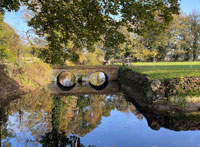
Moat and ruined walls
Little Saxham Hall
|
|
blank |
In 1773 Little Saxham Hall was demolished. It was a moated site and upon demolition the new bridge shown here was constructed to give farm access to the grassed over site.
Little Saxham Hall had belonged to the Crofts family since the 1530s, and it is thought that John Crofts had moved here from West Stow Hall, which he now retained mainly as a hunting lodge. A descendant, Sir John Crofts, had taken up residence at Saxham in 1612, having moved in from Bedfordshire on the death of his father. He had been knighted in Dublin in 1599, probably for active service in Ireland. He lived at Little Saxham from 1612 until his death in March 1628, and Sir John had several visits from James I, the recorded ones being in February 1620, December 1621 and February 1622. After the Civil War King Charles II visited Baron Crofts at Saxham at least four times, in March 1666, October 1668, April 1670 and October 1676. A century later the great days of Little Saxham were long forgotten. The last owner, Richard Crofts, was now living at West Harling, in Norfolk. It was he who gave instructions for the Hall to be demolished in 1773. It was now hopelessly old fashioned, and had probably fallen into disrepair, having been neglected and unoccupied for some time. The estate was retained by the Crofts family until its sale in 1789.
There had been a silk industry in Spitalfields, London for a century, founded mainly by Protestant Huguenot weavers escaping persecution in France after 1665. By 1773, ther had been almost a decade of trouble in Spitalfields caused by cheaper foreign competition, and resulting bitter disputes and even riots over conditions and rates of pay. A special act of Parliament, the Spitalfields Weavers Act, was passed in 1773. From now on, the wages for silk weavers would be fixed: in Middlesex by the magistrates, and in London by the Lord Mayor, Recorder and Aldermen. It would become illegal for any master to pay more, or any workman to accept less, than the established rates. This seemed like a good idea, but it resulted in both weavers and silk masters wanting to escape from these regulations. Over the next decades there would be a drift to silk production to places like Sudbury, Glemsford, and a little later, even as far as Haverhill. These towns also had wool workers who were losing work to foreign competition, and were ready to take on silk weaving at rates below those previously demanded in Spitalfields. At first this work was organised through outworkers, who had their own looms at home. It is therefore difficult to find documentary evidence of when this first occurred, but in July 1784 Arthur Young took his French visitors on a five or six day tour of Suffolk and the Essex border. They went to Long Melford and Sudbury, noting the "considerable trade in woollens and silk stuffs." In Sudbury itself there is a record of silk weaving in Weavers Lane by 1791.
|
|
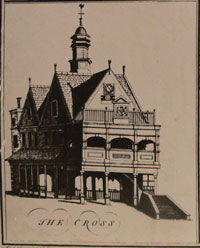
The old Market Cross in 1741
|
|
1774
|
Robert and James Adam produced designs for refurbishing The Market Cross, which was originally erected by 1620, after the Bury Fire, and was now felt in need of improvement. The work probably lasted until 1780, and consisted mainly of enclosing the old building with an elegant stone faced brick facade. The ground floor was still open to the road and used for the corn exchange. The ground floor remained open to the elements until it was enclosed in 1840. The upper floor was already used as a theatre, and continued to put on plays. The Earl of Bristol subscribed £500 to works on the New Theatre as it was called.
The Guildhall Feoffees had been given the Angel hotel in 1557, had eventually disposed of it, and then bought it back again in the 17th century. It was now showing its age and the Feoffees started rebuilding the Angel in April 1774, a job which took five years. However, once completed, the Angel would become the most imposing hotel in Suffolk, and the venue of choice for all important local functions.
In 1766 Sir Charles Davers, the fourth generation of the Barbados sugar family, had returned to Rushbrook from his army career. He had 8 children by a Mrs Treice who lived with him. He was well liked, and although he was a Whig, although a rather independent one, he was elected as an MP in 1774, and would be consistently returned to Parliament by the corporation of Bury for the next 28 years.
In 1774 Sir John Cullum died and was succeeded as sixth baronet by his eldest son the Reverend Sir John Cullum, FRS, FSA. The Reverend Sir John is probably the best remembered of the Cullums as he was an eminent scholar, becoming a Fellow of the Royal Society and a Fellow of the Society of Antiquaries. He was appointed Rector of Hawstead in 1762, and Vicar of Great Thurlow in 1774. The Cullums seem to have had a family interest in botany, as like Sir Dudley Cullum, the 3rd baronet, the Reverend Sir John made his name in this field. His descendants would also follow on these botanical interests. His work of 1783 and 1785 is still of interest today.
The first carriers of official mail were post boys, but in 1774 John Palmer of Bath in Somerset started to point out publicly that the post, instead of being the fastest form of communication, was actually the slowest form of transport in the country. Despite the fact that Turnpike Trusts had made vast improvements to roads, the Post Office was still using post boys for the delivery of mail. Palmer's proposal was to replace them with lightweight stagecoaches pulled by frequently changed teams of horses. Despite his campaign, nothing would come of this idea until 1784.
In 1774 Arthur Young of Bradfield published his "Political Arithmetic", which was widely translated. He considered it one of his best works. He was so well known at this time for his writings that he was elected a Fellow of the Royal Society.
|
|
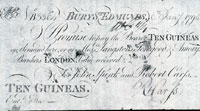
Spink & Carss note 1795
|
|
1775
|
In 1775 John Scotchmer, who is thought to have been the first banker in Bury St Edmunds, retired. It is unclear whether he overlapped with another of the early town bankers, John Spink, or whether Spink succeeded him.
In Bury, the draper, John Spink, was known to have been carrying out some form of banking activities before 1775. From 1775 he would gradually expand this side of his business to make Spink's Bank the largest such bank in Bury until its failure in 1797. By 1795 he had gone into partnership with his son in law, Robert Carss, also a draper. This banknote for 10 guineas dates from 1795, but is one of the earliest surviving local banknotes.
Ashley Palmer, the proprietor of the Lark Navigation, married Susanna Cullum, one of the Cullums of the Hardwick and Hawstead estates, just south of Bury St Edmunds. This marriage would result eventually in the Lark Navigation passing into the hands of the Cullum family.
The Second Earl of Bristol died. The Second Earl of Bristol, George William, had never married, but like his father, was a prominent Whig politician, rising to Lord Lieutenant of Ireland, and Lord Privy Seal. He had commissioned Capability Brown to landscape Ickworth Park. The work may have been called off with his death, or it may have finished naturally. Brown would be paid off in 1776. The 2nd Earl was succeeded by his brother, Augustus, Vice admiral of the Blue. His wife was Elizabeth Chudleigh, whom he married in 1744. She was apparently a bigamist, causing a great scandal, when she "married" the Duke of Kingston in 1769.
Arthur Young reckoned the population of Bury at 7,135 in 1775.
|
|
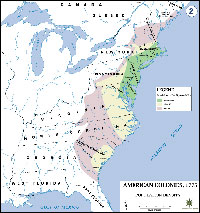
American colonies population 1775
|
|
blank |
In June 1775, the troubles in the American colonies turned more serious when the American Continental Congress declared the setting up of their own regular army, and placed George Washington in charge as Commander in Chief. The aim was to coordinate the existing states militia with new volunteers and irregulars to press the English crown for a measure of independence. The American War of Independence would last from 1775 to 1783.
When the 13 tobacco colonies in mainland America were fighting for independence, the sugar colonies of the West Indies stayed loyal to the crown. Both industries depended upon slavery for their labour.
Alexander Cumming invented the first flushing water closet. This was important because it led to the introduction of a water-borne system of sewage disposal. As it very slowly became adopted, it led to a need to deal with sewage in a new way.
|
|
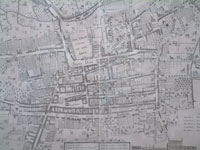
Part of Warren's map
|
|
1776
|
Thomas Warren junior updated and re-issued his father's map of Bury, produced first in 1748. This edition would show new illustrations of notable buildings in the town, including the Robert Adam Market Cross, newly designed and started in 1774.
This map is best understood as a second edition of his father's work. It looks much the same, but includes important updates. The Hervey's Manor House on Honey Hill now refers to the "late" Earl of Bristol, and the coats of arms of the gentry were changed to reflect current owners.
The new butchers shambles is shown, as is the new Quaker Meeting House on its present site. At this time St Johns Street was still called Long Brackland all along its length. Woolhall Street still does not exist as the Woolhall was still standing at this time.
This map was on sale for four shillings, and is the most familiar of Warren's maps, being the version reproduced for sale in Moyse's Hall Museum today. The map can be examined here : Thomas Warren's 1776 Map
In Ipswich, Thomas Page, a bookbinder, had got hold of copies of John Kirby's 1736 map of Suffolk, which he advertised for sale. Illustrating some of the cut throat methods of the time, he announced that the revised and corrected map produced by Kirby's sons in 1766 was 'a pirated or pretended survey'.
From 1774 to 1776, the Angel Hotel was rebuilt more or less into its present appearance in red brick. Inns of various forms had stood on its site since at least 1282, when an agreement was made by Abbot John and the convent of the abbey to let property here as a taberna.
Round the corner from the Angel stood another important old inn called the Six Bells. This stood on the corner of Churchgate Street facing Chequers Square. Today this building houses the Masonic Lodge. The Six Bells had traded as licensed premises since at least the 1680's. In 1776 Mathias Otley went into partnership with its Landlord Mr Anderson to start a Post Chaise business at the inn. Anderson also took over the nearby Coffee House of Mrs Letitia Rookes on her retirement. He made it a Coffee Room and Reading Room for the Six Bells. This Coffee House stood between St James' Church and the Norman Tower. The Six Bells prospered and by 1818 was an important Coaching Inn, along with the Angel.
In 1776, William Dalton opened a bank on the Cornhill at Bury St Edmunds. Like John Spink, he was already a businessman, but in this case Dalton was a Wine Merchant. This small bank never failed, but was taken over in 1794 when Dalton died.
At Ickworth Capability Brown received his final payment of £581 for his work on landscaping the park and planting up many clumps of trees which still exist. The family were then living in Ickworth Lodge, so the work of Capability Brown was focussed on this house at this time. What other works Brown carried out is unclear.
In June 1776 Arthur Young the well known agricultural writer from Bradfield Combust, went to Ireland where he travelled widely. In 1777 he became the agent to Lord Kingsborough on his Irish estate. This stay would result in him publishing his "Tour in Ireland" in 1780.
|
|
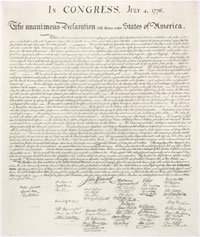
American Declaration of Independence 1776
|
|
blank |
Attempts by the Americans to persuade the English crown to give them some measure of representation in Parliament resulted only in Congress being declared traitors and the states declared to be in rebellion. The Americans responded in 1776 by formally declaring their independence as one new nation — the United States of America — claiming their own sovereignty and rejecting any allegiance to the British monarchy. George Washington now had 20,000 men at his command to back this up. The French began to secretly support America by supplying arms and money. What began as a small cry of "No taxation without representation" would develop into a global war in 1778.
Adam Smith wrote in his "Wealth of Nations", that the sugar crop from St Kitts was worth more than the whole tobacco output of the 13 American tobacco colonies. Much of the labour for these industries was provided by slaves.
Thrushes and Blackbirds were killed in great numbers by the harsh winter weather in 1776.
|
|
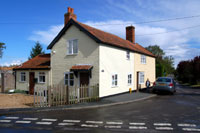
Bloomfield's birthplace
|
|
1777
|
At the age of eleven, young Robert Bloomfield went to work as a farmer's boy at Sapiston, on the farm of his uncle by marriage, Mr William Austin. His four years on the farm, despite his lack of strength, were to be the basis for much of his poetry in later life. He was born in 1766, in the small village of Honington, but the family were poor and overcrowded, and he was lucky to get the job with his uncle, living-in at his farmhouse near the watermill and church at Sapiston.
A parliamentary report of 1777 recorded that the Bury St Edmunds workhouse in College Street could accommodate 250 inmates. It was originally adapted for 200 persons in 1748.
|
|
1778
|
James Oakes, a prominent Bury entrepreneur, started his diaries, which he kept up until 1827. James Oakes was 36 years old and had been a yarn merchant for 16 years. He was a member of the corporation, Alderman and a trustee of all the town's major charities.
In 1778 he built 12 cottages next to his wool combing sheds in St Andrews Street to attract labour by offering the workers and their families homes to live in.
|
|
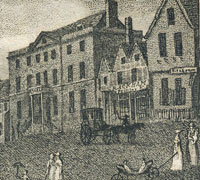
Rackham's shop by Geo. Quinton
|
|
blank |
In 1778 John Rackham finished his apprenticeship and immediately rented an empty house on Angel Hill, adjacent to the Angel Hotel, and facing the Abbey Gate. Here he set up as a stationer, printer and bookbinder, selling books and musical instruments. Within a year he had established his Public Circulating Library, and by 1781 he was advertising 1600 books to be lent out for reading at 1d a night, 4s a quarter, 7s for 6 months or 12s a year.
By 1803 Rackham claimed he had 6,200 volumes available for hire and that his was the largest library for circulation in Suffolk, Norfolk, Cambridgeshire and Essex. It was John Rackham who commissioned Edmund Gillingwater to produce his "Historical and Descriptive account of St Edmund's Bury" which Rackham published and printed in 1804. It contained this view of the Angel Hill by George Quinton. Rackham's shop is given prominence.
John Rackham died in 1821 and his wife sold the business to Thomas Cautley Newby.
In 1778 the French declared war on Britain as part of their campaign to assist the American struggle against the British crown. They would soon be joined by Spain and Holland, who were both allies of France at this time. Over time the British would sign treaties with several German states who would eventually supply up to 30,000 troops to fight on the British side.
Inspired by the Prussian army of Frederick the Great which carried out manoeuvres where units "fought" against each other and who became the standard by which other European armies measured themselves, the British decided to hold mock battles themselves.
Motivated at the time by fear of invasion from France, a number of training camps were established in southern England to allow raw militia and regular troops to train for what seemed an inevitable clash.
In 1778 Downham Hall, together with the 3,134 acre Santon Downham estate was sold by Ann Wright to Charles Sloane, the 1st Earl Cadogan. The Downham estate included some chalk seams which were dug into for gunflints made from their top quality black flint layers. Cadogan is credited with later introducing these gunflints to the Board of Ordnance, for use by the army.
|
|
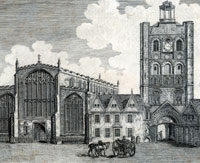
St James Church
|
|
1779
|
Richard Godfrey published this view of St James's church, Bury St Edmunds, on March 1st, 1779. It shows the tympanum above the archway in the Norman Tower, which would be removed in 1789 to allow haycarts to pass through. The tower also has a turret on its roof, and a public clock. The house between the church and the Norman Tower would become well known as Letitia Rooke's Coffee House.
|
|
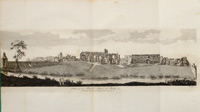
Ruins of the Abbey of St Edmund - R Godfrey
|
|
blank |
Richard Godfrey of 120 Long Acre also published this view of the Abbey Ruins in April, 1779. It has been suggested that this view is based upon sketches from about 50 years earlier, but the view seems to be extremely detailed for a reproduction. Although this view appears full of ruins, in fact it is a very restricted view of just the Abbot's Palace from the Dovecote to the north wall, and is a much more narrow view than that published by the Bucks in 1741.
A closer view of this engraving can be seen here: Close up views of Godfrey Engraving
One of James Oakes's first diary entries recorded that Maria, his eldest daughter was innoculated against the smallpox. Edward Jenner was developing the use of cowpox innoculations as a preventative against the smallpox in humans.
The Angel was remodelled to more or less its present appearance.
Late in 1778 Arthur Young had returned from his stay in Ireland, and by January 1779 was back at Bradfield Combust. He took over a 400 acre farm on the estate, and worked at it for the year.
|
|
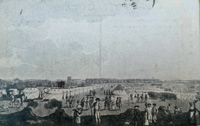
The Camp at Fornham
|
|
blank |
In 1779 Henry Bunbury published a print entitled "A Visit to the Camp" which showed fashionable young ladies enjoying a visit to one of the encampments of troops set up across the country for fear of a French invasion. Bunbury's caricatures of military subjects reflect the period when he was actively connected with the Suffolk County Militia, more especially when, in 1778, he was in camp at Coxheath in Kent during this time of the war in America. Lady Ann Cullum wrote of visiting two such camps just outside Bury St Edmunds. One was for "Horse", ie Cavalry troops, and one for the militia. One camp was located at Fornham St Martin.
Vice Admiral Augustus, 3rd Earl of Bristol, died in 1779. He had no legitimate heir, and so was succeeded by his brother, Frederick, (1730-1803). Frederick, as only a third son, had entered the church, and in 1768, had obtained the Bishopric of Derry. He now became known as the Earl Bishop, Frederick Augustus Hervey, 4th Earl of Bristol. He was popular in Ireland, where he lived, and also very rich, as Derry earned him £20,000 a year, on top of the Ickworth income. He was interested in art and architecture, becoming a great collector and builder. He visited Ickworth infrequently, although after 1882 he left his wife there while he returned to building in Ireland and travelling in search of artworks to collect.
Nutmeg Hall or Great Saxham Hall, as it was properly known, burnt down in 1779. It was originally built for Thomas Eldred, a spice merchant in the reign of Elizabeth I. It would be rebuilt in the 18th century palladian style over the next twenty years, and Great Saxham Hall still survives today. As for Little Saxham Hall, it had already been demolished in 1773, and only remains of walls and a moat survive today, situated nearby a private house called Crofts Place.
|
|
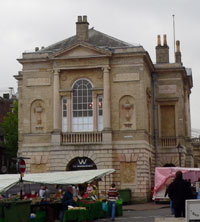
The Market Cross of 1780
|
|
1780
|
In 1583 the old market cross was replaced by a "fayre large house for cornsellers." In 1608 the great fire of Bury St Edmunds caused the ruination of this market cross, as well as 160 dwellings and 400 adjoining structures. By 1620 an elaborate three floor timber framed structure was built on the site to replace it.
By 1774 it had been decided that a town of Bury’s stature demanded a more dignified building and the fashionable London architect Robert Adam was commissioned to design a replacement. Like the building it replaced the ground floor was still open to the road and used for the corn exchange. The ground floor remained open to the elements until it was enclosed in 1840.
Adam’s Market Cross, completed in 1780, still stands today and its façade is adorned with carvings of theatrical masks and musical instruments.
|
|
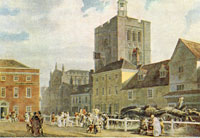
Norman Tower and Chequer Square
|
|
blank |
This view of the Norman Tower and Chequer Square was painted by Michael 'Angelo' Rooker in, or about, 1780. On the left is the Six Bells Inn, which survives today as the Masonic Hall. The Norman Tower is graced by a bell turret on the top, while a large public clock is shown on its western face. The Chequer Square is fenced off from the roadway, along which is passing a large cart of timber.
Rooker was born in London, becoming a student of Paul Sandby, who is often called "the father of the English watercolor" because he made so many technical advances, and influenced so many students. It was Sandby who nicknamed Rooker 'Angelo'. By 1780 Rooker had turned to drawing and watercolor while employed as a scene painter at George Colman's Haymarket theater, in London. The original picture is in the Victoria and Albert Museum. Rooker is known to have visited Bury in August, 1796, so this attributed date of 1780 may be incorrect.
From about 1780, Sir Thomas Cullum practised surgery and medicine from Consulting Rooms in Northgate Street. Many of his remedies would seem dangerous and frightening to us today. The Cullum family lived at Hardwick House in Hawstead.
|
|
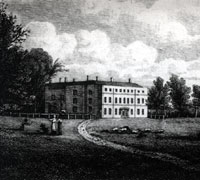
Barton Hall c1819
|
|
blank |
The Bunbury family lived at Great Barton Hall. Sir William Bunbury had inherited the estate in 1746. His son, Thomas Charles Bunbury, was a great horse enthusiast and together with the Earl of Derby wanted to start a new horse race. When it came to naming the race, the choice was between the Bunbury and the Derby, and Lord Derby won on the toss of a coin. However, the first Derby was won by Diomed, owned by Bunbury. Diomed Drive in Great Barton commemorates this great horse.
Charles's brother was Henry William Bunbury, the celebrated painter and cartoonist. Some of his caricatures may be seen today in Moyse's Hall Museum in Bury St Edmunds.
In 1780 the house in the Horsemarket, (St Mary's Square), the home of the Jervers sisters was acquired by Richard Cooper in order to safeguard its use as a Methodist Meeting Place. In 1811 the house was demolished and replaced by a Methodist Chapel, and remained in this use until 1878.
The following advertisement appeared on 6 May 1780, in the Norfolk Chronicle:
"White Swan Inn, St Peter's, Norwich.
Norwich and London New and Commodious Flying Post Coach, in seventeen Hours, through Bury and Sudbury, sets out from the above Inn every Sunday, Tuesday, and Thursday Nights, at Ten o'Clock, the Cross-Keys Inn, Wood-street, Cheapside, and Plough Inn, Princes Street, Soho, London, and returns from the said Inns every Monday, Wednesday, and Friday Nights, at Ten o'Clock. To carry Six Inside Passengers, at One Pound One Shilling each; allowed 14 pounds weight of Luggage, and all above to pay One-penny Halfpenny per Pound.
The Proprietors will not be accountable for any Parcel above 5 Pounds Value, unless entered as such, and paid for accordingly.
Performed (if God permits) by T. TILBURY, Norwich, J. READ, Botesdale, J. FOSTER and Co, London."
Exactly where the coach stopped in Bury is not stated, but by 1783, the "Norwich Mercury" coach was using the Three Tuns in Crown Street for these stops.
The Tollgate Inn was recorded in the newspapers because of a violent incident between a soldier and a local, a Mr Larst of Fornham St Martin. The Chatham Marines were in the Tollgate and one of them irritated Larst by continual drumming, whereon he attacked the marine with a knife. The landlord was Titus Manning, who was still there in 1815. The Tollgate had 30 acres of land attached to it, and Manning was a farmer, as well as a landlord. He also farmed at "Mare Maids Pits", or as it was later known, Mermaid Pits. These old sand or marl pits were waterlogged and lay just across the river, now swallowed up by settling ponds for the Sugar Beet factory.
In 1780 Arthur Young published his work on a Tour of Ireland. This was very well received in both England and Ireland. Since returning from Ireland in 1778, Young had been farming at Bradfield Hall, his family home.
|
|
1781
|
In 1781 Arthur Young of Bradfield Hall recorded in his autobiography that he had "a controversy in the 'Bury St Edmunds News', with Capel Lofft esq., on the proposal, which originated with the Earl of Bristol, for building a 74 gun ship and presenting it to the public." Young wrote a paper in support of the Earl's proposal which the Earl had reprinted and distributed. Lofft attacked the scheme as unconstitutional, "and a paper war ensued which lasted for some time, and was afterwards published."
In 1781 Capel Lofft had inherited Stanton Manor from his uncle, Edward Capell. He was a lawyer, as well as a landowner now, but he was far from being a member of the establishment. He was strongly against the American War, which had started in 1776 and would continue until 1783. Later he would support other radical causes, including being a supporter of Napoleon Bonaparte. Despite his opposition, the proposal to buy a warship actually came to fruition in 1782, following a public meeting at Stowmarket.
|
|
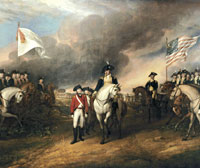
Surrender of Cornwallis
|
|
blank |
The Cornwallis family had owned the manors of Culford, Ingham and Timworth since 1659, and would remain in the family until 1823. In 1781, Charles Cornwallis was the second Earl and sixth Baron Cornwallis of Eye, and a Lieutenant General in the British Army in America.
New York City was occupied by about 10,000 men under General Sir Henry Clinton, the British commander-in-chief in North America. The British under command of John Campbell had been totally defeated in West Florida at the Battle of Pensacola on May 10, 1781. Cornwallis had been campaigning in the southern states. He had enjoyed considerable success, but his army of 7,000 were forced to give up their control of the South and retreat to Yorktown for supplies and reinforcement after an intense two-year campaign led by the brilliant American General Nathanael Greene. Greene had gradually worn down the British numbers through avoiding direct battle in a war of attrition. Under instructions from Clinton, Cornwallis moved the army to Yorktown in order to be extracted by the Royal Navy.
In the late summer of 1781 when George Washington and Rochambeau heard of Lord Cornwallis’s encampment in Yorktown, they raced southward from New York to link up with the French fleet under de Grasse in Chesapeake Bay. Washington arrived just in time to bottle-up the British, who were anticipating reinforcements that never came from either General Clinton or the British fleet.
General Washington commanded the Americans, Lieutenant General de Rochambeau commanded their French allies and Major General Lord Cornwallis commanded the British. Some 6,000 British troops were surrounded by 8,800 Americans and 7,800 French soldiers on 28th September 1781.
The stranded British forces in Yorktown were outnumbered by a two-to-one margin and they were then subjected to heavy fire as work began on a siege line. Offshore, the French fleet effectively blocked aid from Cornwallis while Washington made life unbearable for the British troops with three weeks of shelling. Cornwallis waited for Major General Clinton to sail from New York to help him, but Clinton was delayed. An attempted breakout across the York River to Gloucester Point failed due to a severe storm. With no sign of Clinton’s relief and with inadequate supplies of artillery ammunition and food, on 19th October 1781 Cornwallis’ army marched out of Yorktown and surrendered. The surrender of Yorktown by the British in 1781 signalled impending victory for the Americans in the War of Independence, and terms were settled in 1783. The reputation of Lord Cornwallis remained extremely high at home, as no blame was attached to him for the loss of Yorktown or the colonies.
|
|
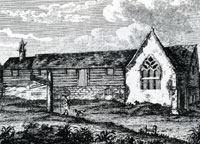
St Petronella's Hospital 1781
|
|
blank |
This print of St Petronella's Hospital was published by Godfrey in 1781. According to Yates's Antiquities, second edition of 1843, it may have originally been known as St Parnell's. It shows the large window which now stands in the wall of St Nicholas Hospital in Eastgate Street. Founded with with the original purpose of housing female lepers, by 14th century it took in lepers of both sexes. By the 15th century its duties included helping the poor. Still standing in 1804, it was demolished later in the 19th century.
One interesting point about this print is the signpost, which indicates the way to London. This probably pointed towards the Sicklesmere Road and Sudbury, which was the direct route.
|
|
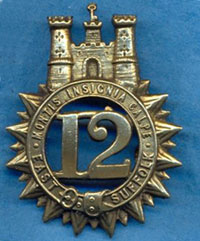
Twelfth of Foot badge post 1782
|
|
blank |
The 12th Regiment of Foot was stationed in Gibraltar for 14 years from 1769 to 1783, and was involved in the Siege of Gibraltar by the Spanish and French from 1779 to 1783. On 17th November 1781 the Siege was broken by a Grand Sortie and its main body was 12th of Foot.
For services in the siege the Regiment took the arms of Gibraltar as its crest and the Castle and Key were part of the cap badge and colours from then on. The badge remained in use when it became the Suffolk Regiment, and the design remains as part of the Royal Anglian Regiment badge today.
In 1878 when a new Depot was built at Bury St Edmunds it was known as Gibraltar Barracks.
Robert Bloomfield moved to London from Sapiston to live with his brother George, and to follow him into the trade of shoe making. He would never again live permanently in Suffolk, although he would become famous as the poet who wrote "The Farmer's Boy."
|
|
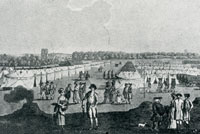
Camp at Fornham St Martin
|
|
1782
|
With thoughts of war in the air, local volunteers held this encampment for training purposes at Fornham All Saints, in the fields opposite the parish church. Such camps were to become an annual event, and traces of them sometimes remain in the landscape today.
In 1782 the 12th Regiment of Foot became the East Suffolk Regiment.
|
|
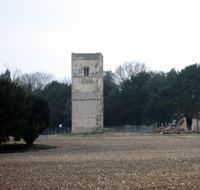 Fornham St Genevieve church ruins
Fornham St Genevieve church ruins
|
|
blank |
At Fornham St Genevieve, the parish church burnt down on June 24th 1782, supposedly due to a man carelessly shooting at Jackdaws. This gave Charles Kent the opportunity to complete the landscaping of Fornham Manor as an ornamental park, and Fornham Park was born. In February 1782, Lancelot 'Capability' Brown had visited the estate, and he returned in September, 1782. His proposals were not found to be acceptable, and instead, James Wyatt was engaged to design a new house, which was built in about 1785.
Nevertheless, the road to Brandon from Bury was diverted round the edge of the estate, just as other roads were diverted round the new enclosed parklands of the gentry. Charles Kent had been born Charles Egleton, but changed his name to Kent in honour of Samuel Kent, who had purchased the estate in 1731. It then descended to the Egleton family via Samuel Kent's daughter, who was Charles Egleton's mother. In 1782, Charles Kent was knighted, and became Sir Charles Kent.
The Bury and Norwich Post was founded on July 10th, 1782, by William Greene and Peter Gedge, with offices in Hatter Street together with the printing works. For its first 3 years of life it was called the Bury Post, and would be published weekly on a Thursday, at a cost of thre'pence. This later changed to a Wednesday in 1785 to match Market Day, a good day for sales. Meanwhile William Greene died in 1784, and Gedge married Sarah Greene the following year. This newspaper operation continued until it was incorporated into the Bury Free Press in 1932, its final edition coming at the end of December, 1931.
The first edition of the new Bury Post was given away free, and its aim was to report much more local news, and to carry local advertisements. Hitherto locally published newspapers had relied upon copying news from the London newspapers, and contained little local content. The only other Suffolk newspaper at this time was the Ipswich Journal, which had been published for the last 60 years, and so was well established. Gedge aimed to serve the gentry of the west of Suffolk, and attract them by publishing West Suffolk stories.
From 1780 to 1782, the price of wool fell sharply. The Lincolnshire growers started to agitate to allow them to export their wool, something they had been forbidden to do since the sixteenth century. Wool manufacturers like Oakes objected to this, as they relied on cheap wool for their own business success. Things were left as they were until 1786.
|
|
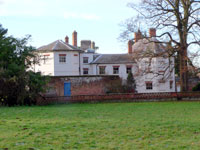 Ickworth Lodge today
Ickworth Lodge today
|
|
blank |
In 1782 the Earl Bishop, or the Episcopal Earl of Bristol, as Athur Young called him, resided at Ickworth both Summer and winter. As the great rotunda at Ickworth was not yet conceived, the Earl's home at Ickworth was in what is now called Ickworth Lodge. He became friends with Arthur Young, inviting him to dine at Ickworth every Thursday. Other local notables entertained there were Mr Symonds of St Edmunds Hill, Professor of Modern History at Cambridge, Sir John Cullum, later author of The History of Hawstead, and the Reverend George Ashby, Rector of Barrow, an antiquarian who for many years wrote a multitude of papers in the Gentleman's Magazine.
Young described Lord Bristol as "one of the most extraordinary men I have ever met with. He was a perfect original- dressed in classical adorning. He had lived much abroad, spoke all modern languages fluently, and had an uncommon vein of pleasantry and wit."
The Honourable General William Hervey was the brother of the Second Earl of Bristol. He kept a journal chronicling family affairs. In 1782 he wrote about his nephew that, "The 4th Earl, the Earl Bishop, was at Ickworth 1781-1782, and I think a result of his visit was an extension of the parish of Ickworth beyond the Linnet into Chevington." Young also wrote about the General, recording that he was one of the most charitable men living, giving away money, clothes, food and bedding to the local poor.
|
|
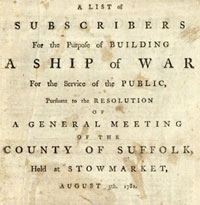 Subscribers for the ship
Subscribers for the ship
|
|
blank |
On 5th August a public meeting was held at Stowmarket attended from all over Suffolk, to consider the French War. This was to consider Lord Bristol's proposal, promoted by Arthur Young, to help the war effort by building a warship. The meeting decided that the British naval force was inferior to the navies of the European powers with whom they were at war. To this end they resolved that the County of Suffolk would "undertake by voluntary subscription to build a man of war of 74 guns for the service of the public". Every parish raised money for this appeal, and a list of subscribers was published.
Joseph Maulkin, the prominent Bury maltster and businessman, died in 1782. He had joined the corporation in 1772, and was elected Alderman in 1778. He died leaving the large maltings on the Horsemarket, other town property, and a 175 acre farm at Bradfield st George. He left four sons, three of whom would become prominent in Bury affairs.
Joseph Maulkin, the eldest son,took over the properties. He would run the Maltings and the associated coal merchants business in Sparhawk Street. He would also run the Coaching service to London and Norwich out of the Six Bells on Chequers Square.
Thomas and Robert Maulkin were wholesale grocers and wine merchants on the Market Hill. Robert also founded the Suffolk Assurance Society.
The youngest son, Solomon managed the Six Bells on Chequers Square, probably also brewing his own beer on the premises. At this time the Six Bells was second only to the Angel for the hospitality trade. Today the site of this inn is covered by the Masonic Lodge.
In 1782 the third edition of "A Description of the Ancient and Present State of the Town and Abbey", Bury's first town guide, was revised by George Ashby. Ashby was a Cambridge Don, as well as being the Parson at Barrow, and a well known antiquarian. The new edition contained Ashby's assertion that forty years earlier, (ie 1742), scarcely one of the shops in Bury was protected against the weather. By 1782 only one shop in the Cook's Row, (Abbeygate Street), remained without the addition of sash windows to protect its stock, and that was a cooper, who sold barrels. Ashby attributed this improvement to "the general refinement of the age."
|
|
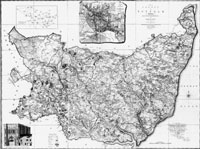
Suffolk by Hodskinson
|
|
1783
|
In 1783 William Fadden published a significant new map of Suffolk, drawn up by Joseph Hodskinson, at a scale of one inch to the mile. This was the first new map since John Kirby's "Suffolk Traveller" maps of 1736, although versions of Kirby's work had been pirated and reissued since that date. It was more accurate and detailed than Kirby's efforts, although there are some inaccuracies visible, particularly in the Hundreds boundaries.
He started work on his survey in 1776, with another surveyor, Mr A Dury and hoped to finish it in 1780. However, the death of Mr Dury, and the size of the task, led to revised plans on his own, with a new target of 1783. Joseph Hodskinson was a professional surveyor who had his home and office in London
|
|
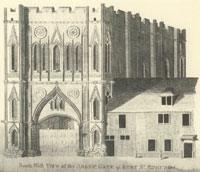 Hodkinson's Abbey Gate
Hodkinson's Abbey Gate
|
|
blank |
The original map was published in six large sheets, which, when stuck together, measured about 5 feet by 4 feet in size. Unlike other maps of its day, it carried few pictures around its edge. There was a street map of Ipswich, a triangulation diagram, and one engraving of the Abbey Gate at Bury. This shows houses built adjacent to the south side of the gateway.
The western part of Suffolk may be viewed in more detail, divided into sections, by clicking here: Hodskinson's Map of Suffolk. Use your 'Back' button on your browser to return to this paragraph.
In 1972 the Suffolk Records Society published a three quarter scale facsimile of Hodskinson's map. In 2003 the Larks Press of Dereham in Norfolk, published the map in book form.
Hodskinson's map showed that the area of St Edmundsbury at this time was rich in great houses and parks. The biggest estate was the Duke of Grafton's at Euston. Others were at Livermere, Culford, Ampton, Lord Bristol's at Ickworth; Rougham, Rushbrooke and Fornham St Genevieve. These parks were all over 125 hectares in area, as were Branches and Great Thurlow in south west Suffolk, Dalham, and Redgrave. The number of parks in West Suffolk had doubled since John Kirby's map of 1736.
Wratting Park was a large estate near Haverhill shown on the map.
The quality of spun yarn produced in the cottages of Suffolk had long been a problem for the weavers of Norwich who took most of their output. Short measures were frequently handed in, and so in 1783 the Norwich manufacturers persuaded the Suffolk yarn makers to promote an Act of Parliament which would allow them to appoint inspectors to enforce quality control over the spinners. The yarn committee held its first meeting in 1784 at the Wool Pack in Bury. The Woolpack public house was adjacent to the Woolhall, at the top of Abbeygate Street. It later became known as Everard's Hotel, and is a Pizza House today. After this meeting, wayward spinners were prosecuted and fined for trying to cheat on the yarn supplied.
We know that the workhouses were also used to provide spinning labour at this time, taking in wool from men like Oakes who had to tender for the privilege. In 1783 Oakes was bidding to supply the Melton House of Industry, north of Woodbridge, but it was won by Cuberlands, also of Bury. The firm of Harmers of Bury came second and Oakes was third. This illustrates the dominance of Bury's yarn makers in Suffolk at this time.
|
|
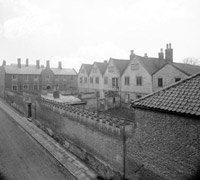
The workhouse by 1884 |
|
blank |
At the Bury Workhouse a new purpose built House of Industry was erected to the rear of Churchgate Street within the existing Workhouse Yard. This building became known as The Rookery, and in 2005 work was completed to convert this building into four unique town houses, accessed from College Street.
During the 1780's the Norwich manufacturers of camlets were opening up the export market provided by the East India Company. The firm of Ray Oakes specialised in making the fine yarn needed for these camlets.
At Honington there was a severe fire in the village, and several homes were destroyed, including the rectory.
The year 1783 was notable for some unseasonal weather, not only in Britain, but across the northern hemisphere. Volcanic eruptions in Iceland, from the Laki fissure, poured large amounts of ash and dust into the atmosphere, sufficient to cut off the normal amounts of sunlight reaching parts of the earth. This huge outpouring of lava from a 25 kilometer long fissure totalled 12 cubic kilometers of basalt and covered 565 square kilometers of land, and was the largest flow in recorded history.
There had been a severe frost on May 26th in East Anglia, damaging trees and crops, but the most severe example was a frost on 23rd June, 1783. The report prepared by the Reverend Sir John Cullum of Hardwick Hall is still studied today to show the effects that vulcanism can have across the globe. His report to the Royal Society "Of a remarkable frost on the 23rd June 1783", noted the impact on barley, oats and rye, but wheat was not much affected. Walnut trees lost all their crop. Cherries, Peaches and Hazel trees all shed their leaves,and "littered the walks as if in Autumn." Vegetables were shrivelled as if burned. However he noted that oddly, the fig and vine that grew on a wall were little affected, although fig trees in Bury were "very much cut."
The British signed the Treaty of Paris in September 1783 recognizing the United States and promising to remove all British troops from the country. The Americans had won their independence against the might of the British army and navy. Undoubtedly their alliance with the French had strengthened their position. Lord Cornwallis came home with the British forces and took up residence at Culford.
The Three Tuns stood in Crown Street, partly over what is now Tuns Lane and Lansbury House. It had become established as a coaching inn, and in 1783 became host to the "Norwich Mercury" coach which arrived here in time for breakfast three times a week from Norwich. On the return from London it stopped here on alternate trips at midnight. The Three Tuns does not seem to have developed the coaching trade to its full potential, and by the next century it seems to have given it up. Even so it could still stable 24 horses, and had its own brewhouse, continuing as an important inn.
|
|
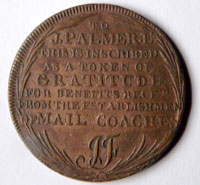
Mail Coach Penny Token
|
|
1784
|
For the last ten years John Palmer of Bath had been campaigning to improve the official post service. The Post was still being delivered by Post Boys while private carriers were able to make the same journey faster by coach.
Palmer's proposal was to replace Post Boys with lightweight stagecoaches pulled by frequently changed teams of horses. The Post Office finally agreed in 1784 to a trial run between Bristol and London. The coach, drawn by four horses and carrying mail and four passengers, slashed the journey time from a day and a half to just sixteen hours. It was the start of a mail coach service that was to cover the length and breadth of the country for the next 62 years.
Mail Coach Tokens were later issued in praise of John Palmer for pushing the proposal forward.
The winter of 1783 into 1784 was Siberian in character. The winter frost was so severe that even the tough ivy and holly trees were killed. Not for nothing has the period from 1550 to 1850 been called a Little Ice Age, but the true reason for this was almost certainly the result of the volcanic eruption at the Laki fissure in Iceland in 1783. Not only had 1783 experienced a year with a very poor summer, but the reduction in warming from the sun produced this appalling winter as well.
In January 1784 Arthur Young of Bradfield Hall founded the periodical "Annals of Agriculture, and other Useful Arts", and went on to edit the forty-six volumes eventually published as well as contributing a large proportion of their content. In his autobiography he referred to it as one of the greatest speculations of his life. This autobiography was not published until 1898, and it was edited by M Betham-Edwards. Publication of the Annals seems to have been attributed in error to 1783 in the autobiography.
For the first year the "Annals" was published monthly with "indifferent success", but was to be published continuously up to 1809. However, as usual, Young did not profit from his venture. He wrote that the constant re-issue of back numbers to complete sets for patrons, ate up all his profits. King George III took two sets every month, and contributed two articles under the pen name of Ralph Robinson, who was actually the King's shepherd at Windsor. Young claimed in his autobiography that the king travelled everywhere with the Annals, and that the King had told him, "Mr Young, I consider myself as more obliged to you than to any other man in my dominions."
Arthur Young also recorded his pleasure in meeting at Bury the two elder sons of the French Duc de Liancourt, and their escort Maximilien de Lazowski, a man from a Polish family. Again he seems to have attributed these events to 1783 in his autobiography, but one of the two brothers, Francois de La Rochefoucauld, recorded these events in his diary for 1784. In 1988 the Suffolk Records Society published the diary of La Rochefoucauld under the title "A Frenchman's Year In Suffolk, 1784." It is packed with detailed observations of life in English country society at the period.
The French party had arrived in Dover late in December 1783, and went on to London. They had intended to travel from London to Bristol, but were persuaded to make for Bury St Edmunds or Norwich. According to the Frenchman's diary, this decision was taken because it was drier in Suffolk than Bristol, and that English was better spoken in Bury than Bristol. Arthur Young recorded that the reason they came to Bury was, in fact, to meet him and to hear about English agriculture. They arrived in Bury on 7th January 1784, and soon met Dr John Symonds who took them under his wing. Symonds had a house in Bury, as well as his house at St Edmunds Hill, now called Moreton Hall. He was Professor of Modern History at Peterhouse College, Cambridge. The French party took up residence in apartments which seem to have been adjacent to the Angel Hotel.
Dr Symonds took them all to meet Arthur Young at Bradfield Hall, and Young became life long friends and correspondent with Lazowski. Francois de Rochefoucauld recorded that he very much liked Arthur Young, but disliked visiting Bradfield because Young kept an extremely poor table. But he had much more to say about Young's wife, who "is always tormenting her children and servants, and is, more often than not, bad-tempered with visitors. They say that she beats her husband...".
In June they moved in with Symonds at St Edmunds Hill.
Dr Francis Young has pointed out the following note from this visit, to illustrate local tolerance to Catholicism:
"The reminiscences of the French aristocrat François de la Rochefoucauld, who visited Bury with his brother in 1784, are also very revealing -
everyone knew what was going on when the Catholics went to mass, François recalled, but no one did or said anything because everyone got along so well. It is possible that some of the Protestant gentry may have shared in François’ own fashionable Enlightenment indifference to
matters of religion. "
In July 1784 Arthur Young took them all on a five or six day tour of Suffolk and the Essex border. They went to Long Melford and Sudbury, noting the "considerable trade in woollens and silk stuffs." Sudbury had nearly all hands involved in woollen looms, producing cloths which were "coarse and thin, a kind of double serge, good for clothes for working women." At Nayland the river was made very navigable, carrying great quantities of coal. Lazowski called it "a superb village." At Colchester they noted the castle, the theatre, and the assembly room. The cloth trade there was as busy as at Sudbury. With 500 looms, "always more work than workmen." "The cloths resemble Sudbury's, but are not so fine: they are intended for Spain and America." Lazowski recorded that they used every last ounce of short Suffolk wool, and only a little of the long wool from Lincolnshire. The cloth went to London for dyeing, and on to Spain from whence they were sent to the Central American markets.
They travelled on to Mistley and Harwich, Holbrook, Woolverstone and Ipswich. Ipswich they found "badly built, the streets narrow, without any alignment, and the road surface as bad as could be." From there they went to Woodbridge and Melton. Carrots were being grown on the sandy soils here, which were sent to London, while the poorest ones fed horses and pigs. From Saxmundham they went to visit Heveningham Hall, "Sir Gerard Wanneck's house, which is superb, the only house in Suffolk really worth seeing." They headed back via Framlingham and Stowmarket, "a town at best, no bigger than a small village, with scarcely three or four hundred houses." Hop growing was noted at Stowmarket, and on the sixth day, the tour ended back at Bury.
In September and October 1784 Dr Symonds took the French party on a tour of Norfolk. In 1785 they left Suffolk for the Midlands, North and West Country.
William Greene, a printer and bookseller in Hatter Street, died in 1784. He was the uncle of
Peter Gedge, born in Norwich in 1758, and had given Gedge a job in Bury. In 1782, Gedge had founded the Bury Post newspaper. Gedge now married Sarah Greene, William's youngest daughter, and took over Greene's business, thus strengthening his rather small newspaper business.
The Gurteen family were operating as substantial weavers in Haverhill by this time. The firm has records to show that in 1784 Daniel Gurteen took £1,000 with bankers, putting the finance in place to start up in a bigger way of business than before. Daniel Gurteen specialised in weaving a material called drabbett, which was used for
making smocks which were worn by the agricultural workers of the time. We believe that he was not actually making up finished garments at this time, but sold drabbett to other makers.
George Bloomfield moved from London to carry on the trade of shoe maker in Bury St Edmunds. He was Robert Bloomfield's elder brother, and he left Robert in London, also working as a cobbler, although Robert also had a sideline of making aeolian harps. Both brothers were born in Honington, and their mother and her other children were still there.
Around 1784, one Robert Walpole was carrying on business as a banker in Bury St Edmunds. He was a Draper, and would retire by 1791. He was competing with the banks of John Spink, on the Market Hill since 1775, and William Dalton's Cornhill bank, opened in 1776.
|
|
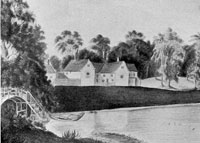
Bradfield Hall in Young's day
|
|
1785
|
In 1785 Arthur Young inherited Bradfield Hall, at Bradfield Combust, from his mother, who had just died. His elder brother, who was unmarried, agreed that Arthur should take on the property, paying him a sum by way of compensation, less than its full value. Arthur Young then decided to add a number of fish ponds to the property. His fishing parties would become well known, and are described in Fanny Burney's "Camilla".
|
|
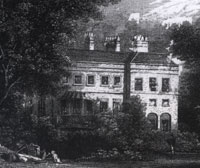
Fornham Hall garden side c1825
|
|
blank |
At Fornham St Genevieve, Sir Charles Kent began the building work on a new Fornham Hall. Fornham Hall was a grand mansion which survived in the park until it was demolished in 1951. It stood next to the picturesque ruin of the church tower. It had been designed by James Wyatt for Sir Charles Kent around 1782, to replace the old manor house. This view from the garden side of the house is dated about 1825. However it seems to represent the house before the alterations later undertaken by the Duke of Norfolk.
The first mail coach to run between London and Norwich (139 miles) began in March 1785, stopping along the way at Bishop's Stortford, and going via Newmarket and Thetford. It seems that the Bury to Thetford road was too poor for their use, so Bury had to make do with a slow connecting service from the Greyhound in Bury to Newmarket.
The mail coaches quickly became the preferred form of transport for the rather better off traveller. They charged more than Stage Coaches,but they were clean, light and fast, were strictly limited as to numbers, had a guard equipped with a blunderbuss, pistols and a sword, and were run very punctually, as both the driver and guard were subject to fines for not running to time. The gentry of Bury would soon try to get the service brought to their town.
The fast mail coach service from London to Norwich would continue until it was finally killed off by the coming of the railways. The very last mail coach to run on this route would be on 14 June 1846.
The Montgolfier brothers had succesfully demonstrated the first flights of a hot air balloon in 1783 in Paris. On 21 November 1783, the first free flight by humans was made from the grounds of the Château de la Muette (close to the Bois de Boulogne) in the western outskirts of Paris. They flew aloft about 3,000 feet (910 m) above Paris for a distance of nine kilometres. By December 1783, James Dunthorne exhibited ‘the floating air balloon’ on the Town Hall in Ipswich, but it was not flown. Only two years later, Mr. Poole launched his own balloon at Bury St Edmunds, and it attracted a crowd of thousands.
|
|
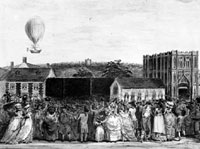
Kendall's print of Poole's balloon
|
|
blank |
The Bury Post reported as follows:
"B U R Y, October 19th 1785.
Saturday last, being the day appointed for the ascension of Mr. Poole’s Balloon from this place, the largest concourse of people assembled ever known upon any occasion. About twelve o’clock a great number of persons of fashion occupied the ground, who expressed the highest satisfaction at the process of filling the Balloon, which was conducted under the immediate inspection of Mr. Blake......
about two o’clock Mr. Poole ascended with great rapidity, amidst the acclamations of thousands, whole raptures on the occasion are indescribable, and which were returned in the most polite manner by the aerial voyager, who for a long time saluted them by taking off his hat, and waving his flag."
Mr Poole's own account concluded, "…My descent was gradual, I soon after alighted in a small piece of ground at Earl Soham, in the county, without injury either to myself or balloon. I was very hospitably received by Major Dade, who lives in that neighbourhood, and found my distance from Bury to be 28 miles, having been in the air one hour and eleven minutes.”
The Post concluded, " it was not till twelve o’clock at night that the public were relieved .... when he arrived in a post-chaise and four, with the car and balloon on the roof.
Nothing could equal the general joy manifested on this occasion; every one was eager to shake him by the hand, and the populace were not satisfied till they had drawn him three times round the Cross, and displayed a variety of fire-works, which were let off between one and two on Sunday morning."
Captain Poole was described in a print of the event, published by Jacob Kendall, as departing "from St Edmunds Bury on the 15th October 1785. The ascent of the Balloon was remarkably Fine and Gradual and continued in view for an hour, moving Eastward." Henry Bunbury was said to have drawn in the figures of the crowd on this illustration, as he sometimes did for other prints by Jacob Kendall (1741-89).
|
|
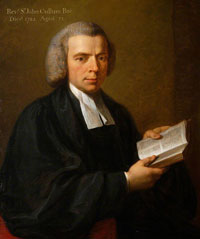
The Revd Sir John Cullum
|
|
blank |
The Cullum family had owned the estates of Hardwick and Hawstead since 1656. The 6th baronet was the Reverend Sir John Cullum, Bart., FRS, FSA, a keen botanist and antiquarian. In 1784 he had published the "History and Antiquities of Hawstead in the County of Suffolk". This book had 247 pages and four plates, and was published by J Nichols of London. It would be re-published in 1813 in a second limited edition. This work and his other botanical writings are still of interest today. The Reverend Sir John was married but had no children. He died in 1785, aged 53, and the estates passed to his brother, Thomas Gery Cullum FRS, FSA, FLS, (1741-1831).
|
|
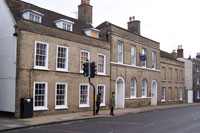
Sir Thomas Cullum's surgery
|
|
blank |
Thomas now became Sir Thomas Gery Cullum, the 7th Baronet, but he was already distinguished as a doctor and surgeon, who had a practice in Northgate Street, Bury St Edmunds. Today this address is called 113 Northgate Street or Manchester House, but at the time it would have looked very different. The house was remodelled with white brick frontage in the mid 19th century.
Upon inheriting his title and the family estates at Hawstead and Hardwick he gave up his medical practice in Bury St Edmunds.
As well as his medical knowledge, he was skilled in botany and natural history, for which he gained a national reputation in his own right. The genus Cullumia was named in his honour. This is an obscure genus of 16 plants of the compositae or daisy family, from southern Africa.
Sir Thomas Gery Cullum was also a student of genealogy and heraldry and was made Bath King of Arms.
|
|
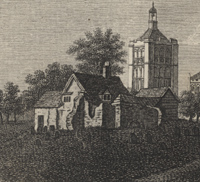
Hooper's view of Churchyard
|
|
blank |
The Norman Tower was topped out with a campanile of ten bells to serve St James Church next door. These bells were all cast as one ring at the Downham market foundry of Thomas Osborne. The bells cost £150, and they are still in place today. It is believed that there is only one other ring of ten bells surviving in the country, and this is to be found at Wisbech, in the church of St Peter and St Paul.
The Norman Tower had previously held a peal of six bells, after which the Six Bells Inn took its name. The Six Bells stood across the road where the Masonic Lodge now stands in Churchgate Street, facing Chequers Square. Years later a pub called the Ten Bells stood at 33 Whiting Street.
This engraving of the Churchyard at Bury was published in 1785, by Hooper, and shows the campanile. Note that it also shows a house built into the ruins of the Chapel of the Charnel. Contrast this view with that of Jacob Kendall, published in 1786, which shows the Charnel house in ruins.
|
|
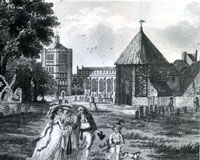
Jacob Kendall 1786
|
|
1786
|
Jacob Kendall produced this view of the Churchyard in Bury St Edmunds in 1786. It shows the turret on the Norman Tower, and there are windows in part of the ruined West Front of the Abbey, indicating that parts of it had dwellings or businesses inserted in it. Samson's Tower has a thatched roof with a weather vane, and a lean-to extension. Jacob Kendall, (1741-1789), produced several views around Bury of the Angel Hill and Abbey precincts. He was a friend of the artist Henry Bunbury, and it is thought that Bunbury added the elegant and lively figures to some of Kendall's compositions. The churchyard was long used as a place of recreation, and in 1798 it would be bought by James Oakes on behalf of the Bury St Edmunds Corporation.
Charles Cornwallis, the second Earl Cornwallis, was living at Culford Hall following his return from America, where he had been forced to surrender at Yorktown. He was well liked, and was never blamed for this defeat. In 1786 he was appointed Governor General of Bengal, and also its Commander in Chief. He resided in India until 1794, while his brother James Cornwallis, Bishop of Lichfield and Coventry, ran the estates at Culford for him.
|
|
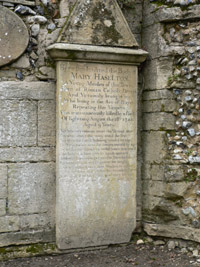
Gravestone of Mary Haselton
|
|
blank |
During this year came an incident which had a big impression on local people. This was the tragic death of a nine year old girl, while saying her prayers. Mary Haselton was struck by lightning while at Vespers, an event which seemed to question the faith of the religious people of the time. Her gravestone can be seen today attached to the Mausoleum in the Great Churchyard at Bury St Edmunds.
Dr Francis Young has pointed out that her memorial is surmounted by the letters IHS within a sunburst, which is a Jesuit symbol, and refers to her parents as 'Roman Catholics', rather than the less respectful word, 'Papists'. "The very fact that the Roman Catholic religion could be
mentioned explicitly and respectfully on a public monument was a huge breakthrough," he has written.
James Oakes of Bury took a major part in lobbying the government to tighten up the laws prohibiting the export of raw wool. Arthur Young, a well known local farmer at Bradfield Combust, led a movement to denounce this action as a conspiracy against the landed interest. He said that this was a question of the urban manufacturers against the rural producers of the raw materials. Young also highlighted the low wages that manufacturers paid to their spinners. This dispute continued for another two years.
|
|
1787
|
The Duke of Grafton's candidate was, as usual, successfully returned to Parliament for St Edmundsbury. Within a few days, his agent got his reward.
James Oakes was the Duke of Grafton's political agent in Bury, and through the Duke's influence now became Receiver General of the Land Tax for the Western Division of Suffolk. In those days such an office meant that all money collected passed through your own personal bank account until the time came to make payment to the Crown. Jane Fiske has pointed out that the sums involved could reach £30,000 a quarter. Any interest earned in this time belonged to the Receiver, and was seen as remuneration for the job. Treasurers to various charities and other bodies also saw such arrangements as quite normal at this time.
This substantial extra cashflow helped Oakes to decide to formally set up as a banker in 1794.
The corporation of Bury St Edmunds had the right to return two MP's to Parliament, and only the 37 members of the corporation could vote. A complex web of patronage and family ties had left these seats controlled by three local families. These were the FitzRoys of Euston, the Hervey's of Ickworth and the Davers' of Rushbrooke. One seat had been held by Sir Charles Davers since 1774, and this would continue up to his retirement in 1802.
|
|

Kendall's West Front
|
|
blank |
In Moyse's Hall Museum is a print, drawn and published in 1787, by Jacob Kendall of Cook Row, Bury St Edmunds. It shows the ruined West Front of the Abbey of St Edmund with dwellings built into the ruins. Remnants of these dwellings persist today in the Abbey ruins. The details in this print are confirmed by a similar drawing by John King, included in Archaelogica volume III for 1786. Samson's Tower was a stable for the Six Bells inn on Chequer Square, and remained thatched until 1863.
|
|
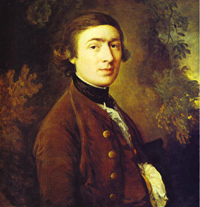
Self portrait by Thomas Gainsborough
|
|
1788
|
In May 1788 the painter Thomas Gainsborough fell ill, apparently with a chill. By August he was dead, suffering from a cancer of the neck. He was buried at Kew. Thomas Gainsborough was born in Sudbury in 1727, and he began painting while at school. By 1777 he was living in London, enjoying great success after exhibiting at the Royal Academy. In 1781 he was sufficiently famous to be commissioned to paint King George III and Queen Charlotte. His reputation grew after his untimely death, and in 1961, his house in Sudbury was opened to the public as a memorial to him. It now has a large collection of his works on show to the public.
Early in Spring 1788, Arthur Young, of Bradfield Hall, was deputed by the wool growers of Suffolk to support a petition against the Wool Bill, which aimed to grossly restrict the markets that wool could be sold into. If growers could not sell abroad for better prices, they would have to accept lower prices at home. Young published two pamphlets and travelled to London to put the case to both Houses of Parliament. But he found that Mr Fox and his supporters would hear no arguments against the Bill.
By a strange irony, Arthur Young also now began to grow Chicory on his farm at Bradfield. He promoted it as excellent food for sheep.
When the Wool Bill became law, it allowed cheaper Irish yarn to be freely imported into the country for the first time. This was seen as a victory for clothing manufacturers and a defeat for wool growers in the countryside. It would help to depress the price the growers could get for their wool locally. In contrast to the gloom of sheep farmers, bells rang in Sudbury for two days and fireworks were let off in the streets in celebration of the news. The Sudbury weavers would now be able to buy their raw materials cheaper under the Wool Act. Arthur Young was burnt in effigy at Norwich for his opposition to the Wool Act. In Bury wool combers rode in procession, but Oakes forbade his men from joining in because of the 'melancholy and oppressed state of the trade at this time.' Very little, if any, yarn could be sold to Norwich at this time. Such problems had existed in 1785 and in 1786, and had beset the industry since the onset of the American War.
Oakes also did not want to inflame local opinion, particularly amongst his rural landowning friends and relations, and may have thought that it would harm his own Suffolk yarn business eventually.
By this time, James Oakes was not just a yarn producer. His other business interests included becoming a dealer in coal, bringing in his stocks on the Lark Navigation.
|
|
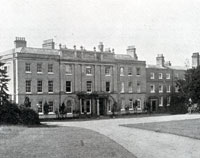 Fornham St Genevieve Hall
Fornham St Genevieve Hall
|
|
blank |
In 1788, Fornham Hall and Park passed from the Kent family into the ownership of the Duke of Norfolk. From 1769 to 1788 the area had been turned into an ornamental park in the style of Capability Brown. The ancient open field system around Fornham St Genevieve had been swept away along with the village. The watermill had been demolished, and its mill outflow turned into an ornamental lake, or as more likely termed at the time, a canal. Also swept away was the road through the old village, which went to West Stow. New roads were built around the perimeter of the emparked area. Whether by accident or design, the parish church had burned down in 1782, leaving a picturesque ruin. The Duke himself would continue to develop the Park, and would extensively alter the Fornham Hall built by Sir Charles Kent.
|
|
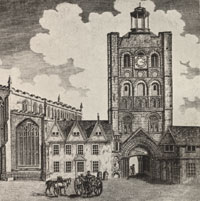
Norman Tower with tympanum
|
|
1789
|
During 1789 the tympanum of the west arch of the Norman Tower in Bury St Edmunds was removed to let hay carts pass through. This engraving, published by Richard Godfrey on March 1st 1779, shows the view before the tympanum was removed. According to William Spanton the tympanum was carved to represent the Saviour with hand uplifted in benediction of all who entered the Abbey Church. The ground level had been raised over the past 600 years by some five or six feet, to alleviate flooding, and so tall loads had difficulty passing under the gateway. As the print shows, they could not bypass the Norman Tower in the way that we can today. The building standing between St James's Church and the Norman Tower was The Widow Rookes' Coffee House. Letitia Rookes was alive when this engraving was made, but had died in 1782, aged 66.
|
|
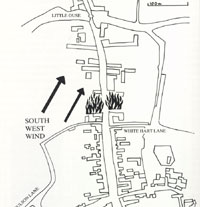
Fire at Ferry Street, Brandon
|
|
blank |
On 14th May, 1789, a disastrous fire broke out at Brandon. At that time Brandon parish was made up of two separate settlements. The smaller of the two was called Town Street, and was an agricultural hamlet clustered around the Hall, the Manor House, Rectory and church. About a mile to the west was the main commercial centre of Ferry Street, which once was the access way to Brandon Ferry, but now commanded the bridge crossing of the River Little Ouse. Ferry Street is now the main High Street of today's Brandon. The fire started just north of the Coulson Lane/Ferry Street/White Hart Lane junctions, and moved towards the river, driven by a south westerly breeze.
It is not clear how much property was destroyed, as one or two owners made succesful insurance claims, but a committee was formed a month later, who assessed the uninsured losses at £1,142.15s.10d. This committee of gentleman also decided that the cause was accidental, and so the owners and occupiers suffering the loss of buildings and their contents, were "proper objects of relief". Several houses, with barns, stables, coachhouses and brewhouses were destroyed. Some 11 families suffered losses and "eight were entirely burnt out of house and home."
The committee ordered a charitable appeal among neighbouring parishes, including Bury St Edmunds. John Spink of Bury was asked to run the appeal, a job he had done on behalf of the much smaller Norton fire, which had been a year earlier. At Norton, the collection of £950 had exceeded the losses of £600, but the Brandon collection of £590 resulted in claimants receiving only ten shillings in the pound, ie half their losses. The Brandon payout took place in July 1790.
In both 1787 and 1788 Arthur Young made visits to France, helped by his friend Lazowski, the Polish tutor and companion to Francois and Alexandre de la Rochefoucauld, and their father the Duc de Liancourt. He again travelled to France in 1789 to complete his survey of the country, leaving for Italy on June 28th.
The French Revolution began shortly after Young left France. On 14th July the people of Paris stormed the Bastille prison, which for centuries had represented the oppressive power of the monarchy. Young continued to travel Italy. He returned to Bradfield in January 1790.
The White House in Bury was rebuilt by George Anderson to become the New Assembly Rooms, standing facing the Angel Hill. The Assembly House had been converted to this use in 1714, by John Eastland, a Dancing Master. Until 1789 the Ballroom was on the second floor, and there were rooms on a third floor. In 1789 the third floor was removed, and as part of the general improvements, the Ballroom was moved to the ground floor, where it remains today.
These Rooms were to become called the Athenaeum in 1854.
|
|
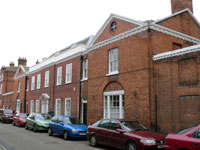
Home of James Oakes
|
|
blank |
John Soane, later to become Sir John, met James Oakes to settle the design of the new wings to be added to Oakes' house at 81-82a Guildhall Street in Bury. In 1788 Soane had just begun to build his great design for the Bank of England, and this must have influenced his choice for this work.The northern wing was specifically designed as a banking office, but he was not yet the type of retail bank that we would recognise. This did not begin until 1794.
The Suffolk Public library started in 1789 in Bury.
A new law was passed which allowed Roman Catholics to worship openly. A license was given to the Westgate Street chapel for this purpose in 1791, but it seems that public worship had been quietly going on here for many years already.
|
|
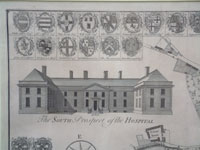
Clopton's Hospital on Warren's map
|
|
blank |
In 1789 a dispensary was started in Bury, according to Dr Cory's History of Suffolk General Hospital. This seems to have preceded the establishment of the Suffolk Hospital, which did not arrive until 1826, when an old Ordnance depot was converted in what became called Hospital Road. Thomas Warren's map of 1776 showed a prominent illustration of the "Hospital", which had two wings and was labelled as 120 feet in frontage, with elegant steps to the main entrance. Although this is an illustration of Clopton's Hospital in the Churchyard, it was not a hospital as we know it today. It was what we might call an almshouse, providing accomodation for the "deserving poor".
The dispensary may have referred to the establishment of a pharmacy in Abbeygate Street, on the corner of Whiting Street. This establishment was converted from a soap maker's shop to a pharmacy by Woolfrey Middleditch in 1789. It has remained a dispensing chemist's shop up to 2008, when it was known as Lloyd's Chemists. Twelve successive chemists owned the business, now addressed as 56 Abbeygate Street; the last two being Savory and Moore until 1993 and Lloyd's.
|
|
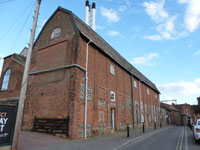
Wright's Brewery of 1789
|
|
blank |
There had been a Brewery in Westgate Street, Bury St Edmunds, throughout the 18th Century, owned by three generations of the Wright family. This building seems to be part of the Westgate Brewery which dates back to the time of Matthias Wright. High up on the gable end overlooking the Dog and Partridge carpark is a plaque which reads MW 1789, and probably indicates the date of building. Matthias was to be last of the Wrights to be a brewer as the entire premises and the brewing business was put up for sale by his executors in 1798.
Possibly because of the poor economic conditions around the threat of invasion by Napoleon it did not sell, and would stand idle until 1805, when the Buck and Greene partnership would take over, and begin to restart the brewing process.
In October, 1789, the Bury Post carried this advertisement:
"The proprietor of the ROYAL LION, from the Tower of London, returns his sincere thanks to the nobility, gentry, and the public in general, who have honoured him with their company since his arrival in this town, and begs leave to acquaint them that this noble animal still continues to be daily exhibited in a commodious caravan on Angel Hill........This grand collection consists of near thirty curious and extraordinary animals. In order that the public may not be deceived they are hereby assured that there is no other lion, neither young nor old, that travels this kingdom."
On 5th December, 1789, the stationer and print maker and seller, Jacob Kendall died, and was buried in St Mary's churchyard. William Spanton recorded his gravestone "which used to be legible on a stone next the railings at the east end of St Mary's Church". This stone recorded not only "Jacob Kendall Junior, one of the common counselmen of this Borough, died 5th December, 1789, aged 48 years", but also his father , also called Jacob Kendall, who died in 1784, aged 67 years. Jacob the elder was a shoe maker or cordwainer according to Spanton. They lived at 13 Abbeygate Street, then called Cook Row. Jacob the younger was something of an artist, and drew the Angel Hill, Church Yard, the West Front and the 1785 ballon ascent, but apparently could not draw figures. It was believed that H W Bunbury of Great Barton Hall was responsible for the figures included in Kendall's published prints.
Sir Charles Kent had only just completed the building of Fornham Hall in his new park at Fornham St Genevieve. He now sold the whole estate to Bernard Edward Howard, who would become the 12th Duke of Norfolk in 1815. Howard would make extensive alterations to Fornham Hall and the grounds surrounding it.
Also in 1789, the estate of Little Saxham was sold by the Crofts family for just over £16,000. The estate had been in the Crofts family since the 1530s, and Little Saxham Hall had been a favourite haunt of both King James I and King Charles II. The hall had been demolished in 1773, but no member of the family had lived there for many years. The estate extended down to the River Linnet, and some of these fields, excluding the site of the Little Saxham Hall, are today part of the Ickworth Estate.
In 1789, the purchaser of Little Saxham was the Marquis of Cornwallis. However
Charles, Marquis Cornwallis, would exchange it for West Stow in 1795 with Robert Rushbrooke.
At Bury St Edmunds, the Jesuit priest, John Gage died. He had built the catholic chapel in Westgate Street and run the illicit Catholic mission to Bury since 1755. Francis Young, "Ironically, the Jesuit order did not officially exist between 1773 and 1814, but this had made little difference to Gage’s
mission. When he died, the manor in Westley which his mother had given him reverted to the Jesuit Province, and would eventually fund the building of St
Edmund’s Church in 1836. Gage was succeeded by an American priest, Charles
Thompson."
|
|
1790
|
Land enclosure had taken place frequently over the years. But from 1790 to 1840 there was a spate of Acts of Parliament passed allowing large areas of north west Suffolk to be enclosed. Most of the rest of the County had been enclosed long before this time. This area covered the Breckland and the chalky grasslands of the Newmarket Downs. On private estates like Euston and Hengrave there was no need for a Parliamentary Act, as the land owners had carte blanche over their own property. There was a small area around Haverhill where Acts were also needed.
During 1790 Bury was favoured by the opening of the Suffolk Public Library. By 1793 it would be seen as a haunt of dangerous radical thought.
|
|
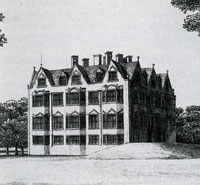
Culford Hall before 1790
|
|
blank |
This was the last year that Culford Hall would retain its Elizabethan look. Originally built by Sir Nicholas Bacon between 1586 and 1591, it was now considered old fashioned and extremely inconvenient for modern living. It was also cold and damp, which was attributed to the open central court. Earl Cornwallis was away in India, where he was making a fortune as Governor General of Bengal, and increasing his reputation by his land reforms and his military successes against Tipoo Sultan. He entrusted the work of improvements at Culford to his brother James Cornwallis, Bishop of Lichfield and Coventry , and to his cousin Charles Towsend, Baron Bayning.
In 1789 the design work for remodelling Culford Hall had been given to James Wyatt, the Surveyor of Royal Works and a well known architect. Although his plan was largely adopted, he was relieved of any further work by 1790 because he was too busy elsewhere. By 1790 work was well under way. Stonework would be undertaken during 1792 to 1794 by the firm of de Carle, stonemasons from Honey Hill in Bury St Edmunds.
In Brandon the rabbit fur production trade was slowly becoming more organised. Originally a cottage industry, it would slowly now become organised into factories. The first rabbit fur manufactory in Brandon was W Rought’s which was established in 1790. The fur, having been removed and processed, was sent elsewhere in Britain to be made into felt hats. The fur felt trade would be a major industry in Brandon for well over a century.
|
|
1791
|
From 1791 to 1794 was the height of the national mania for investing in canal building. In 1791 a committee was set up in Bury to consider building a 31 mile canal from the Lark at Bury, to the Stour and Orwell estuary at Mistley. During 1790, a suitable route had been laid out by a Scottish surveyor called John Rennie. He showed that the project would need a tunnel of 2,420 yards to go under the hill at Lavenham. The costs involved meant that the idea of a Lark-Orwell Canal died a death.
At the same time the idea of a canal to link Stowmarket to Ipswich was to be developed successfully over the next few years. John Rennie undertook a three day survey in December, 1791. James Oakes and Sir Charles Davers tried to get the Stowmarket canal extended to Bury, but its promoters refused to consider the idea. The Bury men feared that Stowmarket would grow at Bury's expense. They were correct in that Stowmarket enjoyed prosperity and growth in the early nineteenth century because of its success. The 1847 rail link would be the death of this canal as a successful business.
|
|
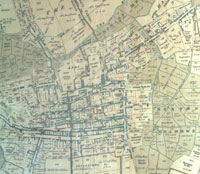
Part of Warren's map of 1791
|
|
blank |
In 1791 a third edition of Thomas Warren's Map of Bury was produced. This edition showed some of the surrounding countryside and the Town Fields. It also shows Woolhall Street for the first time, connecting the Cornhill with St Andrews Street South. Many names survive today such as Appledown Valley and Drovers Went, both now named parts of the Moreton Hall housing area. Eldo Farm is still surviving.
One interesting feature of this 1791 map is Cotton Lane, which was previously known as Scurfe Lane. On this map it is labelled "Scurfe alias Cotton Lane." This lane had bordered marshy ground on its eastern side along the river suitable only for summer grazing. Its western flank represented the rear of properties built along Northgate Street. Much of the area liable to flood remained as allotment gardens into the 20th century.
This map was totally different to the first two editions in that it extended beyond the built up town to encompass the whole of the area within the Borough boundary. This new plan measured nearly five feet square, and only one copy was made. It was a commission by the Vestries of St James and St Mary's to help them to levy the Poor Rate. This survey showed who owned what property in the Borough, and it extended right out to the borough boundaries in open fields. It also shows the parish boundaries to ensure that the rates were paid to the correct parish. It was commissioned at a meeting of the vestries in September 1790, and delivered the following year. It was the definitive town plan of Bury until Payne's map of 1833.
In the 1960's four full size photocopies were reproduced to hang in borough properties. A copy of this map hangs in the Athenaeum lobby today, and another in the Suffolk Records Office in Bury. The original hangs in Moyse's Hall Museum. The map can be examined here : Thomas Warren's 1791 Map
Much of what we know about the inns of 18th century Bury St Edmunds derives from a letter written to the Bury Post in 1791. As gentlemen often wished not to be associated with the vulgar press, they used pseudonyms, such as this correspondent, who called himself "Q". His interest was in the signs used to advertise inns and taverns.
in July 1784 Arthur Young took his French visitors on a five or six day tour of Suffolk and the Essex border. They went to Long Melford and Sudbury, noting the "considerable trade in woollens and silk stuffs." In Sudbury itself there is a record of a silk weaving manufactory on the second floor of what is now called Gainsborough's house, facing Weavers Lane by 1791. By 1851 Mr William Hill lived next door with a connecting door to this manufactory. In 1851 he employed 200 men, 400 women and 200 girls and installed a factory bell to summon them to work each day.
In 2012, Vanners Silk Weavers occupy premises in Weavers Lane, Sudbury, and the firm claims that,
"After the passing of the Spitalfields Act of 1774, which fixed wage rates in London and abolished the tariffs on imported silks, the firm of Vanners moved its silk yarn processing and weaving operations to Sudbury and Haverhill in the county of Suffolk. The originators of the Company, The Vanners Brothers, were descended from French Huguenots."
However, the Sudbury Museum Trust website paints a slightly different picture of Vanners entry to Suffolk:
"Finally there is Vanners Silk which also originated in Spitalfields and made a late move into Suffolk in the 1870s when they opened warehouses in Glemsford (1871) and Haverhill (1874). A merger with Fennell Brothers brought Vanners into Sudbury and their production is now concentrated at their premises in Gregory Street. Much of their output is tie silk produced on computerised looms which have dramatically increased productivity while assuring the highest quality."
Nevertheless there was silk weaving carried on at Sudbury by a currently unknown master and some old wool weavers had converted to silk probably also at Haverhill and Glemsford at this time.
|
|
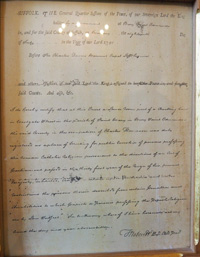
License authorising Catholic worship 1791
|
|
blank |
In 1791 the Catholic chapel in Westgate Street, built by John Gage, was the first in England to be officially licensed for worship under the Second Catholic Relief Act of 1791. The license was issued at the Quarter Sessions on 18th July, 1791, before the Justices Sir Charles Davers, baronet and Capel Lofft esq, "and others". It was for part of a the lower rooms of a dwelling house in Westgate Street, occupied by Charles Thompson. Charles Thompson SJ was the first parish priest following John Gage and took over in 1790.
Wikipedia states, "The Roman Catholic Relief Act 1791 is an Act of the Parliament passed in 31 George III. c. 32 (1791) relieving Roman Catholics of certain political, educational, and economic disabilities. It admitted Catholics to the practice of law, permitted the exercise of their religion, and the existence of their schools. On the other hand, chapels, schools, officiating priests and teachers were to be registered, assemblies with locked doors, as well as steeples and bells to chapels, were forbidden; priests were not to wear their robes or to hold service in the open air; children of Protestants were not to be admitted to the schools; monastic orders and endowments of schools and colleges were prohibited."
|
|
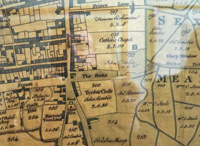
Catholic chapel on Warren's map 1791
|
|
blank |
Gage was a Jesuit who had built the chapel in 1761, and led his technically illegal Catholic Mission to Bury St Edmunds from there. Warren's map of 1791 was the first map to show the location and lands of the Catholic Chapel. This chapel would be the only centre for Catholic worship in Bury until the modern church was built in 1837.
Dr Francis Young has noted that, "Elizabeth Inchbald brought Bury’s tolerance
of Catholicism to the attention of the nation in 1791, when she published a two-volume novel entitled
"A Simple Story. " In the story, "Mr Dorriforth, (is) a Jesuit who ends up being dispensed from his vows when he inherits an earldom – Inchbald based this part of the story on Sir George Mannock of Gifford’s Hall, who was killed in a coach accident in 1783
on his way to obtain a dispensation from Rome from his Jesuit vows."
"Another key character in the story is Mr Sandford, a severe Jesuit whom Inchbald based on her own childhood tutor at Coldham Hall, James Dennett."
Inchbald was born "Elizabeth Simpson, the daughter of a Stanningfield farmer, and received an education at Coldham Hall that allowed her to become an
actress in London. As Elizabeth Inchbald she achieved fame as the greatest English woman dramatist of the eighteenth century. "
|
|
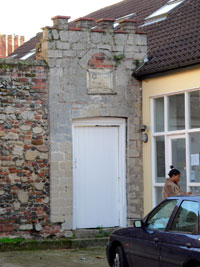
Remnants of old Wool Hall
|
|
1792
|
The Universal Directory of Britain was published in 1791, covering places in England and Wales. It was published by the patentees of the idea, at the British Directory Office, Ave Maria Lane, London. Volume II contains entries for Bury St Edmunds, and refers to events in 1792, and so must have been published no earlier than this year. It took five volumes in all to complete.
Messrs Buckley and Garnish opened the Capital Brewery in St Andrews Street, through to Guildhall Street based at great expense upon the most modern ideas at the time. They had bought up the once extensive yarn shops of James Oakes and converted them.
The Universal Directory asserted that the brewery was opened on the 12th April, 1792. "Mr Buckley was chaired by the populace through the principal streets, and brought to the front of the brewery in St Andrews Street, where he christened the building by the name of the Woolpack Brewery, amidst the shouts of several thousands of spectators assembled on the occasion."
By Autumn of 1792, only a few months after opening, the Capital Brewery of Buckley and Garnish went bust. It was located between Guildhall Street and St Andrews Street, and had before 1790 been Oakes's Yarn Shops. The brand new brewery was sold for £2,500 on December 19th, which was reckoned to be £500 less than its value, to a Morris of Ampthill for his nephew John Clark. The sale included the Two Brewers in Westgate Street and the Unicorn in Eastgate Street.
It was to this brewery that Benjamin Greene would come, around 1800, to work for Clark.
It seems from his diaries that James Oakes considered going into brewing, but he was always cautious in business, and nothing came of it.
The turnpike act allowing a toll road from Bury to Thetford and Brandon was passed by parliament. As usual, it covered a 21 year concession, so it would expire in 1813. For the last six or seven years there had been attempts to answer complaints about the state of the Bury to Thetford road. It was said that for the last 15 or 30 years tourists had avoided visiting Bury from their Norfolk tours because of this. Nevertheless there were objections to the proposed turnpike, mainly on the grounds of increased local taxes being needed to build it. In August work began to build the turnpike from the Tollgate at Bury, to another gate at Ingham and a further toll house at Elveden.
Eleven people appear to have died of Rabies when a number of mad dogs terrorised Bury.
Also in Bury, Cook Row became known as Abbeygate Street at this time. The Universal Directory, published from 1791 in five volumes, stated that
"the principal street, commonly called Cook Row, is now, new paved and lighted, after the London method, and the name of Cook Row was, by the consent of the Alderman and a committee appointed for that purpose, at a meeting held the 19th March, 1792, discontinued, and the name Abbeygate Street given to it."
The so-called London method of lighting is not explained, but by an Act of the Common Council of London in 1716, all housekeepers, whose houses faced any street, lane, or passage, were required to hang out, every dark night, one or more lights, to burn from six to eleven o'clock, under the penalty of one shilling as a fine for failing to do so. It may well be that Bury St Edmunds corporation placed such a duty upon the occupiers of homes along Abbeygate Street. Lighting did not become chargeable to the rates until after Improvement Commissioners were appointed for Bury by a Local Act of Parliament in 1811.
Gillingwater also commented upon the paving. In Edmund Gillingwater's "Historical and Descriptive Account of St Edmundsbury" of 1804, he stated in a footnote on page 164, "In the year 1792 the Cook Row, Butter Market, Churchgate Street, Guildhall Street, and many others, were new paved by voluntary subscription."
It was also recorded in the 1791 Directory that the town contains about 1000 houses, which are in general well built. There was "a spacious Guildhall, where town business is transacted every Thursday, and where the Alderman frequently attends."
"There is a market on Wednesdays and Saturdays. That on Wednesday is principally for corn."
"There are three annual fairs. The first on Easter Tuesday is now of little account. The second in October brought the Norwich company of players to attend for one month only at the elegant theatre above the Market Cross. It is always attended by the nobility etc of this and adjoining counties. The third fair is on the 1st December, very large for cattle, while the two following days are equally large for butter and cheese; the former article the best, and the latter the worst, in England."
"The post for London sets out every evening at seven o'clock, except Saturdays, and returns every morning, except Mondays. The post for Norfolk and the North, sets out every evening, and returns the following morning."
Coaches went from the Angel to the Bull at Bishopsgate Street in London every morning at six o'clock, (not Sundays). The Bell had a coach every morning at seven to Newmarket, Cambridge and London, returning the same evening. The Half Moon was the terminus for the coach every Sunday evening, and Wednesday and Friday mornings, to the Spread Eagle in Gracechurch Street, London. It also had a coach every Tueday, Thursday and Saturday mornings at 3 o'clock to Yarmouth. The Six Bells had a coach to the Swan with Two Necks at Lad Lane, London,every Tuesday, Thursday and Saturday, also apparently at 3 am. A better time was the coach to Norwich on Monday, Wednesday and Friday at 9 am.
Diligences, Waggons and Carts were also reported in great detail. In addition, small parcels could be sent to nearly every village within 15 miles of Bury, by three Ipswich Newsmen, called Lockwood, who did the Mildenhall area, Hempstead, who went to Clare, and Brett who travelled to the Wickhambrook area.
|
|
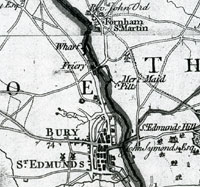
Wharf on Hodskinson's map
|
|
blank |
The Directory recorded that vessels went from Dice's Quay, Sommers's Quay, and Cotton's Wharf. Presumably these were on the Lark Navigation, where it ended behind what is now Somerfields Supermarket on the Mildenhall Road. The wharf is shown on Hodskinson's map of Suffolk of 1783, and an extract from that map is shown here. The wharf is shown as a cut from the main river to the Mildenhall Road. This cut survived, in a silted up form, until the 1960s. It was filled in with the development of what is now the UPS depot. On the map it is marked north of Bury, just north of the Friary, which is now the Priory Hotel at the foot of Tollgate lane.
Ashley Palmer had owned the Lark Navigation rights since 1757. He died in 1792, and the Lark was inherited by his widow, Susanna Palmer. She had been born Susanna Cullum, and she would manage the River Lark until she became too elderly. In 1792 she was already aged 56 years.
After listing the Gentry, the Clergy, the Physicians and the Lawyers, the Directory went on to Traders etc.. These were all listed alphabetically by surname, giving their trade, but no address was given. First listed was "Apsey Michael, (F.) Ironmonger", and "F" denoted a Freeman of the Borough. A few examples included the following:
- Apsey Michael, (F.) Ironmonger
- Cook, John (F) Maltster
- Carss, Robert (F) Banker
- Chaplin Thomas and William, Watchmakers
- Deck Philip, Postmaster
- Hailstone, James, Maltster
- Hunt John, Walking Post
- Jaques Robert (F) Maltster
- Leech, Henry (F) Maltster
- Lumley and Gudgeon, Watchmakers
- Middleditch James, Maltster
- Oakes James (F) Yarn Maker
- Oliver Laver, (F) Auctioneer
- Pearsall, Thomas (F) Gunsmith
- Parker, Benjamin (F) Gunsmith
- Paul George, Ironmonger
- Rogers Robert, (F) Silversmith
- Roberts John, Watchmaker
- Spink John (F) & Carss, Bankers
- Steward, Henry, Maltster
- Singleton Thomas (F) Stonecutter
- Thomson John (F) Silversmith
- Tilbrook John (F) Silversmith
- Tickell John Nathan, Gunsmith
- Warren Thomas, Parish Clerk
|
|
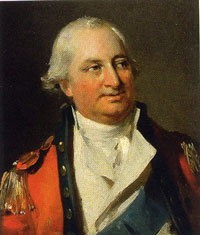
Charles Cornwallis, 1st Marquis
|
|
blank |
Charles Cornwallis, already the second Earl Cornwallis, was created a Marquis in 1792. His family estate was at Culford, but from 1786 until 1794 he was in India, as Governor General of Bengal. He introduced land reform and reduced corruption, but was best known for his defeat of Tipoo Sultan in 1791/2 and ending the third Mysore war. Cornwallis had captured Bangalore in May 1791, and settled a peace treaty with Tipoo in March 1792. Tipoo Sultan was called the Tiger of Mysore, and it had taken Cornwallis five years of war to defeat him. This enhanced his reputation, and earned him his elevation to Marquis. While he was away in India, he had Culford hall remodelled.
His brother James and his cousin Charles Townsend supervised the work. They had enlarged and refaced Culford Hall with white mathematical tiles, transforming its appearance from an Elizabethan mansion to a modern stately home. He would soon (1794) commission Humphry Repton to re-landscape Culford Park.
The fourth Earl of Bristol was also Bishop of Derry, living in Ireland and spending much of his time travelling Europe and amassing a giant art collection. His wife had been left at Ickworth, which was his ancestral home, and in 1792 he came back to stay for some time. He decided that he needed a suitable house in which to display his treasure and commissioned the building of Ickworth House. He had several architects draw up plans over the next three years, which were rejected or modified by him.
The "Travels in France" appeared in two volumes in 1792, written by Arthur Young of Bradfield Hall.
In May 1792 Arthur Young, a friend of Lord Bristol, and a well known writer on agriculture, as well as his "Travels", proposed a local horse militia. He wrote that "A circumstance in the exploits of my public career which made, perhaps, a more general impression than any other event of my life, was the proposal in 1792 for arming the property of the Kingdom in a sort of horse militia." In August he repeated his proposal in the Annals of Agriculture, and then by the end of the year issued a pamphlet called "The Example of France - A Warning to Great Britain", which ran to four editions. This pamphlet marks a turning point in Young's opinions away from reform, and in defence of the status quo.
|
|
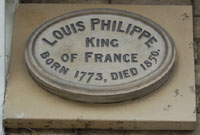
Plaque to Louis Philippe
|
|
blank |
Local people had their own examples of the troubles in France. French emigres were not unusual visitors to Bury St Edmunds. Madame de Genlis and her household were in Bury for 8 or 9 months in 1792, having left France for Bath in October, 1791 where she stayed for just three months before removing to Bury. At first they probably put up for some time in rooms adjacent to the Angel Hotel. A later location for their stay was in what is now 84 Whiting Street, in a house later owned, or leased, by the Duc de Liancourt.
Madame de Genlis was a widely admired writer, particularly on matters concerning childhood, and her work was well known in this country. She had been governess to the children of the Duke of Orleans, who were of the royal line. In leaving France she is said to have brought her pupils with her. Her young ward was Louis Philippe, and he was accompanied by his sister, Princess Adelaide d'Orleans. The story behind this plaque is that Louis-Philippe d'Orléans would eventually become France's last king. He took power in 1830 after the July Revolution, but would be forced to abdicate after an uprising in 1848. However, the young Louis Philippe supported the French Revolution in 1791 and had joined the French army in April 1792, aged 19, going to fight in Austria. Together with the army commander, both being appalled by the Terror that now reigned in France, he deserted in April, 1793 and fled to Switzerland. It would seem unlikely for him to have come to Bury St Edmunds with his sister or with Mme de Genlis.
When the Duc de Liancourt himself turned up in October, 1792, Mme de Genlis and her party left town, and according to Fanny Burney she did not even wait to pay her debts. The duke appears to have been the same person who had visited Arthur Young back in 1784, but was now known as Francois-Alexandre, Duc de Rochefoucald-Liancourt. He resumed his friendship with Arthur Young, but found England becoming uncomfortable, and he left for America in 1794. Meanwhile the de Genlis party had made their way to Switzerland.
In Great Yarmouth there were riots in late October , protesting against low wages and high prices. Six men and two women were eventually arrested and tried. One woman was transported for seven years, and the others got jail sentences.
Cock fighting and bull-baiting were still practised despite attempts to stop these activities. On November 7th 1792 the Bury Post reported the following incident:
" The inhuman and barbarous practice of bull-baiting, which has been suppressed by the vigilance of magistracy in most other towns in the kingdom, is still continued here; to the great peril of the peaceable inhabitants, and to the loss and prejudice of the families of the labouring hand.
This ferocious exercise on Monday last was nearly the cause of loss of life to several individuals, as a girl named Middleditch, about 12 years of age, was tossed by the exasperated animal, and so much hurt, that great apprehensions were entertained for her life: one Burton, a woolcomber, was also most dreadfully and dangerously gored in the thigh; and several other persons were slightly injured, the bull having got loose, and ran through the principal streets of the town, as far as Pakenham, before he was overtaken by his numerous idle pursuers."
One result of this incident was reported by James Oakes in his diary, when the Alderman of Bury called a public meeting in November to discuss the suppression of the "barbarous Custom of Bull Baiting". The 50 people present all signed the motion, and it was then taken round the town to collect more signatures.
|
|
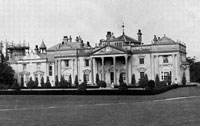
Great Saxham Hall
|
|
1793
|
The old Great Saxham Hall had burnt down in 1779. In 1793 the owner, Hutchinson Muir, who had designed the new house himself, went bankrupt. The next owner, Thomas Mills, took over the project and finished the house and grounds in a more restrained manner. The house still looks like a grand mansion to modern eyes.
|
|
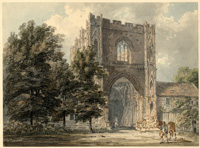
Abbey Gate by Tom Girtin 1793
|
|
blank |
Thomas Girtin was a contemporary, and friend, of JMW Turner who specialised in watercolours. He was a topographic artist, travelling about to find picturesque locations to paint. In 1793 he painted the Abbey Gate at St Edmundsbury, and this picture is now in the British Museum. On the back of the picture is the inscription:-
"Gate of St Edmond's Bury Abbey, Suffolk; trees to l and man leading horse in r with gothic gate in centre. 1793 Watercolour with pen and brown ink
© The Trustees of the British Museum"
This view is looking from within the abbey grounds, looking west, so north is on the right of the picture. The gate is roofless and open to the elements.
One interesting feature of this painting is the houses shown to the right and left of the gate. Thomas Warren's maps of 1748 and 1776 both depict a building attached to the gate on its northern side, and another slightly detached, to the south. The second building on the south side of the gate is visible in the picture, with windows just showing through the trees.
Thomas Girtin was born in 1775 and died prematurely in 1802, aged only 27. Turner is said to have declared,"Had Tom Girtin lived, I should have starved"
On January 21st, Oakes noted, with horror, that the French king was beheaded. The Reign of Terror began in France and Oakes wrote that on February 1st, France declared war on England. The Napoleonic Wars had begun, and would last until 1815 with one short break. One local advantage was that farmers could sell their produce free of foreign competition. Owners of great estates could raise their rents, and become even richer. Men like the Earl of Bristol, owners of vast estates, could now make even greater fortunes, and could afford more grandiose schemes of building.
Another beneficiary of the war was Lord Cadogan of Downham Hall, along with the inhabitants of the town of Brandon. Cadogan had bought the Downham Estate in 1778, primarily for sporting purposes. However, his land included some veins of good quality black flint, hitherto used in sporting guns. Cadogan had a cousin who was Master-General of the Board of Ordnance, and Lord Cadogan is said to have demonstrated to him the superiority of Brandon gunflints over those already in use by the army. The flint was mined principally at Lingheath, about a mile south-east of Brandon. Although it is now farmland, the area was once covered with shafts and mounds of chalk, each dug by a miner using crowbar, spade and single-pronged pick.
Philip Hayward of Brandon received the first large army order for 100,000 musket flints in 1790. The War of 1793 now demanded a constant supply of flints.
At the beginning of the Napoleonic Wars nine Brandon gunflint makers were commissioned by the Board to supply 360,000 flints a month, worth £4500
in a year. In 1793, Hayward moved into “Flint Hall” next to the present Forest Primary School to expand his production.
By 1813 fourteen flint masters were contracted to supply 1,060,000 musket flints a month, worth about £18,000 annually, giving employment to 160 flint knappers and miners. Brandon flintknappers prospered throughout the war.
|
|
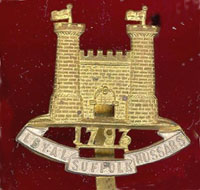
Loyal Suffolk Hussars
|
|
blank |
After he published "The Example of France", Arthur Young quickly found that his idea for local horse militias was taken up across the country. Unfortunately men without property wished to join up as well, which Young himself deplored. He wanted the militia to be for the defence of property owners, as much as for defence against foreign foes.
To meet the "whole race of reformers and Jacobins", as well as the foreign threat, Arthur Young, of Bradfield Combust Hall, formed the Suffolk Yeomanry to provide home defence against a possible French invasion. There were four troops of Light Dragoons, of which the Fourth Troop was based in Bury. This troop was commanded by Lord Charles Brome, later Lord Cornwallis.
With the French war in progress, some of the French emigres in this country felt understandably uneasy about the situation. Nevertheless, in 1793, aged 42, Fanny Burney married a French exile, General Alexandre D'Arblay. By October 1794, the Duc de Liancourt, who had kept a house in Whiting Street, Bury St Edmunds, felt obliged to sail to Philadelphia.
According to the diary of James Oakes, the first meeting of Bury's New Public Library took place on February 5th 1793. This was also a politically motivated act, as the Suffolk Public Library was now frequented by political and religious radicals. It had been founded in Bury in 1790 but the widepread fear of French radicalism spreading to England led the local Tories to feel that a Tory leaning library was now a necessity in Bury St Edmunds.
Some sectors of society were hit very badly by the war. There was a sudden and violent reduction in the volumes of foreign trade. Spinner's wages were cut in January as trade dried up, and cut again in March. Over the next few years Bury's wool and yarn industry would die, but cheap Irish yarn was already being sent to Norwich and wartime disruption just hastened the process.
By 1793 the town jail at Moyse's Hall and the County jail facing down Abbeygate Street, were both overcrowded and in disrepair. It was agreed to build a new joint jail in Sicklesmere Road, inside the Borough so that it remained under the Alderman's jurisdiction. The gallows site could also be moved from Tay Fen to the new Jail.
At Culford, Lord Cornwallis had just completed a major series of adaptations to Culford Hall, giving it the white brick facing which we see today.
|
|
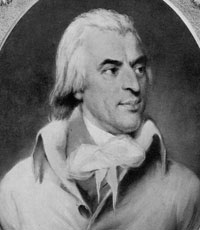
Arthur Young in 1795
|
|
blank |
Lord Loughborough was the judge at the Summer Assizes in Bury this year, and, Arthur Young being on the Grand Jury, the judge sent for Young for a chat. It was Lord Loughborough who encouraged Young to buy 4,400 acres in Paitley Bridge in Yorkshire. Young hoped to make improvements, and break the land into 400 acre farms, and sell them off individually.
Young was appointed Secretary of the Board of Agriculture (a state-sponsored body promoting improved farming standards) in 1793, a position he held until his death. He also wrote six of the Board's surveys of English counties. He was told that it was a reward for his pamphlet "The Example of France", but Young at first felt that the post cost him more than its meagre remuneration. His friends persuaded him to stay on. He had applied for the post but found the salary lacking, while the requirements of the job were onerous.
Young now felt he had to sell his newly acquired Yorkshire estate, which he did at little or no profit.
|
|
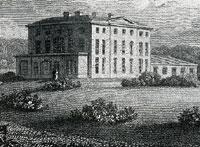
Culford Hall re-modelled
|
|
1794
|
In March 1794, Charles, 1st Marquis Cornwallis, returned in triumph from India where he had been Governor General of Bengal, and had defeated Tipoo Sultan, the Tiger of Mysore. Cornwallis had captured Bangalore in May 1791, and settled a peace treaty with Tipoo in March 1792. Although this led to peace for a time, following what may be called the third Anglo- Mysore war, Tipoo would eventually be killed in the fourth Mysore war of 1799.
Lord Cornwallis now spent a lot of time talking to the old retainers at Culford, Ingham and Timworth, his family estates. He returned to find Culford Hall remodelled and transformed from an old Elizabethan Manor House into a modern home. He estimated that a complete new build would have cost him four times the cost of the remodelling.
In 1794, after his return, Cornwallis commissioned the well known Humphrey Repton to landscape Culford Park, to make a fitting setting for his "new" house.
|
|
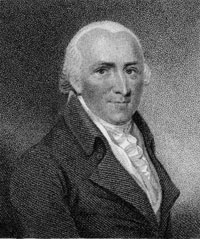
Humphrey Repton
|
|
blank |
Humphrey Repton is regarded as an important figure in the English landscape gardening movement, along with 'Capability' Brown. He is credited with first using the term 'landscape gardening', and regarded gardening as an art form.
Humphry Repton was, in fact, born in Bury St Edmunds in 1752, the son of a successful Collector of Taxes. His father moved to Norwich in 1762, and Humphry was sent to Holland for his education. However, after an unsuccessful career in commerce in Norwich, he moved to Aylsham and tried a variety of enterprises with little success. In 1788 he moved to Essex and managed to get the job of landscaping Catton Park, and became an overnight success as a landscape gardener. The key to his popularity was his use of the Red Book, so called because of its binding. This was a series of sketches to show the before and after views of his proposed improvements. Since the death of Capability Brown in 1783, there was nobody promoting this style of landscaping until Repton came on the scene.
Repton's major alteration to Culford Park was the creation of the present lake. The existing canal dating from 1624, and enlarged in 1742, was partly filled. Work continued into 1795 on digging a new canal or lake. The actual work was supervised by James Taite, who had been head gardener to Sir Charles Kent at Fornham St Genevieve.
Humphrey Repton is known to have produced a "Red Book" of Livermere Park for Nathaniel Lee Acton some time in the 1790s, when he was working at Henham. However, it is not known whether any of his ideas were ever carried through at Livermere.
Cornwallis was now appointed Commander in Chief of the Army in England. Numerous public houses were named after him, including those in Chedburgh and St Johns Street, in Bury St Edmunds. A coach on the Bury to London run was also named the Marquis Cornwallis. Deck's Post Office on the Angel Hill in Bury St Edmunds, issued a copper token with his bust and the inscription "His fame resounds from east to west." He would be made Viceroy of Ireland from 1798 to 1801, and Governor General of India in 1805, where he died.
|
|
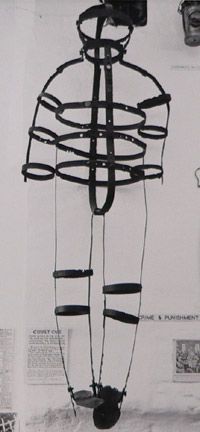
|
|
blank |
On 26th March 1794, the Bury and Norwich Post reported on the trial of John Nichols and his son Nathan for the murder of Nathan's sister. They were found guilty and sentenced to death. John Nichols was also sentenced to have his body hung in chains at the murder location, as a dreadful warning to others. The son's body was to be dissected and anatomised. The murder took place near Honington, and in 1938, during work on the Honington Airfield, a gibbet cage was discovered containing a skeleton. This gibbet was exhibited for many years in Moyse's Hall Museum as the Nichols execution. Gibbeting was abolished as a practice in 1834, and dissection of criminal's bodies by surgeons was abolished in 1832.
|
|
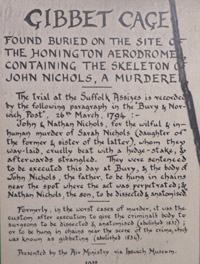
John Nichols Execution exhibit
|
|
blank |
By this time the Gages of Hengrave were living at Coldham Hall, home of the Rookwoods, who they had married into. Hengrave Hall was lent to the Canonesses of St Augustine, a religious group from Bruges. The local people helped them settle in, providing funiture and water to the empty house. The nuns arrived penniless and had to work for a living and seek charitable aid. They opened a school and their superior was Mother Mary More, a descendant of Sir Thomas More. They would stay at Hengrave until 1802.
In September, 1794, James Oakes, a yarn manufacturer and coal dealer finally decided to set up a bank at his house in Guildhall Street, Bury. The architect John Soane was just building him two new wings to his house, and the northern wing would become a banking house. Within two weeks he was issuing his own notes. The Bury New Bank relied on Gurney's Bank of Norwich for technical backing. Oakes was already familiar with what we would nowadays recognise as banking practices because it was normal for bigger businesses at this time to provide credit and buy bills at discount, and even to issue promissory notes. Up to this time his major income had been in the making of yarn, but this was coming under increasing pressure from cheaper yarn from Ireland and Yorkshire. He needed to find an alternative business, and this was not easy in a an agricultural county like Suffolk. He had considered brewing, but seems to have felt more comfortable as a banker.
Oakes sold his Woodbridge operation to a Norwich comber, a sign of hard times, and a sign of the relative success of Norfolk and Norwich at the time.
Banks already existed in Bury. William Dalton had been a banker here since before 1775, but when he died in 1794, his banking and wine business were acquired by Edmund Squire. This bank was on the Cornhill. Nearby was Spink and Carss Bank, also in business before 1775, and its draper founder, John Spink, also died in 1794. Robert Carss, his son in law was already a partner, and continued to run the bank. Samuel Cook seems to have been another Bury banker who died in 1794, but another man, Benjamin Cook, ran a banking business in Bury from 1792 to 1797 when his business failed.
|
|
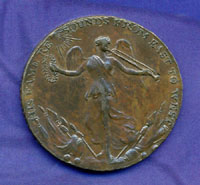
Deck's Penny Token
|
|
blank |
Trade Tokens had last been popular at the end of the 17th century, mainly because of a lack of official small change. They had finally been outlawed in 1674.
However between 1787 and 1797 there was a great resurgence in the production of trade tokens.
George III had discontinued the making of copper coins in 1775 largely because there had been a great problem with the counterfeiting of the coinage. The huge number of counterfeit coins in circulation would be spent first. Any nice, new, shiny penny would be saved. “Gresham’s Law” acknowledged this fact by stating that “Bad money drives the good money out.” The counterfeiter would gather up the new issues, melt them down, and make 2 or 3 lightweight coppers out of one good one. This just added to the counterfeits in circulation. So after about a decade there was a shortage of good small change.
Another reason existed for the rise of this "provincial coinage". The large cities often had an abundance of coin. Most of it was “bad” coin, but at least it existed. The small towns out in the “provinces” were often completely without coin.
In 1787, the Parys Mining Company, who mined copper ore in Anglesey, decided to make their own coins. They had the copper, and they had access to coining presses. Little coin of any kind found its way there. They produced Penny and Halfpenny tokens, of the correct weight, nice design, and an edge legend that stated they were payable by them. They were to prove extremely popular and were widely copied.
In 1794 P Deck issued this token from his Post Office in Bury St Edmunds. Around the edge it says "Value one penny at P Decks Post Office, Bury 1794." The reverse of the token has a bust of the Marquis of CornWallis, and the inscription around the view of "Fame" with her trumpet, states that "His fame resounds from east to west."
Such tokens were issued very widely. At Haverhill John Fincham issued a penny token in 1794 showing a handloom weaver on one side with the words "Haverhill Manufactory", and his initials and the motto, "Pro Bono Publico", on the reverse.
|
|
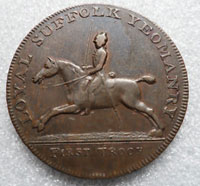
First Troop Suffolk Yeomanry
Penny Token
|
|
blank |
Even parts of the newly founded Suffolk Yeomanry felt that they needed recognition by issueing tokens. The First Troop of the Suffolk Yeomanry were based in Blything Hundred, and this token was issued with a date of 1794. Not to be outdone, the Hoxne and Hartismere Troop issued their own tokens in 1795. These tokens can be seen, together with other local tokens, by clicking here: Eighteenth Century Tokens
Arthur Young published his report entitled "A General View of the Agriculture of the County of Suffolk". It was prepared at the request of the President of the Board of Agriculture, of which Young was General Secretary, but he complained that he received no remuneration for its production.
|
|
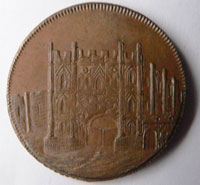
Rackham's Penny Token
|
|
1795
|
During 1795 several Bury traders issued their own half penny or penny tokens. Michael Apsey's token had a kettle and a stove on it with "Success to Trade". On its reverse was the town arms and "Payable at Michael Apsey's." Rackham had a token promoting his new library service, illustrated here. Peter Deck issued another token with his initials over a crown and the legend "The Commerce of Britain". The reverse had the town's arms and "Success to the Plough and Fleece." "Payable at P Decks Post Office Bury" was engraved around the edge.
|
|
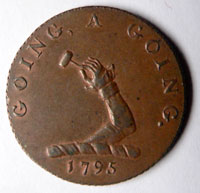
Charles Guest, Bury Auctioneer
|
|
blank |
Charles Guest, an auctioneer had a token showing an arm holding a hammer with the legend "Going a going". On the reverse it says "Payable at Charles Guests Auctioneer Bury" around a picture of Fame with her trumpet.
The Ironmonger, James Goers simply stated "Payable at James Goers Ironmonger Bury" on one face of his token. The reverse showed the Bury Town coat of arms with the motto "Success to the Plough & Fleece", the same as on one of Deck's issues.
These tokens started life as a substitute for small change, but soon became collectible items of their time. Traders used them to promote the business by giving them to friends and business partners, and while many today are well worn, others have probably never been in circulation.
These tokens can be seen, together with other local tokens, by clicking here: Eighteenth Century Tokens
On April 13th James Oakes noted in his diary that there was a rumour that there would be "an intended riot in our markets next Wednesday." Sure enough, on Wednesday, April 29th, at about 10am, the populace seized the butchers' meat, and forced them to sell them off at prices set by the people themselves. Some meat was taken away with no payment. The Justices met at the Guildhall, and swore in 40 additional constables, before marching to the market to read a proclamation of protection for the tradesmen. In the afternoon about 50 gentlemen paraded on horseback to intimidate the protestors. At 7pm about 150 or 200 gentlemen and farmers rode their horses around Bury's streets for an hour. After being stoned by onlookers, they returned to the Guildhall. The magazine of the West Kent militia next came under threat, and a guard of 50 men was placed. The Riot Act was read at 10 pm and the crowds dispersed for the night, leaving 50 West Kent and 20 West Norfolk Militia to guard the Guildhall overnight. The following Wednesday "The Town perfectly peaceable."
On June 1st, 1795, James Oakes and the other Master Yarn Makers were forced to grant their wool combers a wage rise, but they would only pay an extra penny a pound for combing Super Wool, the finest work. On June 8th the town's bricklayers and their labourers 'all turned out' to demand a raise of fourpence a day. War time price rises were forcing up wage demands.
By September, James Oakes had given up on the yarn trade and resigned from the Yarn Committee.
On October 30th the colours of the 4th Troop of the Suffolk Yeomanry Cavalry were presented in the field and consecrated at St James' church. Lord Brome then led the troop on exercises, followed by a dinner at the Assembly Rooms, with loyal toasts and songs "well adapted to the day." The 4th Troop were based on Bury St Edmunds, drawing membership from Thingoe and Thedwastre Hundreds.
Highway robbery was a particular problem at this time. Many people were robbed on the 14 mile stretch from Bury to Newmarket, the main route to London. Oakes joined in the call for armed guards to be put on the mail coaches, but the problem persisted for the next few years.
Since the 1730's the Royal Mail service from Norwich to London had come, first by Post Boys, then in the last few years, by coach, to Bury's Greyhound Inn. This inn was in the Buttermarket, preceding the Suffolk Hotel on the same site. These coaches were the fliers of their time, and reached the Greyhound at nine thirty in the evening, and returned by four thirty next morning. A horn was sounded upon their approach, and fresh horses and mail would be ready as they rode into the yard.
At this time passengers would usually travel by stage coach to London. In 1795 the Greyhound Inn on the Buttermarket, was home to the "Marquis of Cornwallis" coach, setting out three times a week to the Saracens Head in Snow Hill. The Marquis was advertised as "a new and elegant long coach, being as near as possible, a pattern taken from his Royal Highness, the Prince of Wales's Long Coach." This coach would survive into the coming of the railway to Bury in 1846.
Inns had a legal obligation to provide hospitality to travellers at any hour of the day or night at this time. They also had to provide billets for soldiers as needed. James Stone, landlord of the Fox in Eastgate Street, was fined the large sum of £5 for refusing to take in a drummer of the Londonderry Regiment of Foot. The fees received for billetting soldiers was considered too mean by landlords, particularly in view of the trouble that they could cause. The Fox remains as a large important inn today.
|
|
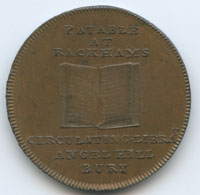
Rackham's Library Token
|
|
blank |
In 1795, according to G V Heap, the New Public Library was started in Bury as an alternative to the Suffolk Library. These were subscription libraries which would carry books, newspapers and pamphlets, usually with a particular political bias. The existing Suffolk Library supported the Whiggish cause, and Rackham's New Public Library was the home for Tory supporters. The token illustrated here certainly is dated to 1795, but according to the diary of James Oakes, the first meeting of the New Public Library took place on February 5th 1793. The token shows an open book and the legend "Payable at Rackham's circulating Library, Angel Hill, Bury". The Obverse shows a view of the Abbey Gate directly opposite to Rackham's premises.
|
|
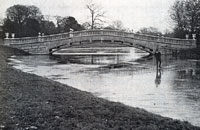
Iron Bridge of 1795
|
|
blank |
Humphrey Repton completed the decorative and ornamental canal in Culford Park for the Marquis of Cornwallis. The work was supervised by James Taite, who had been head gardener to Sir Charles Kent at Fornham St Genevieve. He had also worked on Livermere park for Nathaniel Lee Acton. James Taite died at Culford Hall in December of 1795.
The canal or lake at Culford Park was finished off by an iron bridge on the main route into the Park which at this time was from West Stow. As the famous Iron Bridge in Shropshire was only erected in 1775, this would make the bridge at Culford Park the second oldest iron bridge in the country.
In 1795 the Marquis of Cornwallis finally managed to add West Stow parish to his Culford Estate. He exchanged it with Robert Rushbrooke for part of Little Saxham. At West Stow he added 3,047 acres to his estates, and timber valued at £2,800. West Stow made him an annual income of £700. He would purchase the adjacent parish of Wordwell in 1799.
Robert Rushbrooke had his own plans to consolidate his estates. Rushbrooke's acquisition of Little Saxham was part of a plan to secure the old hall at Rushbrooke, which had probably belonged to his ancestors. Robert realised that Lord Bristol was heir to the ownership of Rushbrooke Hall, but that Little Saxham was adjacent to the Bristol estate. When Bristol inherited Rushbrooke in 1806, negotiations proceeded and in 1808 it was agreed to exchange Saxham for Rushbrooke. From that time on, Bristol owned much of Little Saxham.
The Earl Bishop, Frederick Augustus Hervey, Fourth Earl of Bristol, and Bishop of Derry, finally began building his extraordinary new house, the Rotunda at Ickworth. He had pored over plans for three years, never satisfied, and changing his mind often.
His friend, Arthur Young, of Bradfield Hall, did not understand why the Earl wanted to build at Ickworth. In his letters to Young, he had referred to it as "the foggy, fenny atmosphere of Ickworth", preferring the invigorating air of Downhill in Ireland. Young also wrote that the Earl "would often tell me that he should never be such a fool as to build in so wet a situation." It was believed that as the Earl must inherit Rushbrooke, he would wait till that time, and if he built at all, would do it there.
"This eccentric man built in Ireland a large and very expensive round house, on a plan as singular as himself; and, what was more extraordinary, a repetition of it at Ickworth," wrote Young.
Young also reported that Lady Bristol "used to call it a stupendous monument of folly."
The final plan was so ambitious, with 700 feet length on the ground floor, and a central rotunda and dome, that construction was never finished. Work began in 1795, continuing until the Earl Bishop died in 1803. Before work began the Earl left England, and he never saw it again. He refused to set foot back in England till it was finished and furnished with all the goods and artworks he had collected in Italy.
His son finally re-started building in 1821, eventually moving into the east wing during 1829. The west wing remained empty and unfinished.
|
|
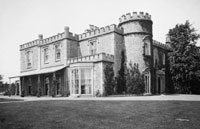
St Andrews Castle
|
|
blank |
Building on a smaller scale, but with similar grandiose pretensions, Ezekial Sparke, Attorney at Law, created St Andrews Castle in 1795. It qualifies as Bury's only castle, but the crenellations were merely for show. Sparke was attorney for James Oakes, among others, and in 1795 this was one of the very first upper middle class dwellings to be built outside the old town wall. The old Ditchway now became called St Andrews Street. In 1749, Horace Walpole had started to rebuild Strawberry Hill, his home in London, as a Gothic revival castle. This led to a national interest in Gothic architecture, and St Andrews Castle was part of this revival.
In 1795 John Benjafield came to Bury from London, and within a year had married the niece of Dr Symonds of St Edmunds Hill, nowadays known as Moreton Hall. Benjafield allied himself with Symonds in political quarrels with James Oakes, eventually ending with a scandal in 1811.
In 1795 an Act of Parliament was passed for improving drainage of the Middle and South Levels of the Fens, and for improving the navigation of several rivers. One of these rivers was the River Lark, and a new set of tolls was laid down to pay for improvements. Coal was now to be charged at 2/8 per chauldron, including groundage.
Groundage was the charge made for storing coal at the Wharfside. Mrs Susanna Palmer, the proprietor of the Lark Navigation, had set up a coalyard at the Fornham Wharf, which was divided up into individual plots for use by the various coal merchants of the town.
|
|
1796
|
In July 1796 Oakes wrote that he had declined the wool trade and was now entirely confined to banking. This was still unusual for country bankers as most ran other businesses as well as their bank. In Bury Spink and Carss were also drapers, as was Robert Walpole, while Corks were also leather cutters and tea dealers.
The Royal Mail had been using the Greyhound Inn's service from Newmarket to serve Bury. Not only was it unarmed, but was a very slow post-chaise. A public meeting was called in February, and a petition raised, to ask the Postmaster General for the Norwich Mail coach to come from London through Bury and Thetford, and thus to Norwich. Sir Charles Bunbury of Great Barton succeeded in getting the mail transferred to a stage coach direct from London.
The Bell Hotel was chosen as the host for the Royal Mail coach service. This was a major inn situated on the Cornhill, about where the Post Office is now located. The mail coach would then proceed towards the Golden Cross Inn at Charing Cross, London. The Bell became one of Bury's major coaching inns, particularly in the 1840's, visited by the "Phenomena", the "Times", the "Hope", the "Regulator", and the "Rival".
In 1796 Edward Jenner developed a vaccine against smallpox based upon cowpox. Inoculation of the smallpox agent had been taking place in Britain since 1722, but Jenner's use of cowpox made the inoculation process much safer and less painful.
At Bury St Edmunds James Oakes recorded on May 11th that "Son James and 2 daughters innoculated by Mr Creed at Thurston." James appears to have paid 5 guineas for this, a sum well out of reach of ordinary people. By 1800 this vaccine was routinely recorded by Oakes, in his diary, as being given to children of the family who were travelling to places known to be infected.
|
|
1797
|
In March, 1797, invasion scares led many customers to withdraw their deposits in cash from their bankers. Any banker who was overstretched would be vulnerable. Dr Charles Burney wrote to Arthur Young of a banker from Norwich who took £40,000 in notes to London to change at the Bank of England. But he was unlucky as the government had to suspend cash payments for a time, as the Bank of England ran out of gold and silver coinage.
Burney attributed these problems to "wicked and incurable democrats", and a Jacobin plan to break the bank. He recorded that the Duke of Bedford, and some manufacturers, had dismissed workmen because they had no cash to pay them.
Benjamin Cook's banking business in Bury collapsed in 1797, and the bank of Grigby and Cork of Bury failed on March 13th of 1797.
|
|
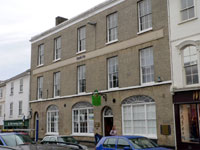
Spink and Carss Bank
|
|
blank |
The largest bank in Bury at the time was Spink and Carss. It was already weakened because its late proprietor John Spink, had died three years earlier in 1794, heavily in debt to the Treasury for taxes he should have collected as Receiver General for the Eastern Division of Suffolk. From 1795 to 1797 Robert Carss had also built fine new premises on the Cornhill at great cost. Just two days after the failure of Grigby and Cork, on March 15th 1797, Spink and Carss failed. Robert Carss was Spink's son in law, and had been taken into partnership by John Spink.
|
|
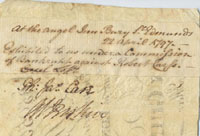
Evidence in Bankruptcy
|
|
blank |
Several of Spink and Carss banknotes from 1795 survive because they were never cashed. As with the failure of any of these banks, it was not just the shareholders who lost money. Anyone who had accepted their notes, instead of gold or silver coins, was left holding worthless paper following a crash. These became evidence in the subsequent hearing for bankruptcy. Two such notes are held by the Moyse's Hall Museum. The Trustees in Bankruptcy have added the following note to the reverse of these notes, thus: "At the Angel Inn, Bury St Edmunds 22nd April 1797, Exhibited to us under a Commission of Bankruptcy against Robert Carss. (signed) Capel Lofft, Thos Jas Case(?), indecipherable."
Oakes's bank now kept going all the better because it continued to pay out cash on demand, and thus survived its rivals' failures. The bank was even given a new name. It became the Bury and Suffolk Bank, and it was to be the sole significant Bury bank for the next four years. It gave up its relationship with Gurneys and indirectly Barclay's bank, and Oakes now used Ayton Brassey and co as his London banker.
At the same time Oakes's bank became the bankers to the Bury Corporation, taking over a loan of £2,350 made to it by Spink some time before 1778.
Despite the experiences of Spink's bank, being a Receiver of Taxes was still thought worthwhile and James Oakes got his son Orbell appointed to the West Division in this same year. In effect the job was handed on from father to son through the influence of the Duke of Grafton.
The stamp duty levied on every copy of a newspaper sold was raised from two pence to threepence halfpenny. Access to news and comment was looked on as a luxury by the government, and was effectively made too costly for ordinary people to acquire.
Arthur Young wrote that the improvement in Suffolk's roads over the previous 20 years was "almost inconceivable". Many roads had been diverted to run round the great estates, such as Culford and Ickworth. Arthur Young was born in 1741 at his father's London home, but was soon removed to their country seat at Bradfield Combust and was educated at Lavenham. He wrote extensively on agricultural practices and many of his ideas were widely adopted. He got most of his information about wool manufacture from James Oakes in Bury.
He died in 1820.
In June 1797 Arthur Young's 14 year old daughter, his beloved 'Bobbin', died. Young was angry that he had employed five physicians to help her, but none of them had agreed in their diagnosis or treatments. He now believed that "that it cost me £100 to destroy my child, for I do not think that one shilling was bestowed that did not in one way or other do mischief." "Had she been a pauper in a village she would, I verily think, have been alive and hearty."
Despite the passing of the Improvement Act in 1795, the state of the Lark Navigation was still causing concern among the local coal merchants. The Navigation was owned by the Palmer family, and had been allowed to fall into disrepair. Ashley Palmer had died in 1792, leaving his widow Susanna to manage the waterway on her own. By now she was 61 years old. This decay in the river was hindering the deliveries of bulky goods like coal, which could not economically be brought in by road.
|
|
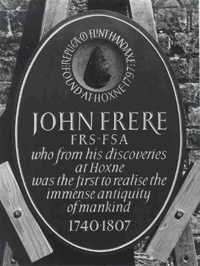
John Frere memorial
|
|
blank |
In 1797, Hoxne near Eye in East Suffolk could have become a site famous for remains of flint tools. On June 22nd, 1797, John Frere wrote a letter to the Secretary of the Society of Antiquaries describing finds of elephant bones, and flint tools. He seems to have seen these as early as 1790, dug out of a claypit by workmen. He wrote:
"They are, I think, evident weapons of war, fabricated and used by a people who had not the use of metals. They lay in great numbers at the depth of about twelve feet, in a stratified soil, which was dug into for the purpose of raising clay for bricks......
In the same stratum are frequently found small fragments of wood, very perfect when first dug up, but which soon decompose on being exposed to the air; and in the stratum of sand (No. 3), were found some extraordinary bones, particularly a jawbone of enormous size, of some unknown animal, with the teeth remaining in it......
The situation in which these weapons were found may tempt us to refer them to a very remote period indeed; even beyond that of the present world; but, whatever our conjectures on that head may be, it will be difficult to account for the stratum in which they lie being covered with another stratum, which, on that supposition, may be conjectured to have been once the bottom, or at least the shore, of the sea. "
Frere's paper was read to the Society of Antiquaries in 1800, but caused little or no, comment at the time. Not until the time of Charles Darwin were people generally able to consider their own origins other than as descendants from Adam and Eve, and it was then that Frere's work was revived. Today, this site is considered so important that it gives its name to the Hoxnian Interglacial period.
Frere himself was born in 1740 at Roydon Hall, near Diss, but lived at Finningham. As a country squire he followed the pursuits of a gentleman of his day, with a particular interest in antiquities. At the time it was generally believed that interpretation of the Bible could show that the world was created on October 23rd, 4004 BC. This idea was put forward by the Archbishop of Armargh, James Ussher (1581-1656), in the 1650's. The calculation was included in the authorised bibles issued after 1701, and accepted as fact. Despite this, Frere believed that his finds were older than this. He understood the importance of stratigraphy, and recognised that these people had relied entirely upon natural resources without the knowledge of metals.
|
|
1798
|
The war with Napoleon was proving very costly and in January 1798 William Pitt finally persuaded Parliament to bring in the first modern Income Tax as a temporary measure to meet the crisis caused by threat of invasion. This had the effect of trebling the tax burden on most taxpayers. Apart from a short period in the early 1800's, income tax has continued ever since.
Arthur Young, was, as usual for him, short of money. Despite his success as a writer, and his post of Secretary to the Board of Agriculture, and his estate at Bradfield Hall, he did not have enough ready money to pay both his creditors and the new tax demand. He estimated his extra taxes at £100, or as was written in those days, 100l.
|
|
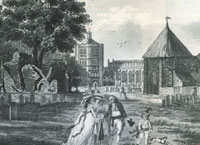
Churchyard comes into public ownership
|
|
blank |
James Oakes recorded that he bought the Churchyard for £330 "with a view to reserving it for the corporation, hoping that they will be in very few years capable of repaying me the purchase money and all expenses". A committee was set up to manage it and seven £50 bonds were issued to pay for it and cover costs. It had been owned by Spink and Carss Bank, as Mr John Spink had bought it, also intending to donate it to the town. He died before he could do this and it passed to the bank, being now sold at auction to raise cash for the liquidation. Spink had wanted to keep the Charnel Chapel as a family mausoleum, and was himself buried there.
It remains Council property today.
Unfortunately for the 4th Earl of Bristol, the Earl bishop, Napoleon now invaded Italy. The French seized Rome, and all the Bishop's valuable collection of artworks fell into French hands. The collection was worth £20,000, and had been intended to be housed in the new house the Bishop was building at Ickworth. The 4th Earl of Bristol was himself imprisoned by the French in Milan for nine months. After his release he continued to travel Italy.
John Orridge was appointed Governor of Moyse's Hall jail with the promise of also being Governor of the New Jail to be built in Sicklesmere Road. He had modern views on prison reform and had a big input onto the new design. He introduced a Treadmill, prisoners could cook their own rations and other new ideas copied later at other prisons. The Tsar of Russia even asked him for advice in 1819.
There had been a Brewery in Westgate Street, Bury St Edmunds, throughout the 18th Century, owned by three generations of the Wright family. In the universal Directory for 1791 Matthias Wright had been described as Assistant Justice. In 1798 Matthias Wright's executors had decided to sell the Westgate Brewery, together with its Malting House in Southgate Street and various Public Houses. Possibly because of the poor economic conditions around the threat of invasion by Napoleon it did not sell, and would stand idle until 1805, when the Buck and Greene partnership would take over, and begin to restart the brewing process.
|
|
1799
|
Having given up the yarn trade four years earlier, in 1799 James Oakes sold his comb shops to John Clark, a brewer, for £900. He had sold his Stowmarket property a year earlier. Most of the other big Bury yarn makers had also given up by now.
In 1792 John Clark had taken over the Capital Brewery in St Andrews Street which was next door neighbour to Oakes's now redundant comb shops. In order to expand his brewery he needed more space, and he probably needed more staff. Either in 1799 or some time in the next two years he would engage Benjamin Greene from Bedford as an assistant brewer on a three year contract. Greene would go on to found the firm which eventually became Greene King, but this seems to be the only tenuous link that the firm of Greene King can have with 1799.
Non Conformity was now well established in the villages as well as the town. In August 1799 the newly built Meeting House at Tan Office Green at Chevington was set aside for worship. Chevington became the local centre for Independency serving the villages of Chedburgh, Rede, Hargrave, Ousden, Lidgate, and even Wickhambrook. This chapel became leased to Primitive Methodists in 1844.
At this time whole villages were bought and sold between the great local landowners. Wordwell parish had been owned by Lord Bristol of Ickworth, but in 1787 he had told the Marquis Cornwallis that he was willing to let him have it. In 1799 Cornwallis paid the enormous sum of £33,000 to Lord Bristol to acquire Wordwell. To raise some of the money he sold off the remainder of Little Saxham to Robert Rushbrooke for £6,664, and in 1800 he finalised the sale of Whepstead Hall and manor to Sir Thomas Hammond of Plumpton Hall in Whepstead. Whepstead had cost him £12,000 in May, 1795, and when he bought it he had thought it was worth about the same as Wordwell.
|
|
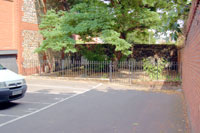 Baptist cemetery today
Baptist cemetery today
|
|
1800
|
The Baptist Church was established by 12 people in Bury in 1800, but at the time the congregation would have called the building the Ebenezer Chapel. It was located on Lower Baxter Street and Looms Lane. Membership grew to 49 over the first 23 years of the church’s existence under the leadership of four successive pastors. This chapel was enlarged in 1828, and it would be used until 1834, when a new church was built in Garland Street.
Part of the cemetery attached to the original Baptist church of 1800 can still be seen in the Lower Baxter Street public Carpark.
By 1800 the yarn industry of Suffolk, including Bury St Edmunds, had dwindled to almost nothing. Norwich, however, would still be a sizeable textile town until the mid nineteenth century. It relied upon cheaper yarn now brought in from Ireland.
Brandon developed a unique industry to supply the demand for flints to use in the flintlock muskets needed for the Napoleonic wars. This revived the flint industry which had last flourished at Weeting in the stone age.
|
|
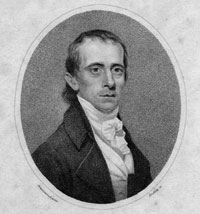
Robert Bloomfield
|
|
blank |
The poem "The Farmer's Boy" was published in London, written by Robert Bloomfield, who was now a very poor cobbler working in that city, although born at Honington in Suffolk. A second edition followed very rapidly, published simultaneously in London, Bury and Norwich. The poem was written in 1798, but Robert could not get a publisher. His brother George, living in Bury, finally managed to show it to Mr Capel Lofft, a Whig barrister and magistrate who lived at Troston Hall, three miles from Honington. It was Capel Lofft who got the poem published, and introduced Bloomfield's work into society. He was largely responsible for enlisting the support of Captain Bunbury at Livermere Hall, the Duke of Grafton at Euston, Dr Drake of Hadleigh, the Earl of Buchan, the Duke of York and even the Prince of Wales, all of whom were to admire and promote Bloomfield's work. By 1803, 30,000 copies had been sold. Bloomfield became rich on the proceeds, but over the years his various relatives were to relieve him of most of it.
The poem itself describes in idyllic terms, the life of Giles, a farm boy at Euston on the Duke of Grafton's Estate.
"Where noble Grafton spreads his vast domains
Round Euston's watered vale and sloping plains,
Where woods and groves in solemn grandeur rise,
Where the Kite, brooding, unmolested flies;
The woodcock and the painted pheasant race,
And skulking foxes, destined for the chase....
"
|
|
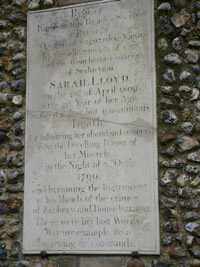
Sarah Lloyd's Gravestone
|
|
blank |
There is a well known gravestone in Bury churchyard for the servant girl, Sarah Lloyd, hanged in 1800 for stealing goods worth £2 from her employer. Sarah Lloyd, aged 22, was arrested in October, 1799, and charged with arson, burglary and attempted murder. She was a live-in servant of Mrs Sara Syer of Benton Street, Hadleigh, and had fallen in with one Joseph Clark, assumed to have been her lover. On the night of 3rd October she is said to have let Clark into the house, and this led to theft, and to a fire in the stairwell of the house. Mrs Syer was alerted by neighbours and escaped the fire.
At the Assizes, held in Bury St Edmunds in March, 1800, Sarah Lloyd was found innocent of burglary, but guilty of larceny, to the value of 40 shillings. The charges of arson and attempted murder were apparently dropped. Clark was found to have no case to answer, and was set free, but Sarah Lloyd was sentenced to death. Years later, in 1835, Clark is said to have made a deathbed confession at Hadleigh, where he led a married life until his demise, aged 65.
Capel Lofft, a barrister and magistrate of Troston Hall, led the appeal against this harsh sentence. A petition was prepared, and sent to the Home Secretary, the Duke of Portland. Lofft suggested that Sarah LLoyd was only 19, not 22, and that there were extenuating circumstances in her favour. Even the Duke of Grafton signed the appeal for mercy, but all to no avail. On April 23rd, as the tumbril was taking her to execution at Tayfen Meadows, Capel Lofft climbed aboard and harangued the crowd for 15 minutes. He also criticised the Duke of Portland, for denying clemency. As a result, this great radical philanthropist was struck off the roll of magistrates. Sarah Lloyd was the last person to be executed at Thingoe Hill. After 1805, executions would be carried out at the new gaol in Sicklesmere Road.
|
|
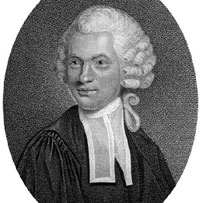
Capel Lofft (1751-1824)
|
|
blank |
Capel Lofft lived at Troston Hall and was also the owner of Stanton Manor, which he inherited from his uncle, Edward Capell. He had been a reformer in the 1770s, but by the 1790s he espoused many more radical causes. These included universal male suffrage and the abolition of the death penalty. He had been an opponent of the War which resulted in American independence, and was an admirer of Napoleon Bonaparte. His views, and his fiery manner of expressing them, may well have hardened the judiciary against his appeals on behalf of Sarah Lloyd.
Ousden Hall and manor had been owned by the Moseley family since 1567. In 1800 the estate was sold to John Smith of Staffordshire. He would sell it again in 1804.
By 1800, not only had the local wool trade collapsed, but the great linen production around Diss, which had reached its height in 1750, had collapsed since that peak time. Diss farmers had replaced flax production by more cereals. Like Bury St Edmunds, Diss had its Corn Hill, where cereals had been traded from open market stalls, just like any other market produce. However, corn trades involved values far in excess of the normal market stall produce, and gradually, over the coming decades, there would be a movement towards the building of indoor Corn Markets or Exchanges.
|
|
1801
|
The Irish Act of Union led to rule from London.
In 1801 Bury was the second town in the county of Suffolk, having a population of 7,655, according to the census. However, some have said that this census figure was probably some five percent underestimated. Bury was run by a closed corporation of 37 members who returned two MP's to Parliament. It was the venue for the county assizes and quarter sessions, as well as petty sessions and other Borough courts, such as the Coroner's court and the court of pie powder, which enforced market bye laws. There were various industries supplying local needs, but the big earners were brewing and malting. The great fortunes made in the last century from yarn making were still mostly intact, although the yarn industry itself was over. It was a prosperous and well situated town, widely known for its social life. Every October, the Bury Fair was nationally known for its social entertainments.
Land enclosure had again been going strong since 1770. Locally there was an enclosure act for Pakenham passed in 1797, while the act for Honington was passed in 1799. These acts established commissioners who had to allot the so-called waste ground and commons among the local landowners, the church, and if applicable, the poor. Carrying out this process could take a year or two before the consequences were felt by local people. In 1801 the enclosure of the green at Honington led Nathaniel Bloomfield to write his poem "The Elegy on the Enclosure of Honington Green". He echoed the feelings of the poor when he wrote that:
"In all seasons the green we loved the most, because on the green we were free".
His brother Robert Bloomfield wrote "The Farmers Boy".
Meanwhile, a joint enclosure act for Risby and Fornham All Saints was passing through its Parliamentary process in 1801.
In 1801 Arthur Young of Bradfield Hall was still finding himself under great financial pressure. He neglected his estate to work for the Board of Agriculture as its Secretary. He would rise at 4 am and walk in up to his neck in the garden pond. Then he would work on his reports, or, if away from home, he would be undertaking yet more of his investigations into agricultural practices for the Board. Despite all this he believed that there were moves to remove both the President of the Board and himself, on the pretext that nothing was being achieved. Since the death of his daughter he had spent more and more of his time reading religious books, and considering the state of his soul.
In June 1801, Young noted that the Duke of Grafton, Lord Euston,
"is going on a tour of Suffolk, ordering returns to be made of all carts, waggons, horses, mills and ovens; a step preparatory in the expectation of an invasion. But it is in everyone's mouth that with such a price of corn half the country would join the enemy. I must freely confess I dread the result."
Young was angry that nothing was being done to help the poor. His own solution was to give them extra land so that they could feed themselves more effectively. He was sorry
"to see poor rates at their present enormous height and the poor in misery...when they could have land, and live in ease, while rates could be only 3d or 4d in the pound."
As a member of the Suffolk Corps of Yeomanry, despite his advancing age, Young now went along with a proposal to fine members five shillings if they were absent from any of the meetings on the first Friday of every month. Young knew that his work took him away so often that he was usually absent, but felt that he could not resign while the current state of crisis prevailed in the land.
|
|
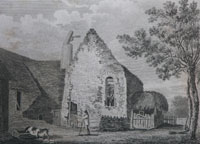
St Botolphs Chapel
|
|
blank |
In about 1801 St Botolph's Chapel, by this time in the yard of the White Hart public house, was still standing. The White Hart was in Southgate Street, and is a guest house in 2005. In his History of Bury St Edmunds published in 1804, page 221, Edmund Gillingwater recorded that "this building was standing about three years since, but is now (1804) wholly taken down and demolished".
Messrs Crowe Sparrow and Browne, who owned the Braintree Bank bought Spink and Carss old banking house on the Cornhill, and opened up a new bank in Bury.
In 1801 the Presbyterian Minister, Nathaniel Phillips, persuaded some of his congregation to embrace the rationalist doctrines of Unitarianism. Many of his flock then left to join the Congregational Church, but today we still know the building in Churchgate Street, Bury, as the Unitarian Meeting House.
On the Horringer Road, at the top of the long haul out of Bury, the West Mill burned down. Wind mills that grind flour produce a fine dust which is extremely combustible, and explosions and fires were a constant worry. The mill was rebuilt a year later, and continued to operate until 1918.
|
|
1802
|
In November 1802 the poor state of the Lark Navigation, combined with a drought, left the coal yards of Bury St Edmunds empty. There was not enough water to float the barges. Susanna Cullum, the proprietor of the river, was perhaps too old to carry out the necessary improvements.
Lark navigation records tell us that in 1802, goods were being landed from the river at the villages of Icklingham, Lackford, Flempton, and Chimney Mills, as well as at the Fornham Wharf. Coal was not delivered to most villages as it was too expensive. Coal was landed at Icklingham, probably for the mill, but other villages had turves delivered instead. Nowadays we would call these peat blocks, as peat was a cheaper fuel than coal.
Sir Charles Davers who had held one of Bury's two parliamentary seats since 1774 stood down with no heir to follow him. James Oakes, who by now was over 60, immediately decided to offer his services as political agent to the Earl of Bristol. He held the same office already for the Duke of Grafton. For the next 25 years the FitzRoys and the Herveys shared the two seats whatever the state of politics in the country as a whole.
Bury corporation had banned the practice of bull baiting and in 1802 supported a bill to outlaw it nationally.
In 1802, Benjamin Greene joined the Congregationalist Chapel in Whiting Street. He paid a subscription to reserve a pew for himself and family, and this is the first written evidence of the would-be brewer's presence in Bury.
Encouraged by the success of his poem, "The Farmer's Boy", published in 1800, and supported by people like Capel Lofft, and the Duke of Grafton, Robert Bloomfield published his second major work, called "Rural Tales, Ballads and Songs" in 1802.
In 1802, those refugees from the French Revolution, the Canonesses of St Augustine, voted to leave Hengrave Hall and return to Bruges.
|
|
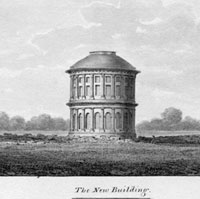 Ickworth Rotunda by 1818
Ickworth Rotunda by 1818
|
|
1803
|
Frederick, 4th Earl of Bristol and Bishop of Derry, sometimes called the Earl Bishop, died suddenly in Italy. He was still on the road, travelling extensively, looking for art to replace his collection, confiscated by Napoleon in Rome in 1798. He had been a keen international collector of art and had begun to build the great Rotunda at Ickworth in 1795 to house his art collection. His death brought work to a halt, and by 1818 very little more had been done, as shown here.
His wife had called the project a stupendous monument to folly, and the Earl did not see the building start or end. He left the country before building began, vowing never to return until Ickworth was completed and furnished with his new collection. Arthur Young recorded that "My Lord left the whole, as if by design, a burthen to his son and successor, with whom he had been on the worst of terms, and from whom he gave away, by will, the very furniture of the old habitable house at Ickworth." Young thought that it still needed another £40,000 spending on it to complete, and that it would still not be habitable.
It is hardly surprising in these circumstances that the Earl Bishop's son did not get round to completing the work until 1829.
|
|
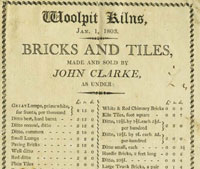
Price list for Woolpit bricks
|
|
blank |
The brick kilns at Woolpit had been producing bricks in a great variety of shapes and sizes for many years. This price list, dated 1803,shows the many types of bricks and tiles made by John Clarke at the Woolpit Kilns. Their speciality was white bricks, which were very popular in the 19th century, and many buildings in Bury survive with frontages built with these expensive bricks. Often a cheaper redbrick was used to construct the less conspicuous rear and party walls of houses. Woolpit has records of brick making in the village dating back to 1574, and by the 18th century brick making was an important part of the village economy. Brick making would continue in Woolpit until just before the second world war. Attempts to restart the industry after the war failed in 1946, when the claypits became flooded after workmen dug into an underground spring.
The New Assembly Rooms in Bury were improved by way of a subscription fund raised by the banker James Oakes. Twelve men contributed £500 each, and a five man committee was appointed. A separate committee ran the Billiard Room. The building was then re-named The New Subscription Rooms. Some 150 people became subscribers to use it. It would not become called the Athenaeum until after 1854.
Oakes recorded that it opened in 1803, in time for the Bury Fair in October.
War with France led Lord Euston to recommend to Sir Charles Davers that "in case of invasion all horses and draft cattle that cannot be driven out of reach of the enemy should be shot; and that all the axle trees or wheels of all carriages likely to fall into the enemy's hands be broken."
|
|
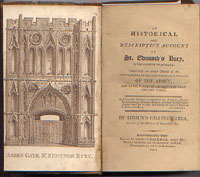 Gillingwater's History
Gillingwater's History
|
|
1804
|
Edmund Gillingwater produced his guide book to the town entitled "History of St Edmund's Bury". Gillingwater had previously written the History of Lowestoft, his best known work, in 1795. This present book was printed by and for J Rackham's of Angel Hill. It was described as An Historical and Descriptive Account of St Edmund's Bury, in the County of Suffolk. The book is full of historical incidents, facts and figures, and has the feel of a compilation of sections, covering many disconnected periods. It includes a list of plants growing wild about the town and its surrounds. The book opens with a long discussion of whether Bury ever was the Villa Faustini, and appears to conclude that in the view of most authorities, it was not. However, this idea was still very much alive, a hundred years later when Villa Faustini featured in the 1904 pageant. On a more modern note, he says that the Assembly Rooms were nearly finished in 1804. Improvements were carried out from 1803 to 1805.
In his book he wrote that "The whole of the Angel-hill appears to have been raised and levelled by filling up the ditch near the Abbey-gate, where the ground was so low, that people ascended the houses on the opposite side, by several steps. The ground near the gate is now much raised, it is said three feet. The ditch was open at the beginning of the last century."
He commented upon the "several good dwelling-houses" built into the abbey ruins of the West Front. But he was also sorry to observe that a part of the west front, was used for "a common stable, and an odious receptacle for dung." This refers to Samson's Tower, which was used for stabling by the Six Bells inn on Chequer Square.
Most of the shops in the Cook Row, (Abbeygate Street), were now "elegantly sashed", compared to 1750, when the vast majority were "open to all the inclemencies of the weather."
The River Lark is referred to by that name, with the comment, "the Lark, (whose divided waters are, with others, collected within the abbey grounds into one stream,)..."
Edmund Gillingwater was a barber's apprentice in Lowestoft when he was taken in hand by a local rector, and given tuition. As he had no means to pursue a scholastic career he became a bookseller in Harleston, just inside Norfolk. He became well known for his learning and his antiquarian interests throughout the two counties, as well as for his devotion to the church. He, in turn, took classes for young men in Harleston. His brother remained in Lowestoft and provided Edmund with much of the material for his book on Lowestoft. It is likely that the Bury bookseller, J Rackham, knew of Gillingwater's book on that town, and commissioned him to write this History of St Edmundsbury.
|
|
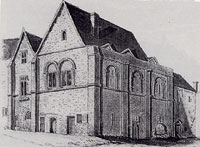
Moyse's Hall with original east wall
|
|
blank |
In 1804 the east wall of Moyse's Hall collapsed. It was subsequently rebuilt on a much plainer style, apparently with the loss of some Norman window frames and features. There is one known print of the building before the collapse. It illustrates one of our difficulties in relying on old pictures for accuracy. If the artist felt like leaving out some feature because it was, perhaps, not picturesque in his view, then he would do so. This view omits the cupola on the building. Although there has been more than one of these additions over the years, there was certainly thought to be a cupola in place at this time.
The Congregational Church in Whiting Street was re-built in 1804, although the congregation could be dated back to the 17th century.
The smallpox vaccine of Dr Jenner was now so highly regarded that Robert Bloomfield even published a poem in its honour, "Good Tidings, or News from the Farm." This reference was due to the fact that Jenner had developed his vaccine from the cowpox. Cowpox vaccine was much safer and less painful than the previous use of smallpox inoculation. Jenner had developed the new process in and after 1796.
Arthur Young of Bradfield Hall was staying at Woburn in June, as he often did. He commented in his journal that the Duke of Bedford had commissioned Cartwright to build him a steam threshing and grinding machine at a cost of £700. Young noted that a one-horse mill could be bought for £50 "and would thresh all the corn that will ever be brought to his yard." Young was always a great innovator, but in the case of steam power he believed that it could never become cost justified on the farm.
At Culford, the Marquis of Cornwallis obtained parliamentary approval to divert the highway around his estate to its present location. However, he only wanted to remove the through traffic, and had no intention to close the old road, or to demolish existing village dwellings. This would not take place until 1825, under the new owner, Richard Benyon de Beauvoir, who would buy the estate in 1824.
|
|
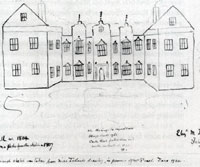
Ousden hall c1804
|
|
blank |
Ousden Hall and manor had been owned by the Moseley family since 1567. In 1800 the estate was sold to John Smith of Staffordshire, who only held it for four years. In 1804 Ousden hall was bought by the Reverend James Thomas Hand. Hand would die in 1835, and the estate would pass to his nephew, Thomas James Ireland. The sketch shown here is dated 1924, but claims to be a copy of a drawing made in 1853, but taken from originals dated 1804 and 1807. It shows the Elizabethan front, with two added wings from the Georgian period, which the sketch claims to date to 1760. The building would be substantially remodelled in about 1820.
The feud between the Oakes family and John Benjafield extended into all areas of life, not just politics. They even had rival corps of volunteers, one officered by Orbell Oakes, and one by John Benjafield. One task the volunteers undertook was to guard the Bury Ordnance Depot on the old Chevington Road, now called Hospital Road. Benjafields's corps had secured this duty, which enjoyed the benefit of a payment for every man on duty. During 1804 the Oakes's managed to oust Benjafield from this duty, replacing his men by Oakes's men.
|
|
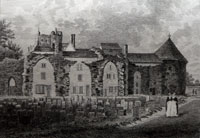
West Front
|
|
1805
|
The ruins of the old West Front of the Abbey at Bury St Edmunds had probably first had houses built into them in the 17th century. They were renovated in the 18th century and had suffered a variety of uses as well as housing. The west front, with its inbuilt dwellings is shown here in this illustration taken from Yates's Antiquities of 1805.
|
|
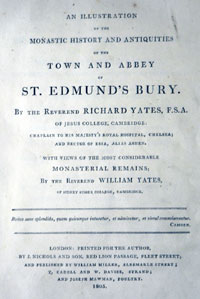
Yates' Antiquities
|
|
blank |
In 1805 Yates's history of the Abbey at Bury was published and it aroused a great interest in Bury's monastic ruins and remains all over the country. Commonly referred to by local historians as "Yates's Antiquities", the full title of Richard Yates' book was "An Illustration of the Monastic History and Antiquities of the Town and Abbey of St Edmund's Bury". The Reverend Richard Yates was provided with the illustrations for his book by his brother, the Reverend William Yates, of Jesus College, Cambridge. There were 15 illustrations of monastic remains of Bury St Edmunds as they existed at the time. Much interesting material was published about the abbey.
|
|
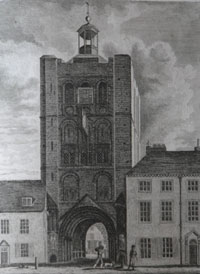
Norman Tower in Yates
|
|
blank |
The Norman Tower was shown with a cupola on the top, a public clock on its face, and houses built on both sides of it. Access to the West Front homes was therefore through its arch at present day street level. Much of the arch was by now below ground level. This book was re-published in 1843, with some additional plates. One new illustration is of the coat of arms of the Abbey, basically three crowns, which was said to have been displayed over the South Gate. The three crowns were incorporated into the arms of the Borough of Bury St Edmunds and later St Edmundsbury Borough Council.
According to a postscript in the book, Yates intended to publish further extensive work on the abbey's history, but this did not happen. The 1843 posthumous edition contained only a fraction of what he had hoped to produce. Yates was an educated man from a well to do family. Yates recorded that his father had lived for 37 years within the abbey precincts, and had fostered his own antiquarian interests. His book was a scholarly work, quoting extensively from medieval documents, with latin extracts. It was large and lavishly produced. In the fashion of the time you could order your own custom binding depending upon your purse. It recorded no history of Bury other than that relating directly to the Abbey. It had a large number of wealthy local gentry on its subscription list, and was aimed at a completely different market than the small popular town history produced earlier by Edmund Gillingwater.
In 1805 we can trace the real beginnings of the brewers Greene, King and Company, when Benjamin Greene set up a partnership with William Buck to brew and sell beer. Greene had been apprenticed to Whitbread's Brewery in London, in the 1790's and apparently when this was over, he moved to Bury somewhere between 1799 and 1802. He seems to have entered into a 3 year contract as Assistant Brewer at the Capital Brewery of John Clark in St Andrews Street. After this he decided to set up on his own account.
William Buck had been a yarn manufacturer in Bury, like James Oakes, and this business was now moribund. Buck lived in Westgate street opposite to Guildhall Street at number 24, and his yarn works had been nearby. His combing shop and warehouse was turned into a tenement of six houses in 1803 and 1804. Whereas Oakes turned to banking, Buck now turned to brewing. Buck provided capital, business knowledge and a strong local reputation, while Greene provided the brewing know how. Both men were non-conformists, attending the Independent Chapel in Whiting Street. Buck was 60 at the time and it seems that managing the brewery fell mostly to Greene.
There had been a Brewery in Westgate Street, Bury St Edmunds, throughout the 18th Century, owned by three generations of the Wright family. In 1798 Matthias Wright had decided to sell the Westgate Brewery, together with its Malting House and Public Houses. It did not sell, and for several years had stood empty. Finally in the Winter of 1805, The Buck and Greene partnership took it over, and began slowly to restart the brewing process.
William Buck's daughter Catherine had married Thomas Clarkson in 1795. At first they farmed in the Lake District, becoming friends with the Wordsworths and Samuel Taylor Coleridge. In 1805 they returned to Bury to live in St Mary's Square. Clarkson was to become a major advocate for the Anti-Slavery movement. This injected a reformist zeal into Bury Society, as well as a poetical one. This was reported in the Diary and Reminiscences of Henry Crabb Robinson of Linnet House in Southgate Street.
James Oakes presented the corporation with a Mayor's robe and chain. The chain incorporated a gold medallion chased with a profile of King James I, and the arms of the town. The gold chain, made of horse-bit links and chased rosettes, cost Oakes £140. In 1805 the County Gaol was completed by designer George Byfield in Sicklesmere Road. The new gaol had many innovations, such as water closets, bathrooms in the infirmaries, and adequate washing facilities. In design it was built around an octagonal central building, the home of the Governor and Chapel. The Governor could oversee the whole prison from his house. A Treadmill was incorporated to provide occupation for prisoners who could earn wages to buy clothing and extras. Provision was made also for a place of public execution above the gate in the main street facade. The County no longer needed to keep prisoners in the old gaol on the Cornhill, at the bottom of Woolhall Street. The first Gaol Keeper was John Orridge who would later influence prison design both within the kingdom and abroad.
At the College Street workhouse in Bury, conditions were not much better than in the town's gaol. In 1805
the philanthropist and prison reformer James Neild visited Bury's workhouse. He found that the building was dirty and badly ventilated. There was no daily table of diet prescribed for the inmates. He also discovered that the twenty-eight children in the workhouse were in a state of nearly total ignorance, although several of them had spent fourteen years of their lives there.
|
|
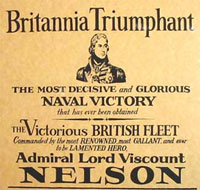
Battle of Trafalgar
|
|
blank |
Nelson was victorious at the Battle of Trafalgar on 21st October, 1805. This was a sea battle fought between the Royal Navy and the combined fleets of the French Navy and Spanish Navy during the Napoleonic Wars, which lasted on and off from 1793 until 1815.
The battle was the most decisive British naval victory of the war. Twenty-seven British ships of the line led by Admiral Lord Nelson aboard HMS Victory defeated thirty-three French and Spanish ships of the line under French Admiral Pierre-Charles Villeneuve off the south-west coast of Spain, just west of Cape Trafalgar. The Franco-Spanish fleet lost twenty-two ships, without a single British vessel being lost.
Nelson had invented the new tactic of dividing his smaller force into two columns directed perpendicularly against the larger enemy fleet, with decisive results.
Nelson was mortally wounded during the battle, becoming one of Britain's greatest war heroes.
|
|
1806
|
By April 1806 Messrs Buck and Greene began advertising that they would be ready by the first week in June, to execute any order thay may be favoured with for table beer. They also announced that as soon as possible, the would supply such Ale, Porter and Old Beer, as will give complete satisfaction to their friends. Thus did the name of Greene become associated with the Westgate Brewery in Bury St Edmunds.
Early in 1806 Benjamin Greene and his wife moved into the brewery house which he had acquired as part of the Westgate Brewery of Mathias Wright. This house was the one to which the last abbot of St Edmunds Abbey, John Reeve had been retired in 1539. It was old and had been let for some time. The Greenes would live here until 1819. Nearly next door in Crown Street lived Sir Patrick Blake, baronet, and Lady Blake, with whom the Greenes would become very close. The Blakes owned estates in the West Indies, and Langham Hall in Suffolk, but because of large family debts and a generous lifestyle, they had to let Langham Hall and moved to Bury in 1805.
The wool trade being moribund in Bury, Mathew's Wool Hall was leased to an earthenware man.
Sir Charles Davers died in 1806 "when the scite of the Abbey and the Stewardship of the franchise, descended to the second sister's second son, Frederick, now Marquis of Bristol." Sir Charles left eight illegitimate children by Frances Treice. His heir at law was Frederick William, the 5th Earl of Bristol, later to become the first Marquess of Bristol. The estate at Rushbrook also passed to Frederick. However, in 1808 he would exchange Rushbrook for the estate of Little Saxham.
A new name featured in the list of Bury MP's when in December the Right Honourable John Upton, Viscount Templetown, was elected. He was the brother in law of the Fifth Earl of Bristol, so the job was still firmly in the same local hands.
Bury's Assembly Rooms were formally conveyed into the ownership of its Subscribers.
The two subscription libraries in town were amalgamated in 1806 and survived until 1829.
Oakes opened a branch of his Bury and Suffolk Bank in Stowmarket to compete with Crowe, Sparrowe and Browne who had recently done the same. Stowmarket was enjoying rising prosperity at this time. Farmers were doing well in the war, and the Gipping Navigation had opened in 1793.
In 1806 the Norfolk and Suffolk General Bank of Thetford opened a branch in Bury. This bank was owned by Willett and Sons.
|
|
1807
|
On 28th January London became the first city in the world to be lit by gas light.
James Oakes had estimated that in 1807 the population of Bury was 7,500, but he thought that about 4,500 were paupers. If correct, this put 60% in poverty.
The Guild Hall was refronted and repaired during 1806 and 1807 at a cost of £1,400. It assumed broadly the appearance that it has today.
Mrs Susanna Palmer, proprietor of the Lark Navigation, was 70 years old in 1806. By 1807 it seems that her nephew, Sir Thomas Gery Cullum of Hardwick House, was managing her affairs on her behalf. These included the River Lark, and part of the Great Ouse, and he was to become an enthusiastic improver of the Navigation. Provisions of the 1795 Act included a number for improving the River Lark, and Cullum seems to have felt that it was now up to him to carry them out.
|
|
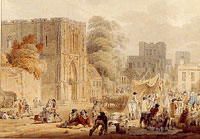
Bury Fair in 1808
|
|
1808
|
This picture of Bury Fair was signed by Joseph Clarendon Smith, and dated 1808. Not all of the prints and pictures of early Bury St Edmunds are topographically entirely accurate. The artist would sometimes "improve" the scene by omitting unwanted detail. In this picture the cupola on top of the Norman Tower has been omitted, but it was still in place until 1854. Bury Fair would be abolished in 1871.
A system of shutter telegraphs was set up to send messages from the admiralty in London to naval ships in port at Yarmouth. A chain of 18 stations were set up on hills in line of sight which operated 12 shutters abut 3 feet square. A message could be sent to Yarmouth in about 17 minutes by this system. The chain had a station at King's Chair at Newmarket followed by one at Telegraph Road, Icklingham about 10 miles away. The next station was on the Thetford Road at Barnham, about 5½ miles distant. The system only lasted until the Napoleonic Wars ended in 1814.
John Benjafield was narrowly elected on to the Bury St Edmunds Corporation. He was by now a JP and a Captain in the Militia, but he never got on with James Oakes, who opposed his attempt to become Alderman.
The non conformist British and Foreign school society was set up to provide schools for poor children. Joseph Lancaster, a Quaker, had published an account of his educational work in 1803 called "Improvements in education as it respects the industrial classes of the community".
Joseph Lancaster had found that at his 'Lancasterian School' in Southwark one 'teacher' could teach say five boys one item of knowledge in reading, writing or arithmetic. These five boys would teach another five. These would teach five more. In this way education could be provided very economically, and each boy paid just one penny per week. The use of the slate and a slate pencil was a feature of his method, being vastly cheaper than paper, pen and ink. At this time quill pens were still in use, which needed sharpening, and the use of slate was easier for children, and also quicker.
Financial difficulties led in 1808 to Lancaster's schools being taken over by a group who formed the Society for Promoting the Royal British or Lancasterian System for the Education of the Poor. This society would be renamed in 1814 as the British and Foreign School Society or BFSS.
It is not clear when the first Lancasterian schools reached Bury St Edmunds, but there were certainly schools using slate and slate pencils at this time. This is reflected in the comment made by Mr. Thomas Warren in 1809 when introducing his newly engraved slates to the Society for the Encouragement of Arts, Manufactures, and Commerce who awarded him a gold medal for his invention:
"The great utility of this article (slates) in instructing the children of the poor, particularly in the art of handwriting, has recently been amply proved in several respectable charity-schools at Bury St. Edmunds, also in many private families". (SEAMC, 1809, vol. 27)
The Earl of Bristol had inherited the estate of Rushbrook in 1806, but in 1808 he he exchanged it for the estate of Little Saxham, with Colonel Robert Rushbrook. Colonel Rushbrook had married Frances Davers, the daughter of the last Davers baronet of Rushbrook Hall. Rushbrook now became the seat of the Rushbrook family, and would remain so until 1919.
The great estate of Ickworth now included Little Saxham, and the site of the long demolished Little Saxham Hall stood within Ickworth Park until about 1930 when the Bristol Estate sold off "the Saxham end" into private hands.
|
|
1809
|
Many cities and towns had felt the need to improve the surface of their streets, which could become muddy and dangerous in wet weather. However, the existing corporations did not have the legal powers to carry this out, or to raise money for the purpose. This required an Act of Parliament, and, in the absence of any general powers, each town had to ask Parliament to make a local Act which applied just to their own area. The town also had to pay for the costs of making the Act. These Acts did not give the new powers to the existing town corporations, but created new local bodies of Improvement Commissioners or Paving Commissioners.
In 1809 the Alderman of the Corporation in Bury St. Edmunds called a public meeting to discuss the need for a Paving Act. There was general agreement that an Act would be of benefit to the town, and accordingly, a petition was presented to Parliament. The Act would eventually come into operation on 4th April, 1811.
Despite the recent difficulties in the yarn trade, when Simon Cumberland died, he left the enormous sum of £200,000. He had been in partnership with his brother in Bury and Woodbridge.
The second decade of the 19th century would turn out to be the coldest decade in Britain since the 1690s. In his book on the History of Hawstead, written in 1784, Sir John Cullum described two types of tremendous plane trees that grew at Hawstead Place. By the time that his book was re-issued in 1813, many of these trees were dead. The occidental planes were all killed in the Autumn of 1809, or in the following Spring, while the oriental planes survived. This seems to have been the case in many parts of England.
|
|
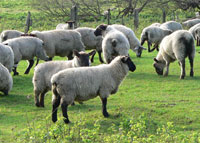 Suffolk Sheep
Suffolk Sheep
|
|
1810
|
The Suffolk Black Faced Sheep was developed by crossing a variety of horned sheep, the Norfolk Horn, with Southdown sheep. The Southdown gave the breed its shape and build and its quiet temperament, while the Norfolk Horn gave taste and quality to the meat. The Suffolk Sheep is easily recognisable with its clean black face and black boots.
Although it is said that the Suffolk sheep breed dates back hundreds of years, the first definite mention of the breed is from an agricultural writer in 1774. By 1810 the breed was accepted as pure and was recognised for its ease of lambing, adaptability and meat production, and it is usually dated to this time. In 1888 G.B. Streeter from New York brought with him from England a prizewinning, young pair, and today the Suffolk sheep is reared all over the world.
|
|
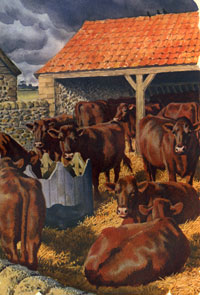
Redpoll bullocks
|
|
blank |
The Red Poll cow is also native to Suffolk. The breed was evolved from a cross between a Norfolk and a Suffolk in the early 1800s. Polled means no horns and Originally the Red Poll was considered a dual purpose breed, good for both milk and beef.
Meanwhile the Suffolk Punch heavy draught horse was being quietly developed in Suffolk and Norfolk. The breed was already old by 1810, and although modern Suffolk Punches are all said to be descended from a stallion called Crisp's horse of Ufford, bred in 1768, the line was probably much older than this. Ufford is just north of Woodbridge.
John Webb's poem, "Haverhill", was published. He later became famous as the 'Haverhill poet'. He wrote that he realised 100 guineas from its publication. William Wordsworth was said to have admired this poem and commented that he had never made so much money from his work. John Webb's patron was the Reverend Marryweather, who procured a number of "respectable subscribers" to finance publication of the poem. Webb recorded in his diary that shortly after its publication, "Sir George Beaumont called upon me and told me it did me credit and that Wordsworth, the poet, read "Haverhill" through at his house and approved of it".
In 1810, James Oakes was elected Alderman for the town of Bury. At this time it was the practice for each of the Capital Burgesses to be elected Alderman in turn. The events of 1810 were the subject of comments in the Report of the Commission on Municipal Corporations in England and Wales, which examined the state of Bury Corporation in 1833. The Commissioners wrote in their report on Bury, as follows:
"the only departures from this practice have originated in party feuds, not occasioned by any difference of political opinion or public principle, but by an attempt on the part of two influential members and their respective friends, to gain an ascendancy in the corporation. Each party strove, by excluding from office the friends of the other, to secure to itself the advantages accrueing from those public privileges......
In 1810, while this struggle was going on, the capital burgesses absented themselves from the elective assembly, and the election of an Alderman did not take place till a manadamus issued from the Court of King's Bench."
This battle was between the friends of James Oakes, and the followers of John Benjafield, Reuben Sturgeon and Charles Peck. On August 23rd, the Thursday before the Feast of St Bartholomew, the corporation met as usual to elect the Alderman for the coming year. Of the 37 members of the Corporation, 18 were absent, thus preventing the meeting having a quorum, so that no vote could take place. The same thing happened next day, when they tried to carry on. Clearly this was a ploy. The members who turned up to vote took dinner in the Angel on both days, while those who absented themselves dined just as richly at the Six Bells on Chequers Square, an easy stone's throw away.
In October the corporation tried to have Benjafield and Company excluded from office, but came to no conclusion. Following the writ of mandamus, most of the missing members turned up, so that on November 22nd, with only 2 members absent, Oakes was finally elected.
Plans to move the Bury Assizes to Ipswich and an attempt by county magistrates to extend their jurisdiction into the Borough were both defeated by James Oakes and the Bury corporation.
|
|
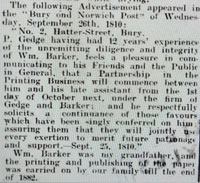
Gedge and Barker partnership
|
|
blank |
Peter Gedge was a printer and the joint founder of the newspaper the "Bury and Norwich Post".
The Bury and Norwich Post was founded on July 10th, 1782, by William Greene and Peter Gedge, with offices in Hatter Street together with the printing works. For its first 3 years of life it was called the Bury Post, and would be published weekly on a Thursday, at a cost of thre'pence.
William Greene died in 1784, and Gedge married Sarah Greene the following year, and also
changed the newspaper's publication day to a Wednesday in 1785 to match Market Day, a better day for sales.
On 1st October, 1810, the firm of Gedge and Barker came into being when Peter Gedge made his printers assistant, William Barker, a partner. William Newney Barker was born in 1779 in East Dereham. He had started as an assistant printer at Gedge's firm in 1789.
The attached letter was written by Horace Ross Barker, and published in the Free Press and Post dated Saturday 16th July 1932. It records the fact that the Barker family were associated with the newspaper from 1789 until 1882. (Copy kindly supplied by a descendent).
Peter Gedge would die in 1818, but be succeeded by his son, Johnson Gedge. The premises at 26 Hatter Street would eventually be taken over by Langhorn Pawsey & Co in 1898.
|
|
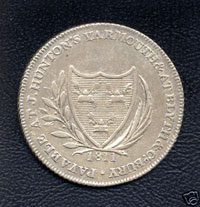
Hunton's Shilling Token 1811
|
|
1811
|
Tokens reappeared in 1811, some silver as well as copper. This one was issued payable at Hunton's in Yarmouth and at Blyth and Co, Bury, and is dated 1811. The reverse includes the legend "Norfolk and Suffolk Token One Shilling". These silver tokens would be suppressed by about 1816 when George III had his last recoinage, or as it was to be called, the "new coinage".
Following a council meeting in 1809, an Act of Parliament had been obtained to establish Paving and Improvement Commissioners for the town of Bury St Edmunds. The new Commissioners came into being on 4th April, 1811. The Act detailed the first 24 Commissioners by name, mostly drawn from the Corporation. The Act enabled the Commissioners to appoint staff, seek loans, and levy and collect rates from the properties in the town.
The Act also contained details of their form of management. The Commissioners were to meet in the Guildhall on the first Monday in each month, and extra meetings could be called as required. Vacancies were to be advertised in June each year, with notices posted on the Church doors, announcements made after Divine Service and notices posted on other doors of important buildings. A public meeting was to be held in the Guildhall on a day specified in the Act, and any vacancies required to restore their total number up to 24 were to be elected by the meeting. Whilst this appeared to be a democratic system, the drawback was that any new Commissioners had to agree to make a loan of £100 to the Commissioners. This requirement ruled out anybody who was not already numbered amongst the 'great and the good' of Bury St Edmunds.
However, their operations were to be limited to the built up area of the town, roughly within the area of the old town gates. They could borrow a limited amount of money and levy a rate to improve the paving, lighting and drainage of the town and provide piped water supplies. They operated alongside the Corporation and would eventually make substantial progress in sewering the town.
A Town Clerk was appointed immediately, followed by a Treasurer, Surveyor and Rate Collector. Rates were to be reviewed each year.
Both James and Orbell Oakes were appointed as Commissioners and James Oakes was made Treasurer. A further Act would be obtained in 1820 to extend their powers. The Commissioners would operate until 1873, when the corporation were given their responsibilities.
One of the first acts of the Paving Commissioners was to let a contract for street lighting. A two year contract for 300 oil lamps for street lighting, together with their upkeep and maintenance, was considered a priority.
It was still the case that when it rained, streams of water ran down the streets, and ditches were necessary to carry this away in an orderly manner. In July, 1811, Bury St Edmunds Improvement Commissioners invited tenders for the provision of of an "under drain" to replace the ditch in Churchgate Street. They also discussed a similar project for Abbeygate Street, but postponed the decision on this street. At some point the Abbeygate street underdrain was approved, probably soon afterwards. It is unclear where these drains discharged their contents, but another drainage ditch seems to have run along the foot of Angel Hill, down Mustow Street and into the river at Eastgate Bridge. As money became available, many of these ditches would be replaced by underdrains.
Along with street improvements, 1811 saw the start of a rapid period of growth in Bury, particularly up to 1821.
The Guildhall Feoffees built the almshouses in Long Row, Southgate Street, in Bury. The builders were W Steggles of Bury and this is one of their earliest buildings but the firm went on to develop or re-develop large areas of the town. The business ran from the site of Model Junction in Whiting Street.
|
|
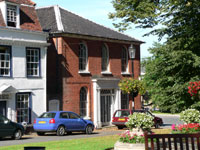
4A St Marys Square |
|
blank |
A Wesleyan Chapel was built in St Mary's Square on a site of a house in which John Wesley had often preached. Between 1755 and 1790, he had preached in St Mary's Square on 17 occasions. The house was the home at the time of the Jervers sisters. In 1780 it had been bought by Richard Cooper, a local Methodist, to safeguard it as a home for the Jervers sisters and as a Methodist Meeting House. By 1811, the Jervis sisters had died, and the house could be demolished to make way for the new chapel. It survived in this use until 1878 when it was sold for use as a house once again. Today it is number 4A, St Mary's Square, a private house.
|
|
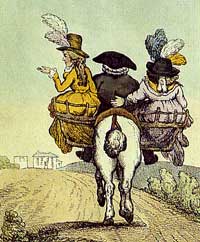
Henry Bunbury 1750-1811
|
|
blank |
Henry Bunbury of the Great Barton estate died in 1811. He had become well known as a satirical caricaturist, and had spent much of his life in London, moving in fashionable and court circles. However, he often returned to Bury, where he was highly popular and equally well known as "a bit of a lad". Joseph Farington described him as "living most of his time a sotting life at Bury in Suffolk." Bunbury had also been a captain of the West Suffolk Militia, and many of his pictures depict militia life, as well as local scenes and local tradespeople.
A scandal broke out in 1811 following a case in the Court of Chancery, brought by Mary Leheup against John Benjafield over his appointment as a trustee of her son's administration in lunacy. Benjafield had made enemies around Bury since his arrival from London in 1795, and Mrs Leheup filed a petition alleging that Benjafield was not a suitable person to be made a Trustee.
The court found that Benjafield had been blackmailing the Prince Regent over his "marriage" to Mrs Fitzherbert. Back in London from 1784 to 1789 Benjafield had owned and run the Morning Post newspaper, and had found out enough about the Fitzherbert matter to embarass the Crown. To keep the affair secret, Benjafield was paid £350 a year. He was also accused of trying to defraud the mentally ill Michael Leheup, of whom he was Trustee.
One of the witnesses against Benjafield was Thomas Clarkson, of Linnet House in Southgate Street, better known later for his work in the abolition of slavery. Peter Gedge's Bury and Norwich Post carried full reports of the Court proceedings. Benjafield tried to brazen it out in Bury, but worse was to come for him in 1812.
The Anglican National Society for Promoting Religious Education was founded on 16th October, 1811, to provide school places for working class Church of England children. The aim of the National Society was to establish a National school in every parish of England and Wales. The schools were usually next to the parish church, and named after it.
The National Society was in strong competition with the existing nonconformist organization set up in 1808 as the Lancasterian System for the Education of the Poor, and renamed the British and Foreign School Society in 1814. Both promoted the monitorial system, whereby a few paid teachers worked with senior students who in turn taught the junior students.
Historically, schools founded by the National Society were called National Schools, as opposed to the non-denominational "British schools" founded by the British and Foreign School Society.
The Prince Regent was installed during the madness of King George III.
|
|
1812
|
In 1812, John Benjafield of Bury St Edmunds continued to try to hush up his role in blackmailing the Prince Regent. He sued the Country and Weekly Advertiser newspaper at the Kings Bench in London. Letters were produced in court from Lord Moira and a Captain Cocksedge, detailing the payments, and why they were made. This was the last straw for Benjafield in Bury, and most of the Town society shunned him until he died in 1832.
In the Breckland area to the north-west of Bury, the views were much different than they are today. From about 1812 the distinctive belts of Scots Pine began to be planted to serve as windbreaks, to protect crops from sandstorms. The landscape was huge open plains, but small areas were sown with rye until the soils were exhausted, and then allowed to revert to heath. There were huge areas of dunes created by wind blown sand, and enormous flocks of sheep on the sparse grasslands. After 1812 the pine belts started to change the landscape and ecology. The Great Bustard, a bird which relied upon open plains, would become extinct by the 1830's.
The Guildhall Feoffees had rented out the Queens Head inn in Churchgate Street to tenants for over a century. In 1812 they sold it off to private owners. It continues as a public house to the present day.
As war with France was seen to be nearing its end, farm prices began to collapse, as food imported by ship became free of the fear of attack. Into 1813 and for the next decade farmers would be in financial difficulties. The years after the Napoleonic Wars were ones of depression for owners of land and the workmen they employed. The majority of the population still depended on agriculture for a living.
|
|
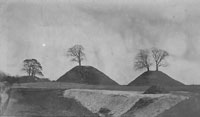
Bartlow Hills
|
|
blank |
Soldiers home from the war, and seaman released from the navy came back to find that there were no jobs for them, and their families were going hungry. Some efforts were made on a local basis to help out. One project, at Bartlow, near Haverhill, had long term effects on local archaeology which were not fully appreciated at the time. Bartlow had been long known for its Seven Hills, which were tumuli dating from the first and second centuries AD. In 1812 Sir Busick Harwood "excavated" the burial mound now referred to as number VI to provide work for the unemployed. Harwood was a Professor of Anatomy and Medicine at Cambridge University. He was known for his work on blood transfusions. He died in 1814.
A report on this dig said, "They began at the apex and digging down at great labour to the cist despoiled it of its contents, which were distributed and no account of them taken". A few of the of the less valuable items went to Saffron Walden museum where they survive.
Further excavations would take place from 1832 to 1840, and in 1865 the railway would be built through the site. Today, only three of the "seven hills" survive.
|
|
Quick links on this page
Top of Page 1700
First Suffolk turnpikes 1711
River Lark canalised 1716
Trial of Arundel Coke 1722
Kirby's Suffolk Traveller 1735
Bury to London same day 1737
Downing's map of Bury 1741
Warren's map of Bury 1748
The modern calendar 1752
New butchers' shambles 1761
Turnpike to Newmarket 1770
Warren's updated map 1776
Fornham Park enclosed 1782
The French Revolution 1789
Napoleonic Wars begin 1793
End of Bury wool trade 1800
Richard Yates's Antiquities 1805
Buck & Greene brewers 1806
Suffolk livestock 1810
|
|
1813
|
Please click here if you wish to follow our Chronicle into the Depression that followed the Napoleonic Wars.
|
Prepared for the St Edmundsbury local history project
by David Addy, 1998 to 2005.
Photography of Museum exhibits and pictures by Graham Portlock
Books consulted
"The History and Antiquities of Hawstead and Hardwick" by The Revd. Sir John Cullum Bart FRS, FSA, Second Edition 1813
"Autobiography of Arthur Young" edited in 1898 by Miss M. Betham-Edwards
"A Short History of Glemsford" by Rev Kenneth W. Glass 1962 available at Foxearth and District Local History Society
"An illustration of the Monastic History and Antiquities of the town and abbey of St Edmund's Bury" by the Reverend Richard Yates 1805
"Additions with 14 additional plates to the History and Antiquities of the abbey of St Edmund's Bury" by the Reverend Richard Yates (Posthumous publication) 1843
"The Suffolk Regiment" by Guthrie Moir, 1969
Borough of St Edmundsbury Official Guide
1976 edition.
"The Matmaker and the Magistrate: Long Melford 1885" by Richard Deeks, 1980
"Jankyn Smyth and the Guildhall Feoffees"
by Margaret Statham. 1981
"Bury St Edmunds - a photographic history" by Clive Paine
"Greene King, a Business and Family History", by Richard G Wilson, 1983
"Chevington" by Frank Cooper, 1984
"Curtsey to the Lady", by Zoe Ward, 1985
"Brandon 1789 - a village fire" J E Basham 1986
"History of Needham Market" by Hugh Paget, 1988
"A History of Suffolk" by David Dymond and Peter Northeast.
"Lavenham - Industrial Town" by A Betterton and D Dymond, Second edition 1989
"James Oakes' Diaries" in two volumes edited by Jane Fiske, 1990 and 1991
"Yesterdays Town Bury St Edmunds" by Margaret Statham, 1992
"300 Years of Quakerism in Bury St Edmunds, Suffolk," by Betty Curtain 1993
"The Culford Estate 1780-1935" by Clive Paine and the Ingham Local History Group, 1993
"Early East Anglian Banks and Bankers" by Harold Preston, 1994
"The Book of Bury St Edmunds"
by Margaret Statham. 1988 & Revised 1996
"Old Inns and Beerhouses of Bury St Edmunds" by Gerry Nixon 1996 and 2002
"Bury St Edmunds Past and Present" by Robert Halliday.
"Tithe War 1918 - 1939 the countryside in revolt" by Carol Twinch, 2001
"John Kirby's Suffolk: his maps and Roadbooks" facsimile reprint by Suffolk Records Society, volume 47, 2004
"Death Recorded - Capital Punishment in Suffolk 1732-1900" by Pip Wright, 2006
"Suffolk newspaper reports, 1720 to 1800" from Pip Wright's website
"Lost Country Houses of Suffolk", by W M Roberts, 2010
"Suffolk Book Trades", by Tony Copsey, published by Claude Cox, 2012
"The Provincial Press" - lecture by Pat Murrell, 2015.
"Catholics in Bury St Edmunds, 1660–1789" - lecture by Dr Francis Young, 2015
Online at Catholics in Bury St Edmunds
"The Gages of Hengrave" by Dr Francis Young, 2015.
Also his blog at The curse of the Greengage
"The Story of Bury St Edmunds Market Cross" by Adrian Tindall, 2024
|






























































































































































